Arte islamica e Indiana da una collezione privata romana e altre committenze

Coppia di vasi Kutahya
Turchia Ottomana, XVIII secolo
Coppia di vasi in pasta silicea invetriata, poggianti su base troncoconica con piede verso polilobato su cui poggiano due contenitori quasi cilindrici, dalla forma a urna.
L¿esterno fittamente decorato con vasi di fiori e racemi nei toni del giallo, verde, rosso, blu e viola melanzana.
Piccoli danni e mancanza ad un piede.Pair of Kutahya stem vases
Ottoman Turkey, 18th century
of glazed siliceous body, resting on a truncated cone base with a polylobed everted foot on which rest two almost cylindrical, urn-shaped containers. The exterior is densely decorated with flower vases and sprays in shades of yellow, green, red, blue and aubergine purple. Minor damage and missing part at one foot.
H 34 X l.14 cm
AGGIUDICATO

Coppa in ceramica Kutahya su alto piede
Turchia Ottomana, XVIII secolo
In ceramica invetriata, poggiante su piede circolare a cupola, stelo tubolare e coppa finale. L¿esterno dipinto nello stile classico della manifattura con elementi floreali naif ripetuti nei toni del giallo, verde rosso e blu. Impugnatura centrale a rombi sporgenti lavorati a stampo e decorati con motivo a scaglie di pesce. Marchio di manifattura (nodo infinito affiancato da due C.) dipinto in blu sottocoperta all¿interno della base. Lievi danni.A high footed Kutahya pottery cup
Ottoman Turkey, 18th century
Resting on a circular domed foot, tubular stem and finial cup. The exterior painted in the classic style of the manufacture with repeated naive floral elements in shades of yellow, green red and blue. Central handle with moulded protruding rhombuses decorated with fish scale motif. Mark of manufacture (endless knot flanked by double C) painted in blue on the inside of the base. Minor wears.
H.24 X L.12.2 cm
AGGIUDICATO

Due vasi europei in stile Iznik
Belgio, manifattura Boch Frères Keramis, seconda metà XIX- inizio XX secolo
in ceramica smaltata, a sezione esagonale con tappo a cupola. L¿esterno decorato in stile Iznik con foglie di saz, hatayi, garofani e tulipani. Marchio di manifattura in blu sottocoperta dipinto sulla base.Two European Iznik-style vases
Belgium, Boch Frères Keramis manufacture, second half of the 19th – early 20th century
glazed ceramic, hexagonal section with domed top. The exterior decorated in Iznik style with saz leaves, hatayi, carnations and tulips. Mark of manufacture at the base.
H.42 X L.21 cm
AGGIUDICATO
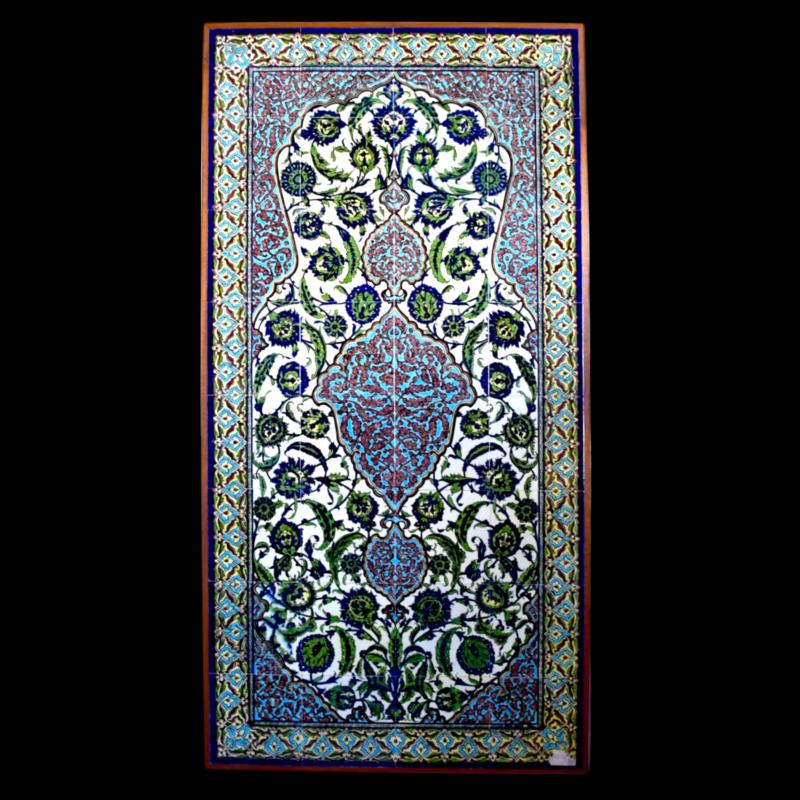
Pannello di mattonelle
Turchia, Kutahya, XX secolo
Grande pannello decorativo in ceramica smaltata e decorata in tipico stile ottomano con nicchia lobata centrale contenente hatayi e foglie di saz roteanti intorno a medaglione centrale con due pendenti a sua volta decorato con fascio di nubi su sfondo turchese. Quest¿ultima decorazione replicata nei cantonali, rifiniti con bordura di palmette ripetute. La composizione ricorda la legatura dei manoscritti.A Kutahya tile panel
Turkey, 20th century
Large decorative glazed ceramic tile panel decorated in typical Ottoman style with a central lobed niche containing hatayi and twirling saz leaves around a central medallion with two pendants in turn decorated with a bands of cloud on a turquoise background. The latter decoration is replicated in the corners, complemented by a border of repeated palmettes. The composition is reminiscent of manuscript bindings.
123×62 cm
AGGIUDICATO

Frammento di Tankard Iznik
Turchia Ottomana, Iznik, seconda metà XVI secolo
Porzione inferiore di tankard in ceramica invetriata decorata nello stile dei quattro fiori con blu e verde sotto coperta e il brillante rosso bolo armeno sopra coperta. Danni.
Fragment of an IznikOttoman
Turkey, Iznik, second half 16th century
Lower portion of a glazed ceramic tankard decorated in the four-flower style with underglaze blue and emerald green and the bright red Armenian bole overglaze.
Damages.
11,4 cm x 13,5 cm
AGGIUDICATO

Piatto Iznik
Turchia Ottomana, tardo XVI secolo
Piatto in pasta silicea dipinto simmetricamente con garofani e piante nei due emisferi che si generano con foglia di saz in posizione centrale. Reinterpretazione ottomana del motivo cinese a rocce e onde sulla tesa.
Iznik dish Ottoman
Turkey, late 16th century
Siliceous body, painted symmetrically with carnations and plants in the two hemispheres created by the saz leaf in the centre. Ottoman reinterpretation of the Chinese rock and wave motif on the brim.
D. 26 cm
AGGIUDICATO

Coppia di vasi Samson in stile Iznik
Francia, seconda metà XIX secolo
In ceramica invetriata e smaltata, poggianti su disco, corpo globulare e alto collo strombato; biansati. L¿esterno decorato nel tipico stile della manifattura Iznik con foglie di saz, hatayi e garofani nei toni del verde, rosso, e blu. Uno dei due reca marchio Samson.
Samson fu tra le manifatture europee più attive nella riproduzione delle ceramiche di Iznik, i cui modelli risalenti al XVI secolo, come nel caso di questi vasi, avevano raffinato i gusti degli appassionati occidentali che li potevano apprezzare nei musei d¿arte applicata.
Pair of Samson Iznik-style vases
France, second half 19th century
Glazed pottery, standing on a disc, globular body and high flared neck. The exterior decorated in the typical Iznik style with saz leaves, hatayi and carnations in shades of green, red and blue. One of the two vases bears the mark of Samson manufature.Samson was among the European manufactures most active in reproducing Iznik ceramics, whose designs dating back to the 16th century, as in the case of these vases, had refined the tastes of Western amateurs who could appreciate them treasured in museums of applied art.
H. 33 cm
AGGIUDICATO

Coppia di vasi europei in stile Iznik
Probabilmente Francia, seconda metà XIX secolo
In ceramica invetriata, poggianti su disco, corpo globulare e alto collo strombato; doppia ansa zoomorfa. L¿esterno decorato nel tipico stile della manifattura Iznik con piante di garofani in rosso ceralacca e foglie blu. Motivo a spirale, comunemente presente sulla tesa o sul retro degli originali di Iznik, ripetuto sul piede.
Pair of European pottery vases in the Iznik style
Probably France, second half 19th century
Glazed ceramic, resting on disc, globular body and high flared neck; double zoomorphic handle. The exterior decorated in the typical Iznik style with red bole carnation plants and blue leaves. Spiral motif, commonly found on the brim or back of Iznik originals, repeated on the foot.
H cm 3O
AGGIUDICATO

Pannello di mattonelle Kutahya firmato Mohammad ¿Abin
Turchia Ottomana, XVIII secolo
Grande pannello composto da dieci mattonelle in ceramica smaltata decorato con nicchia polilobata centrale contenente una lampada appesa, trasformata in un vaso di fiori. Il Il campo centrale circondato da mezze palmette le cui volute ospitano garofani variopinti. Bordura decorata con hamse ripetuti. La composizione vanta i colori tipici del periodo migliore della produzione di Kutahya: giallo, melanzana, verde, celeste e blu.
L¿iscrizione colophon nella zona inferiore recita: Fatto da Muhammad ¿Abin, uno degli studenti di Mohammad ¿Ali nella Kutahya Ottomana.
Lievi danni.
A Kutahya tile panel signed by Mohammad ‘Abin
Ottoman Turkey, 18th century
Large panel composed of ten glazed ceramic tiles decorated with a central poly-lobed niche containing a hanging lamp transformed into a vase of flowers. The central field surrounded by split palmettes whose volutes contain multicoloured carnations. Border decorated with repeated hamse. The composition boasts the colours typical of Kutahya’s best period of production: yellow, aubergine, green, light blue and blue.The colophon inscription at the bottom reads: Made by Muhammad ¿Abin, one of Mohammad ¿Ali’s students in Ottoman Kutahya. Minor damages.
99.5 X 59.5 cm
AGGIUDICATO

Gruppo di 15 frammenti di mattonelle in ceramica
Iran, Turchia e Spagna, XVI-XIX secolo
Include: un gruppo consistente di mattonelle da bordo Iznik, frammenti di mattonelle persiane con arabeschi, e un frammento di mattonelle ispano-moresche cuenca.
Group of 15 pottery tile fragments
Iran, Turkey and Spain, 16th-19th century
Includes: a substantial group of Iznik border tiles, fragments of Persian tiles with arabesques, and a fragment of Hispano-Moorish cuenca tiles.
L. 20 cm (the largest)
AGGIUDICATO

Coppia di mattonelle cuenca
Spagna, XVI secolo
Composizione di due mattonelle a formare una stella ad otto punte nei toni del verde ed ocra.
Difetti.
Pair of Cuenca tiles
Spain, 16th century
Composition of two tiles forming an eight-pointed star in shades of green and ochre.
Defects.
30×12 cm
AGGIUDICATO
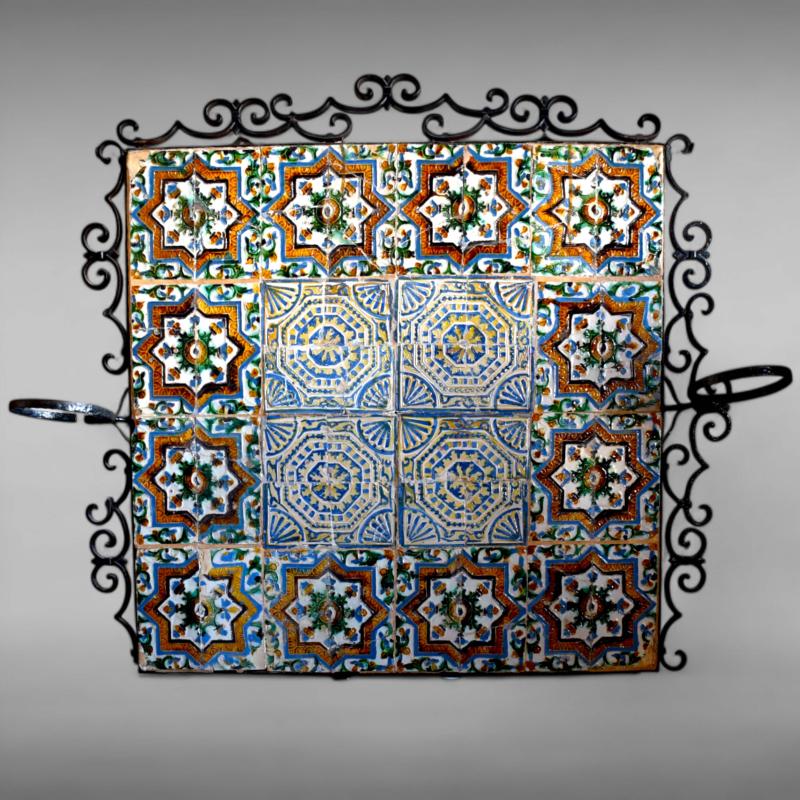
Grande pannello di mattonelle Aresta (cuenca)
Spagna, probabilmente Siviglia, XVI secolo
Composto da 16 mattonelle in ceramica entro montatura in ferro. Quattro azulejos centrali bordate da mattonelle nei toni del verde, ocra e celeste nella tecnica cuenca che prevede un alloggiamento concavo per il colore, prevenendo quindi che si mischi in cottura.
A large Aresta (cuenca) tile panel
Spain, probably Seville, 16th century
Consisting of 16 ceramic tiles within an iron frame. Four central azulejos bordered by tiles in shades of green, ochre and light blue in the cuenca technique, which provides a concave housing for the colour, thus preventing it from mixing during firing.
H. 100 X 100 cm (25 X 25 cm ciascuna mattonella)
AGGIUDICATO

Brocca in ceramica Iznik
Turchia Ottomana, XVII secolo
In pasta silicea decorata nello stile Kara Memi con tulipani, garofani e fiori di pruno sotto vetrina trasparente.
Restauri
Iznik pottery jug
Ottoman Turkey, 17th century
Made of siliceous body decorated in the Kara Memi style with tulips, carnations and plum blossom under a transparent glaze.
Restorations.
H. 23 X L. 16 cm
AGGIUDICATO
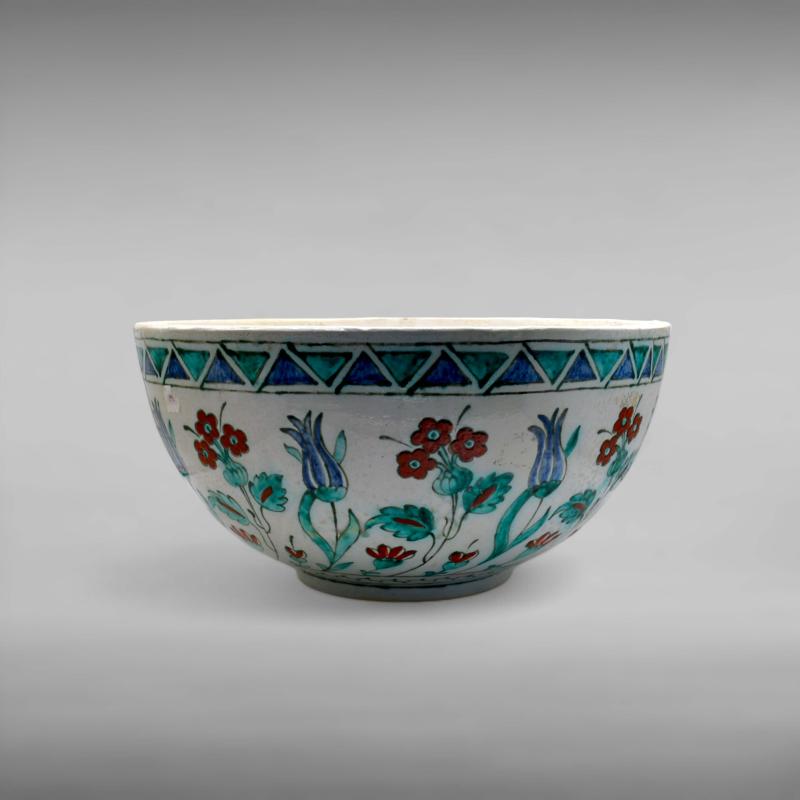
Grande ciotola in stile Iznik
Europa, XIX secolo
In ceramica invetriata, dipinta nello stile dei quattro fiori con pianta di fantasia con giacinti, tulipani, garofani e foglia di saz centrale. Banda decorativa con motivo a rocce e onde sul bordo e decorazione floreale anche sull¿esterno.
A large Iznik style pottery bowl
Europe, 19th century
Made of glazed ceramic, painted in the ‘four flowers’ style with a fantasy plant with hyacinths, tulips, carnations and a central saz leaf. Decorative band with rock and wave motif on the rim and floral decoration also on the outside.
H. 17.5 X D.35 cm
AGGIUDICATO

Piatto Iznik
Turchia Ottomana, Iznik, XVII secolo
In pasta silicea, dipinta nello stile Kara Memi con fiori nei toni del blu, verde e rosso ceralacca entro contorno nero. Piccole spirali variopinte sull¿esterno del cavetto. Danno importante.
Iznik Dish Ottoman
Turkey, Iznik, 17th century
Siliceous paste body, painted in the Kara Memi style with flowers in shades of blue, green and red within a black outline. Small multicoloured spirals on the outside of the cavetto.
Significant damage.
H. 6.5 X D.30 cm
AGGIUDICATO

Gruppo di tre mattonelle raffiguranti Ka’ba e Medina
Turchia, XX secolo
Due mattonelle in stile Iznik raffiguranti il sacro recinto di La Mecca sormontato da lunga iscrizione religiosa in naskh e pennacchio con mezze palmette. Bordura di hamse ripetuti. La terza mattonella dipinta con la moschea e il pulpito (minbar) del profeta.
Group of three tiles depicting Ka’ba and Medina
Turkey, 20th century
Two Iznik style tiles depicting the sacred precincts of Mecca surmounted by a long religious inscription in naskh and a lobed reserve containing half palmettes. Border of repeated hamse. The third tile painted with the mosque and pulpit (minbar) of the prophet.
33 X 27 cm the largest
AGGIUDICATO
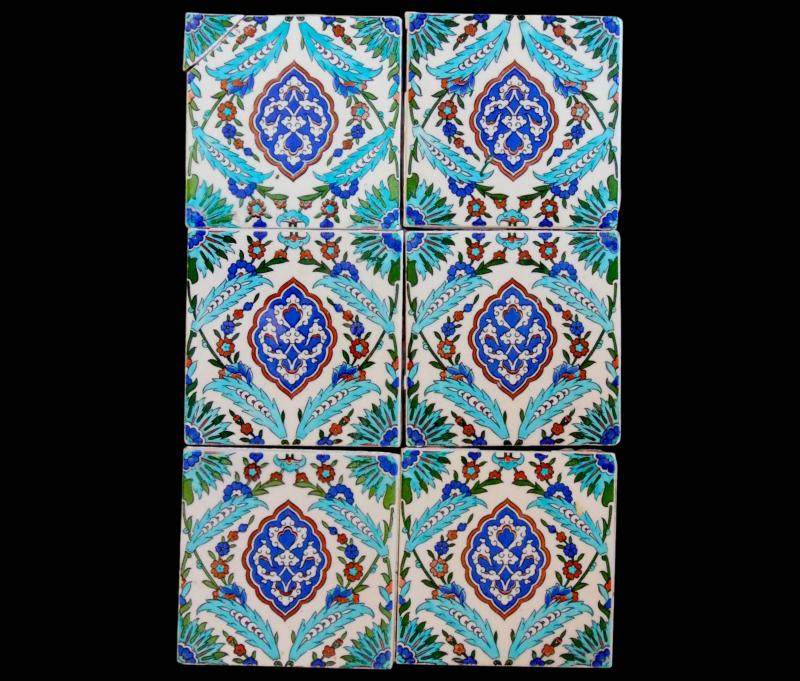
Gruppo di mattonelle in stile Iznik
Turchia, XX secolo
Mattonelle decorative, in ceramica smaltata decorata con medaglione lobato centrale contenente fascio di nubi su sfondo blu, inquadrato da quattro foglie di saz turchesi e da rami di fiori di pruno.
A group of Iznik-style tiles
Turkey, 20th century
Decorative glazed pottery tile decorated with a central lobed medallion containing a bands of clouds on a blue background, framed by four turquoise saz leaves and branches of plum blossom.
20 x 20 cm (ciascuna mattonella)
AGGIUDICATO

Grande inquadramento di finestra in ceramica smaltata
Persia Qajar, XIX secolo
Grande pannello in pasta silicea composto da 10 mattonelle, le due orizzontali formano la cornice della finestra e l¿architrave.
La decorazione è figurativa e comprende scene di corte con tematica riconducibile al ciclo del principe. Ogni personaggio è nominato nella riserva iscritta sopra la testa, trattasi dei re leggendari di cui si narra nello Shahnameh. Alla decorazione istoriata si affianca una bordura più sottile contenente elementi vegetali su sfondo verde.
Mancanze visibili, altrimenti in buone condizioni di conservazione.
Large pottery window frame Qajar
Persia, 19th century
Large, siliceous paste panel composed of 10 tiles, the two horizontal ones forming the window frame and a lintel. The decoration is figurative and includes several characters on a cobalt blue background depicting courtly scenes, a theme related to the Princely cycle. Each character is named in the reserve inscribed above its head, being them the legendary kings narrated in the Shahnameh. The historiated decoration is flanked by a thinner border containing plant elements against a green background.
Visible lackings, otherwise in good condition.
H. 154 X L.105.5 X P. 3 cm
AGGIUDICATO

Due oggetti tombak ed una teiera in ottone
Turchia Ottomana, tardo XVIII – XX secolo
Include: un contenitore (h. 13 cm) con coperchio incernierato in rame sbalzato con motivi vegetali; un piatto (diam. 15 cm) in rame dorato inciso con fiore circondato da volute vegetali e una teiera in fusione d’ottone decorata con elementi fitomorfi.
Two tombak items and a brass teapot
Ottoman Turkey, late 18th – 20th century
Includes: a container with hinged lid made of embossed copper with plant motifs; a gilded copper plate engraved with a flower surrounded by plant volutes and a cast brass teapot decorated with vegetal motifs.
D. 15 cm
AGGIUDICATO

Bacile con beccuccio versatore. Firmato in ebraico.
Domini Mamelucchi, tardo XV secolo
A sezione circolare e forma troncoconica, in rame stagnato decorato con banda contenente mezze palmette entro cartigli rettangolari alternati con medaglioni con motivo a Y. Firma in ebraico (Heim) sotto il bordo superiore.
Basin with pouring spout
Mamluk domains, late 15th century
Circular section and truncated cone shape, in tinned copper decorated with a band containing half palmettes within rectangular cartouches alternating with medallions with a Y motif.
Hebrew signature (Heim) under the upper rim.
D. 31.8 X h. 14 cm

Ciotola hammam ottomana in argento sbalzato
Balcani, XIX secolo
dalla caratteristica forma con umbone centrale, decorata con reticolo di petali disposti in arrangiamento radiale intorno a fiore centrale.
A silver embossed Ottoman hammam bowl
Balkans, 19th century
with a characteristic shape with a central protruding umbo, decorated with lattice of petals placed in radial arrangement around a central flower.
D. 19 cm
AGGIUDICATO

Ciotola hammam ottomana in argento sbalzato
Balcani, tardo XVIII secolo
dalla caratteristica forma con umbone centrale, decorata in stile barocco con fiore centrale circondato da petali contenenti elemento floreale a pianta. La parete decorata con piante sbalzate dall¿interno verso l¿esterno.
A silver embossed Ottoman hammam bowl
Balkans, late 18th century
with a characteristic shape with a central umbo, decorated in Baroque style with a central flower surrounded by petals containing a plant-like floral element. The wall decorated with reverse embossed plants from the inside outwards.
D. 24 cm
AGGIUDICATO

Piatto Khorasan selgiuchide in bronzo
Persia Orientale, XII secolo
A sezione circolare con pareti dritte e orlo everso, in bronzo inciso con tondo centrale contenente rosette con uccelli e mezze palmette agemine in argento e rame. Fine banda epigrafica in cufico sul bordo, arrangiata entro cartigli separati da medaglioni con uccelli. Il retro decorato con arpia incisa. Iscrizione benaugurale rivolta al proprietario del piatto: bi¿l-yumn al-sa¿ada wa al-¿afiya wa [¿]li-sahibih.
Provenienza:
Christie¿s Londra, 6 Ottobre 2011, Collection d¿une amateur belge, n. 28;
Esposto presso l¿Institute du Monde Arabe, Parigi, fino al 2023
Artcurial, Antiquiteis & Islamic Art, 24 Maggio 2023, Lotto 121.
A Seljuk bronze Khorasan Dish
Eastern Persia, 12th century
Circular section with straight sides and everted rim, of bronze engraved with central roundel containing rosettes with birds and half-palmettes inlaid with silver and copper wires. Fine epigraphic band in kufic on the rim, arranged within cartouches separated by medallions with birds. The reverse decorated with engraved harpy. Auspicious inscription addressed to the owner of the dish: bi’l-yumn al-sa’ada wa al-‘afiya wa […]li-sahibih.
Provenance: Christie’s London, 6 October 2011, Collection d’une amateur belge, no. 28;Exhibited at the Institute du Monde Arabe, Paris, until 2023 Artcurial, Antiquiteis & Islamic Art, 24 May 2023, Lot 121.
D. 17.8 cm

Scatola in osso con iscrizioni
India Mogul, XIX secolo
In osso di cammello, Rettangolare, con coperchio incernierato. L¿esterno scolpito con ampie iscrizioni religiose in arabo intagliate con calligrafia thuluth ed arrangiate entro cartigli delimitati da elementi vegetali stilizzati.
A Mughal style bone inscribed box
India, 19th century
Of camel bone, rectangular, with hinged lid. The exterior carved with broad religious inscriptions in Arabic carved in thuluth calligraphy and arranged within cartouches bordered by stylised plant elements.
19.3 x 11.5 x 13.4 cm
AGGIUDICATO

Coppella in vetro mosaico ¿millefiori¿
Vicino Oriente, Mesopotamia, periodo Medievale
Circolare, concava, decorata con la tecnica a mosaico nei toni del rosso, giallo, blu e verde. Questo tipo di pattern, comunemente noto come ¿millefiori¿ era molto popolare nel Vicino Oriente sin dal periodo ellenistico.
Mosaic glass ‘millefleur’ cup
Near East, Mesopotamia, Medieval period
Circular, concave, decorated with the mosaic technique in shades of red, yellow, blue and green. This type of pattern, commonly known as ¿a thousand flowers¿ was very popular in the Near East since the Hellenistic period.
D. 7.5 X h. 5.5 cm
AGGIUDICATO

Diorama della Natività in madreperla
Gerusalemme, XIX secolo
Modellino architettonico con la riproduzione della Natività. Oggetti di questo tipo venivano prodotti in Terra Santa soprattutto come souvenir di pellegrinaggio dalla terra che riunisce le tre ¿religioni del libro¿, ovvero Cristianesimo, Islam e Ebraismo.
Mother-of-pearl diorama of the Nativity
Jerusalem, 19th century
Architectural model with a reproduction of the Nativity. Objects of this type were produced in the Holy Land mainly as pilgrimage souvenirs from the land that unites the three ‘religions of the book’: Christianity, Islam and Judaism.
36×34,5×7,5 cm
AGGIUDICATO
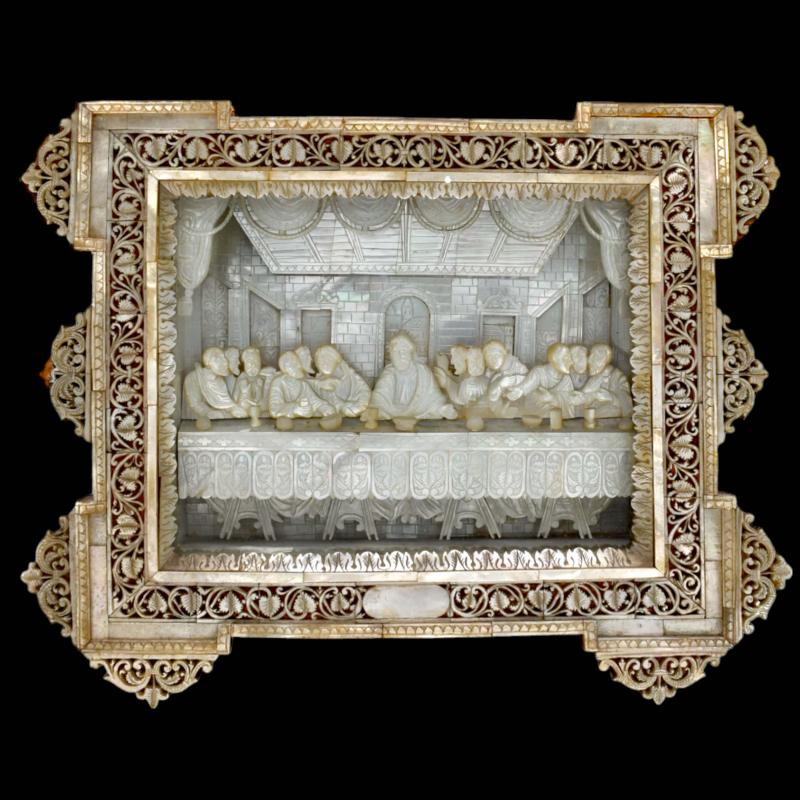
Diorama dell¿Ultima Cena in madreperla
Gerusalemme, XIX secolo
Modellino architettonico con la riproduzione dell¿Ultima Cena entro cornice lavorata a traforo con tralci vegetali. Oggetti di questo tipo venivano prodotti in Terra Santa soprattutto come souvenir di pellegrinaggio dalla terra che riunisce le tre ¿religioni del libro¿, ovvero Cristianesimo, Islam e Ebraismo.
Mother-of-pearl diorama of the Last Supper
Jerusalem, 19th century
Architectural model with a reproduction of the Last Supper within a fretworked frame with whirling plant sprays. Objects of this type were produced in the Holy Land mainly as pilgrimage souvenirs from the land that unites the three ‘religions of the book’: Christianity, Islam and Judaism.
23.5 X 30 X H. 5 cm
AGGIUDICATO

Piatto Indo-portoghese rivestito in madreperla
India Nord-Occidentale, Gujarat, XVII secolo
Circolare e con bordo verso polilobato. Rivestito di tessere di madreperla inchiodate arrangiate a formare una decorazione radiale a scaglie di pesce intorno a fiore centrale nel tondo interno.
Per un esemplare comparativo si veda Bonhams Londra, India in Art, 7 Giugno 2023, lotto 36.
Gli oggetti in madreperla creati nella regione del Gujarat sono stati importati in Europa attraverso le rotte del mercanti portoghesi già nella prima metà del XVI secolo e si sono fatti strada nelle collezioni di wunderkammer principesche. Il primo esempio documentato era conservato nelle Volte Verdi di Dresda e registrato per la prima volta in un inventario del 1586 (Seipel 2000, cat. n. 67 p.160-61).
Indo-Portuguese mother-of-pearl dish
Northwest India, Gujarat, 17th century
shallow and with a poly-lobed rim. Covered in nailed mother-of-pearl tesserae arranged to form a radial fish scale decoration around a central flower in the inner round. For a comparative example see Bonhams London, India in Art, 7 June 2023, lot 36.Mother-of-pearl objects created in the Gujarat region were imported to Europe via the routes of Portuguese merchants as early as the first half of the 16th century and made their way into princely wunderkammer collections. The first documented example was preserved in the Green Vaults in Dresden and first recorded in an inventory of 1586 (Seipel 2000, cat. no. 67 p.160-61).
D. 20 cm
AGGIUDICATO

Scatola Indo-Portoghese in legno e madreperla
India Nord-Occidentale, Gujarat, XVII-XVIII secolo
dalla rara forma di cofanetto cilindrico con tappo a cupola, simile a una pisside, rivestito con tessere di madreperla inchiodate. La sommità del tappo decorata con tessere in arrangiamento floreale.
Gli oggetti in madreperla creati nella regione del Gujarat sono stati importati in Europa attraverso le rotte del mercanti portoghesi già nella prima metà del XVI secolo e si sono fatti strada nelle collezioni di wunderkammer principesche. Il primo esempio documentato era conservato nelle Volte Verdi di Dresda e registrato per la prima volta in un inventario del 1586 (Seipel 2000, cat. n. 67 p.160-61).
An Indo-Portoguese mother-of-pearl round box and cover
North-Western India, Gujarat, 17th-18th century
in the rare form of a cylindrical case with a domed lid, similar to a pyxis, covered with nailed mother-of-pearl tiles. The top decorated with tiles in a floral arrangement. Mother-of-pearl objects created in the Gujarat region were imported to Europe via the routes of Portuguese merchants as early as the first half of the 16th century and made their way into princely wunderkammer collections. The first documented example was preserved in the Green Vaults in Dresden and first recorded in an inventory of 1586 (Seipel 2000, cat. no. 67 p.160-61).
H. 16 X D. 11.5 cm
AGGIUDICATO

Cofanetto Indo-portoghese in madreperla
India Nord-Occidentale, Gujarat, XVIII secolo
Rettangolare, poggiante su quattro piedi e con coperchio bombato incernierato con elementi metallici. Decorato con tessere di madreperla in arrangiamento geometrico: triangolari a formare delle esagoni e stelle all¿esterno; rettangolari e quadrate all¿interno.
Indo-Portuguese mother-of-pearl casket
Northwest India, Gujarat, 18th century
Rectangular, resting on four feet and with a domed lid with metal hinges. Decorated with mother-of-pearl tiles in geometric arrangement: triangular to form hexagons and stars on the outside; rectangular and square on the inside.
20 X 14 cm
AGGIUDICATO

Set da tea con incrostazioni in corallo e turchese
Turchia Ottomana, Balcani, XIX secolo
In argento sbalzato, dorato e parzialmente lavorato a filigrana, set composto da 9 porta tazze (zarfs h. 5 X diam. 6 cm), teiera (h. 18 cm) centrale decorata con racemi a sbalzo e vassoio. Ogni componente del set è decorato con incrostazioni di coralli e turchesi e ognuno dei dieci alloggiamenti sul vassoio presenta un¿iscrizione in arabo, alternata con con una stella a sei punte e pseudo thughra sultaniale in posizione centrale.
Iscrizione: Al ¿Alim (L¿onnisciente)
An Ottoman Tea set with coral and turquoise incrustations
Balkans, 19th century
In embossed, gilded and filigree silver, set comprising nine cup holders (zarfs), central teapot decorated with embossed racemes and tray. Each component of the set is decorated with coral and turquoise encrustations, and each of the ten holders on the tray has an Arabic inscription, alternating with a six-pointed star and pseudo sultanial thughra in a central position. Inscription: Al ‘Alim (The Omniscient)
D. 40 cm
AGGIUDICATO
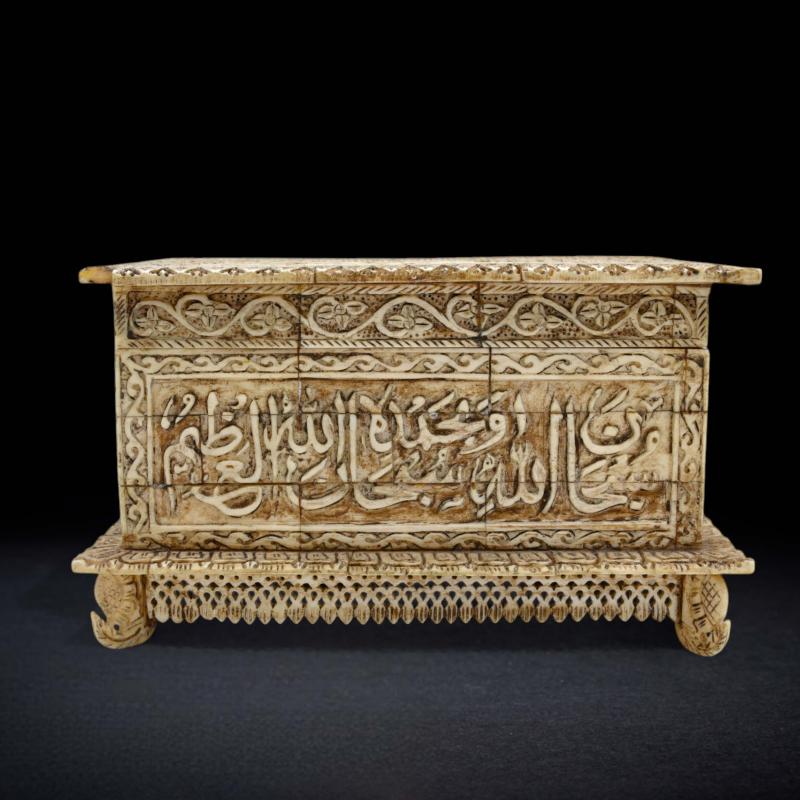
Cofanetto in osso
India Mogul, XIX secolo
In legno ricoperto di osso di cammello intagliato con fitti motivi vegetali ed iscrizioni religiose in arabo entro riserve circolari.
A Mughal style bone casket
India, 19th century
Made of several bone palques with dense plant motifs and religious inscriptions in Arabic within circular reserves.
H. 11 X l. 19 X P. 14 cm
AGGIUDICATO
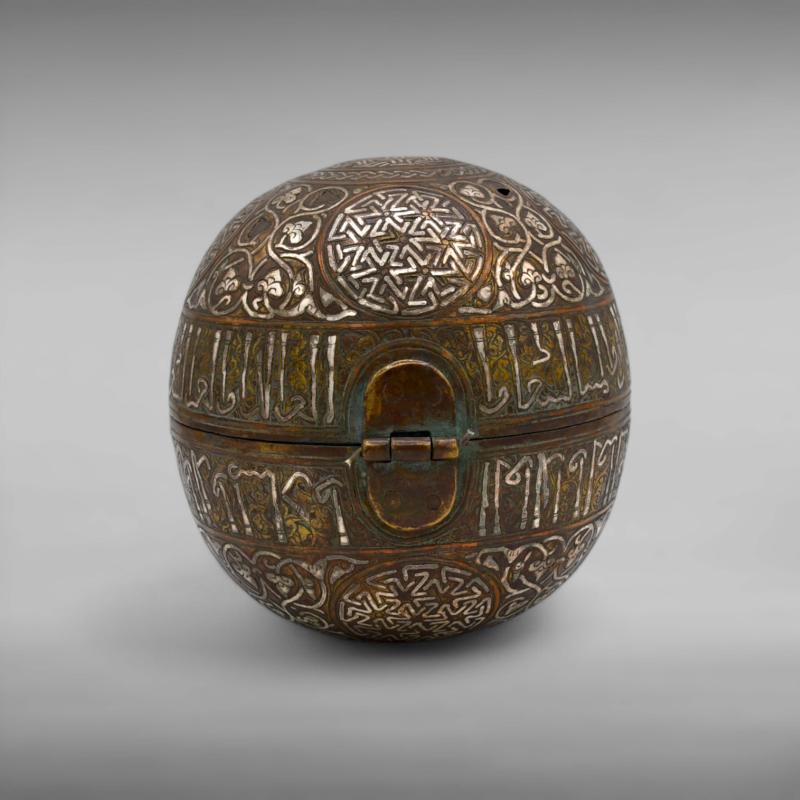
Scaldamani Cairoware
Egitto, inizio XX secolo
sfera bivalve, in metallo lavorato decorato con intarsi in ottone, rame e argento con i classici motivi del repertorio mesopotamico e mamelucco: motivo a Y, ruote dentate, foglie di vite e ampie iscrizioni in thuluth. Oggetto decorativo, non ha fori per il passaggio delle essenze.A Cairoware hand warmer
Egypt, early 20th century
A metal bivalve sphere, decorated with brass, copper and silver wire inlays with classic motifs from the Mesopotamian and Mamluk repertoire: Y motif, cogwheels, vine leaves and large inscriptions in thuluth calligraphy. Decorative object, it has no holes for the passage of the smoke.
H. 12 X D. 12 cm
AGGIUDICATO

Due indicatori di Qibla in metallo
Iran, XIX secolo
Due strumenti scientifici per identificare la direzione della preghiera verso La Mecca. Uno rettangolare in fusione d¿ottone inciso e decorato con arabeschi e indicatore zoomorfo; l¿altro circolare in bronzo (diam. 16.5 cm). Entrambi incisi con i pianeti e i mesi e le città iraniane. Two metal Qibla indicators
Iran, 19th century
Two scientific instruments for identifying the direction of prayer towards Mecca. One rectangular in cast brass engraved and decorated with arabesques and a zoomorphic indicator; the other circular (diam. 16.5 cm) in bronze. Both engraved with the planets and months and Iranian cities.
14 X 10 cm

Poltrona pieghevole in stile Nasride
Spagna, XIX secolo
Poltrona pieghevole modello savonarola in legno con intarsi geometrici in osso, legni di diverse essenze e radica. Seduta e schienale in cuoio stampato e dipinto con motivi floreali, cartigli con iscrizione in arabo e stemmi liberamente ispirati a quello Nasride.Nasride-style folding armchair
Spain, 19th century
Savonarola-style folding armchair made of wood with geometric inlays of bone, different woods and burlwood. Printed and painted leather seat and back with floral motifs, cartouches with Arabic inscription and coats of arms freely inspired by the Nasride one.
94 X 65,5 X 50 cm
AGGIUDICATO
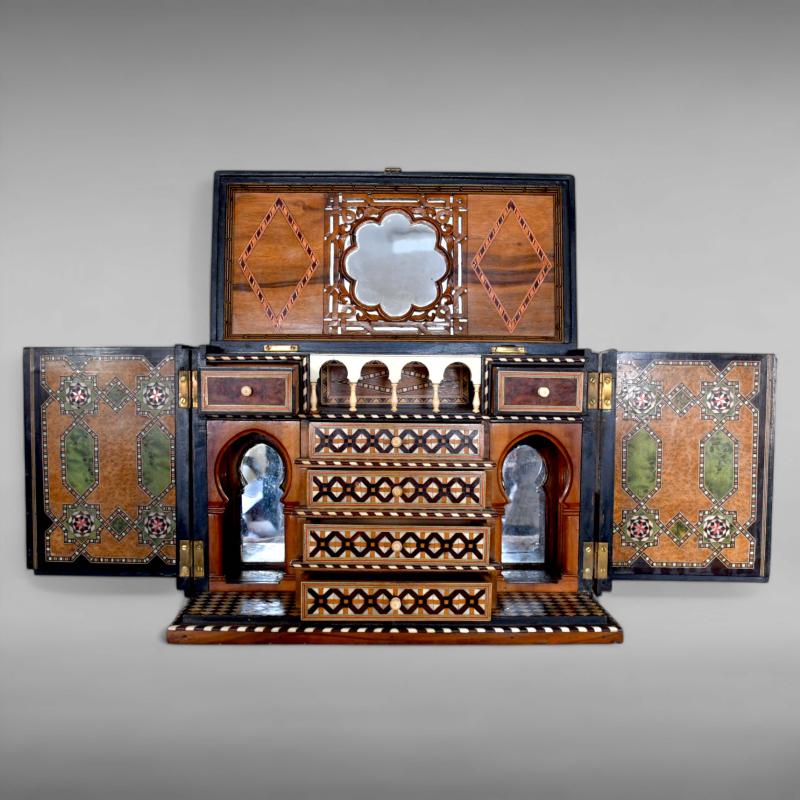
Cofanetto Granada microintarsio
Spagna, XIX secolo
Cofanetto da tavolo in legno intarsiato con osso, legni di diverse essenze e radica. Apribile, l¿interno mostra sei cassetti, due nicchie laterali con specchio e scomparto centrale delimitato da arcate architettoniche in miniatura. Coperchio incernierato con specchio centrale entro rosone intagliato. L¿esterno e gli sportelli recano il classico motivo geometrico Nasride ripetuto. Lievi danni. Per un esemplare comparativo si veda Christie’s Londra, Art of the Islamic and Indian World Including rugs and Carpets, 25 Aprile 2024, lotto 20.
A Grenada marquetry casket
Spain, 19th century
Jewelry box made of wood inlaid with bone, different woods and burl wood. Openable, the interior shows six drawers, two side niches with mirror and central compartment bordered by miniature architectural arches. Hinged lid with central mirror within carved rosette. The exterior and doors bear the classic geometric Nasrid motif repeated. Small damages.For comparison cfr. Christie’s London, Art of the Islamic and Indian World Including rugs and Carpets, 25 Aprile 2024, lot 20.
26,5 X 18,5 X 35,5 cm
AGGIUDICATO
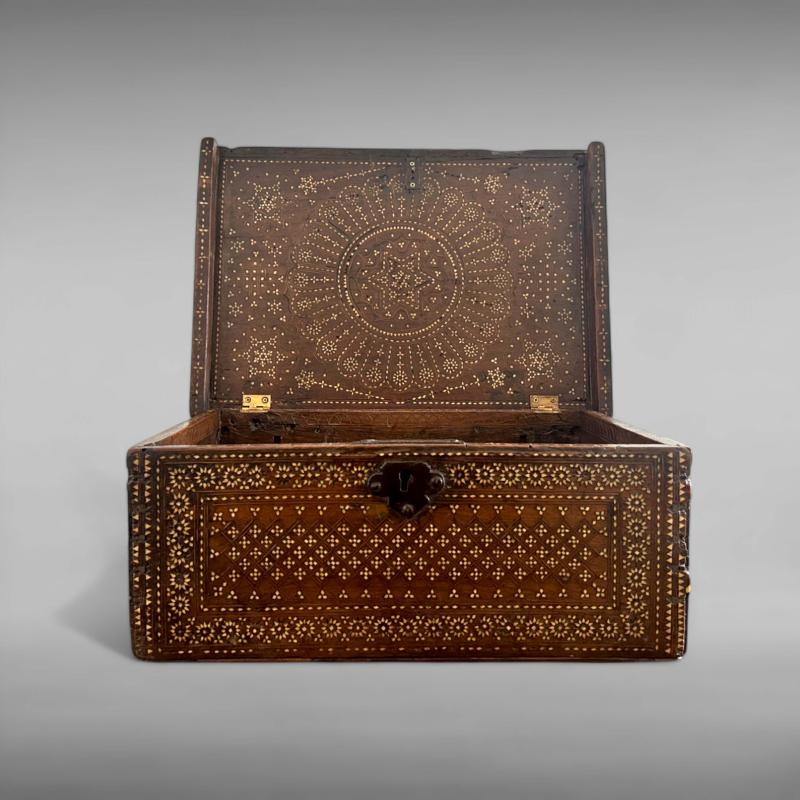
Baule Ispano Moresco in legno e osso
Spagna, XVI – XVII secolo
Rettangolare, con coperchio incernierato. Le pareti esterne decorate con intarsi geometrici in osso entro riserve rettangolari, il coperchio decorato su ambo i lati con incisioni ed intarsi in arrangiamento floreali e radiali.
Per approfondimento si veda Caliphs and Kings: the art and influence of Islamic Spain – selections from the Hispanic Society of America, New York, 2004, cat. 86, p. 162.
An Ispano-Moresque Mudejar wood and bone inlaid chest
Spain, 16th – 17th century
Rectangular, with hinged lid. The outer walls decorated with geometric bone inlays within rectangular cartouches, the lid decorated on both sides with carvings and inlays in floral and radial arrangements. To deepen the subject cfr. Caliphs and Kings: the art and influence of Islamic Spain – selections from the Hispanic Society of America, New York, 2004, cat. 86, p. 162.
44,5 X 31 X 17,5 cm
AGGIUDICATO

Scatola da gioco Mudejar in legno e osso
Spagna, XVI secolo
Rettangolare con coperchio incernierato, intarsiato a micromosaico con tessere in osso, che formano decorazione tradizionale di stelle intrecciate, arabeschi stilizzati, tondi e motivi geometrici che ricoprono ogni lato del cassone. Il piano è decorato con una scacchiera. Un oggetto simile è passato in asta da Sotheby’s Londra lo scorso 7 ottobre (lotto 323) e un altro si trova al Victoria and Albert Museum (Acc. n. 7224-1860).
A Mudejar wood and bone box
Spain, 16th century
Rectangular chest with hinged lid, inlaid with bone micromosaic tesserae, forming traditional decoration with starbursts, stylised arabesques, roundels and geometric patterns which cover every side of the chest. The top is decorated with a chessboard. A similar item was auctioned by Sotheby’s London last 7th October (lot 323), and another one is located in Victoria and Albert Museum (Acc. no. 7224-1860).
26 X 66,5 cm X 36 cm
AGGIUDICATO

Cofanetto in legno e osso
India colonie portoghesi, XIX secolo
Rettangolare, in legno intarsiato con riserve circolari intrecciate, intervallate da fiori cruciformi e rosoni sui bordi. Il fronte ribaltabile scopre sei cassetti con fronte decorato con spirali geometriche.An Indo-Portuguese wood and bone casket
India, 19th century
Rectangular, inlaid wood with interlaced circular reserves, interspersed with cruciform flowers and rosettes on the edges. The folding front reveals six drawers with fronts decorated with geometric spirals.
25 X 17 X 14 cm
AGGIUDICATO
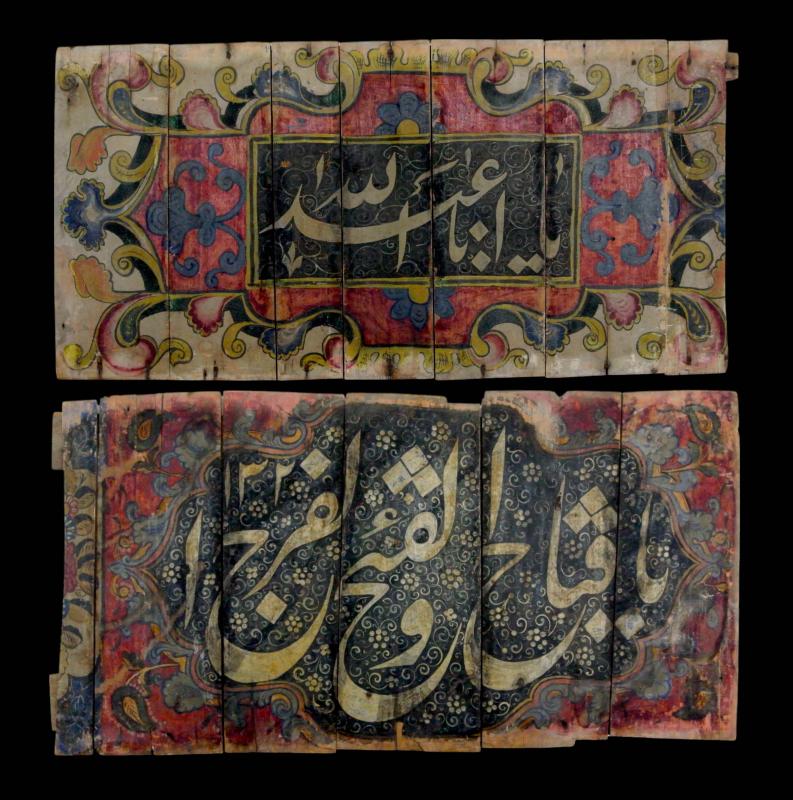
Coppia di pannelli calligrafici in legno dipinto
Iran Qajar, XIX secolo
Forse sovrapporte, in legno composito, decorati con iscrizione in calligrafia nasta¿liq centrale, su sfondo rosso e verde.
Iscrizione:
Ya Fattah alfatahu val faraj (Colui che apre la porta)
Ya aba abdallah (saluto al figlio di Dio, comunemente associato ad ¿Ali in contesto sciita)
Pair of painted wooden calligraphic panels Qajar
Iran, 19th century
Possibly overlaid, made of composite wood, decorated with an inscription in central nasta’liq calligraphy, on a red and green background. Inscription: Ya Fattah alfatahu val faraj (He who opens the door) Ya aba abdallah (greeting to the son of God, usually associated to ‘Ali in Shia context)
47 X 88 cm
AGGIUDICATO
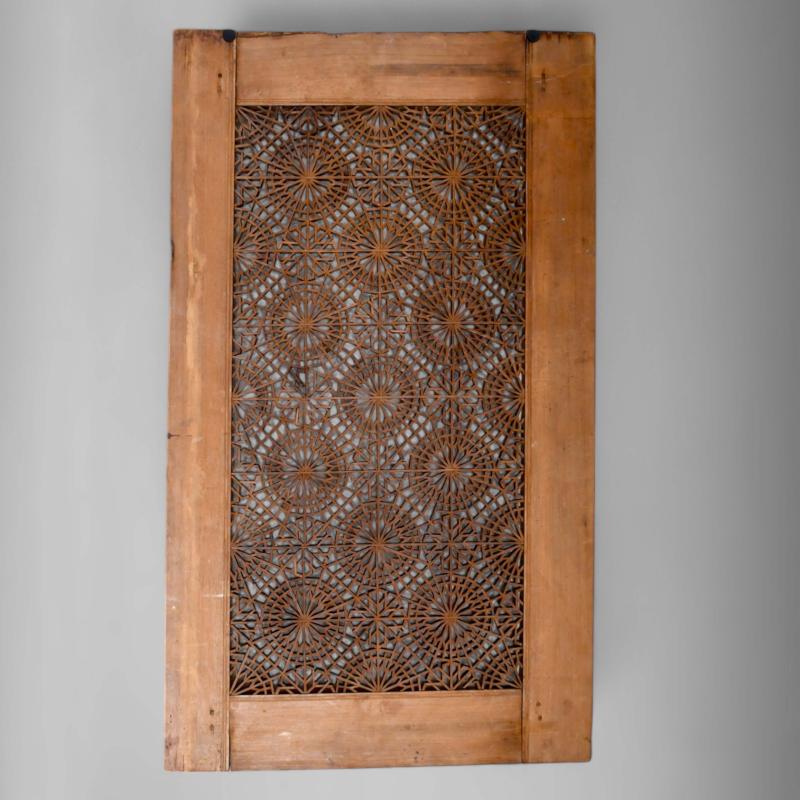
Jali in legno traforato
India o Pakistan, XVIII -XIX secolo
Placca in legno di conifera lavorato a traforo con elementi geometrici affiancati a formare un pattern infinito di rosoni. Provenienza: Riferito che fu venduta da Sotheby’s, Arts of the Islamic World,28 April 2004 Lotto 174
A Mughal style wooden fretwork Jali
India or Pakistan, 18th – 19th century
Openworked conifer wood plaque with geometric elements arranged to form an infinite pattern of rosettes.
Provenance: by repute cfr. Sotheby’s, Arts of the Islamic World,28th April 2004, Lot 174.
109 X 63,5 cm

Piccola Jali in pietra
India Settentrionale, XVIII-XIX secolo
Copertura per finestra lavorata a traforo con reticolo di rombi in posizione centrale, circondati da elementi cruciformi ripetuti. Bordo inciso con frecce. A latticed decorated stone Jali
Northern India, 18th-19th century
Openwork window cover with diamond shaped central pattern, surrounded by repeated cruciform elements. Edge engraved with arrows.
H. 41 X L. 45 X P. 7.5 cm

Porta Turbante (Kavuvklu) in legno intarsiato
Siria, XX secolo
dalla forma architettonica, in legno intagliato e decorato con intarsi floreali in madreperla e filo d¿argento.
A mother-of-pearl inlaid Turban stand (Kavuvklu)
Syria, 20th century
architectural form, carved wood decorated with floral inlays in mother-of-pearl and silver thread.
H. 88.5 cm
AGGIUDICATO
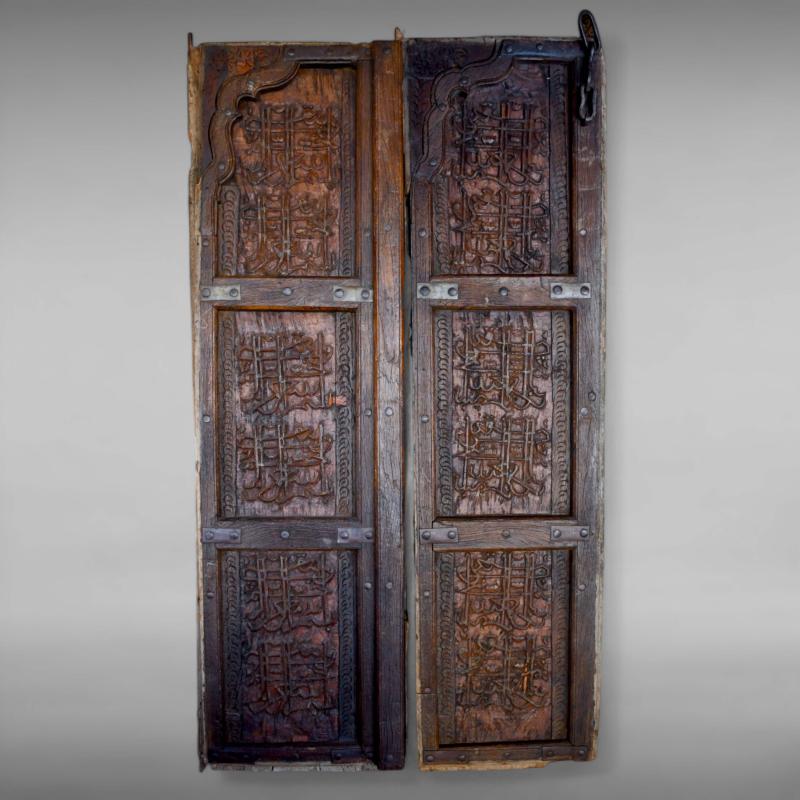
Porta in legno con iscrizioni
Arabia Saudita (?) XIX secolo
Due ante in legno suddiviso in tre scomparti sovrimposti, ognuno contenete doppia iscrizione entro sottile bordura di elementi vegetali intagliati sui bordi. Iscrizione: Bi-ismi ‘llahi al-Rahmani al-Rahim ripetuta. Wooden door with inscriptions
Saudi Arabia (?) 19th century
Two wooden panels forming a door, divided into three overlapping compartments, each containing double inscription within a thin border of carved plant elements on the edges. Inscription: Bi-ismi ‘llahi al-Rahmani al-Rahim repeated.
H. 163 X L.44 cm (ciascuna anta)
AGGIUDICATO
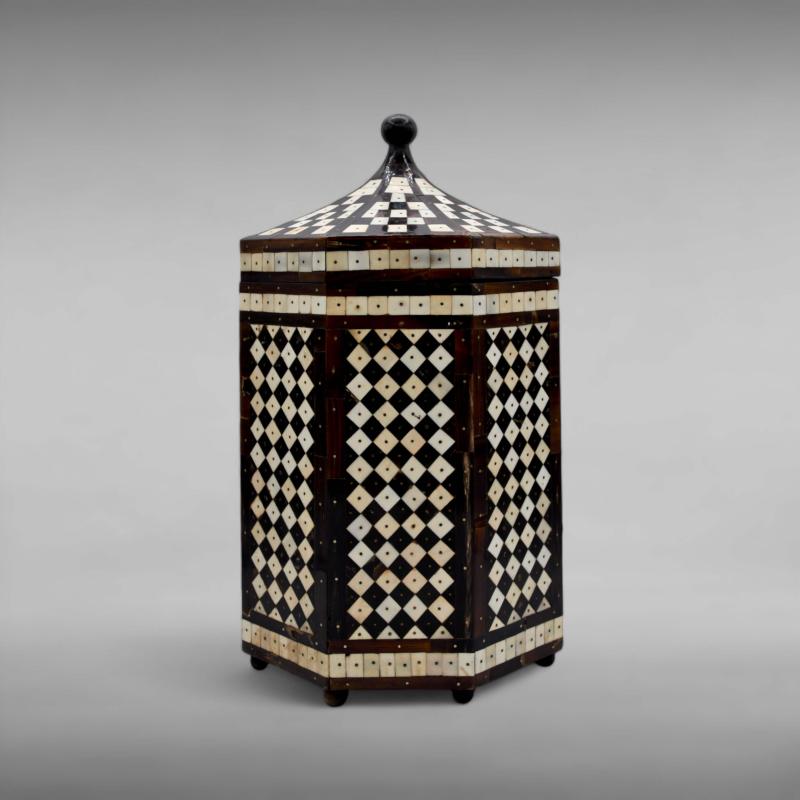
Scatola ottagonale Ottomana
Turchia, XIX secolo
Poggiante su piedini, in legno rivestito di tessere di osso bovino di diverso colore arrangiate a formare decorazione geometrica romboidale su ogni lato del contenitore e quadrata sul tappo a cupola terminante con pomello sferico.
L¿utilizzo di scatole a sezione ottagonale risale all¿epoca Romana e Bizantina e venne ripreso in ambito ottomano con la funzione principale di contenere oggetti religiosi tra cui: il sacro Corano (a titolo d¿esempio cfr. Turkish and Islamic art Museum Istanbul, Acc. no. 2, 3) o contenitori di reliquie (a titolo d¿esempio cfr. inv. no. 21/391, in H. Aydin, Hirka-i Saadet Dairesi ve Mukaddes Emanetler, Kaynak, Istanbul, 2004, p. 108) Ottoman octagonal box
Turkey, 19th century
Resting on feet, made of wood covered with differently coloured bovine bone tesserae arranged to form rhomboidal pattern decorations on each side of the box and square on the domed top ending in a spherical knob. The use of octagonal boxes dates back to the Byzantine period and was revived in the Ottoman era with the main function of containing religious objects including: the Holy Qur’an (for an example see Turkish and Islamic art Museum Istanbul, Acc. no. 2, 3) or containers of relics (as an example see inv. no. 21/391, in H. Aydin, Hýrka-i Saadet Dairesi ve Mukaddes Emanetler, Kaynak, Istanbul, 2004, p. 108)
19 X 30 cm
AGGIUDICATO

Grande frammento di stucco Nasride policromo
Spagna Meridionale, Granada, seconda metà del XIV secolo
Grande frammento di stucco modellato con reticolo geometrico a formare decorazione caleidoscopica di quadrati e stelle multipunte. All’interno di questi lazo geometrici stellati bordati di bianco si trovano atauriques (arabeschi) intrecciati a bassorilievo mentre, la posizione centrale di questo frammento è occupata da decorazione composta da due quadrati sovrapposti contenenti fiore con petali scavati, a conca. Consistenti tracce di policromia e mancanze negli angoli. Il disegno geometrico dell’esemplare qui proposto si riscontra in Spagna almeno già dal periodo Califfale (cfr. claustra al museo archeologico di Cordoba, Acc. no. 488).
Decorazioni con simile impianto decorativo possono essere ricondotte al palazzo dei Leoni nel complesso dell’Alhambra, celebre architettura Granadina.
Gli atauriques negli stucchi dell’Alhambra si trovano come decorazione a se stante o come riempimento e in diverse varianti. La tipologia osservabile in questo frammento è simile ad un decoro ora al V&A Museum di Londra, Acc. no. A.171-1919.
A dispetto della sua apparente semplicità e scarsa qualità, lo stucco veniva usato in epoca nasride con grande maestria tecnica, giungendo a costituire la cifra distintiva dell’Alhambra, pur nella sua infinita varietà di disegni ornamentali. Nel primo periodo nasride queste decorazioni venivano scolpite sul posto (tecnica naqch hadida), dall’epoca di Muhammad III (1302) la tecnica si standardizza e si diffonde l’adozione di stampi. Quanto alla rifinitura, alcuni fregi erano semplicemente intonacati, mentre i più pregiati venivano rifiniti in policromia con pigmenti minerali spesso nei toni del blu, rosso, nero e verde, talvolta con aggiunte metalliche in oro e argento.
Una sorta di antologia di queste decorazioni è stata stilata da Owen Johns nella sua Grammar of Ornaments pubblicato per la prima volta a Londra nel 1856. Qui gli stucchi dell’Alhambra compaiono tra i decori tipici dell’arte moresca.
Per approfondimenti si veda Puertas Fernàndez, A. ‘The Alhambra’ Vol. 1., Saqi Books, 1997.
Garcia Bueno, A., and Medina Flòrez V. J., The Nasrid Plasterwork at ‘qubba Dar al-Manjara l-kubra’ in Granada: Characterisation of materials and techniques, Journal of Cultural Heritage 5, 2004.
A large fragment of polychrome Nasrid stucco
Southern Spain, Granada, second half of the 14th century
Large stucco fragment moulded with a geometric lattice to form a kaleidoscopic decoration of multipointed squares and stars. Within these geometric lazos bordered in white are atauriques (arabesques) interwoven in bas-relief, while the central position of this fragment is occupied by decoration composed of two overlapping squares containing a flower with hollowed-out concave petals. Consistent traces of polychromy and lacking in the corners. The geometric design of this frieze is reminiscent of the Caliphal period (cfr. claustra at the Archeological Museum of Cordoba, acc. no. 488).
Decorations with a similar decorative scheme are possibly found in the Palace of the Lions in the Alhambra complex, famous moorish architecture in Granada.
Atauriques in the stuccoes of the Alhambra are found as a stand-alone decoration or as a filler and in different variants. The type observed in this fragment is similar to a decoration now in the V&A Museum in London, Acc. no. A.171-1919.
In spite of its apparent simplicity and poor quality, stucco was used in the Nasrid period with great technical skill, coming to constitute the hallmark of the Alhambra, even in its infinite variety of ornamental designs. In the early Nasrid period, these decorations were carved in situ (naqch hadida technique), from the time of Muhammad III (1302) the technique became standardised and the adoption of moulds became widespread. As for the finishi
Per visio
AGGIUDICATO

Elementi di porta in legno intagliato
Medio Oriente, forse Bahrain, tardo XIX secolo
Coppia di pannelli rettangolari, in legno intagliato con calligrafia corsiva nel tondo centrale entro riserva quadrata con quattro cantonali a motivo vegetale.
Chiodatura e borchie in ferro.
Carved wooden door elements
Middle East, possibly Bahrain, late 19th century
Pair of rectangular panels, carved wood with cursive calligraphy in the central roundel within a square reserve with four plant-patterned corner decoration. Iron nailing and studs.
73 X 79.8 cm

Stele in marmo bianco
Forse turchia Ottomana, XVIII secolo
placca rettangolare con finale ad arco, il fronte lavorato a bassorilievo con pianta di vite in disposizione simmetrica rispetto all¿asse centrale. I grappoli d¿uva contribuiscono alla simmetria altrimenti alterata dall¿andamento ondulato del ramo.
L¿utilizzo del marmo bianco nella zona risale a tempi antichi, tuttavia stele e lapidi in marmo sono diffusi in Turchia sin dai tempi dei Seljuk di Rum.
White marble stele
Ottoman Turkey, 18th century
Rectangular slab with arched finial, the front sculpted in bas-relief with vine plant in symmetrical arrangement around the central axis. The grapes contribute to the symmetry otherwise altered by the undulating course of the branch. The use of white marble in the area dates back to ancient times, however marble stelae and tombstones have been common in Turkey since the Seljuk of Rum.
H. 81 X 21 X 4 cm
AGGIUDICATO

Pannello in legno intarsiato
Egitto, forse XVIII secolo
Pannello rettangolare, probabilmente in origine parte di una porta o di un¿anta, il fronte suddiviso in tre scomparti, quello centrale più grande intagliato con incastri geometrici delimitati da intarsi in osso contenenti arabeschi intrecciati. Intaglio di mezze palmette entro cartiglio rettangolare bordato con elementi fitomorfi anche nelle due formelle che affiancano il pannello centrale.
A carved wooden panel
Egypt, possibly 18th century
Rectangular panel, probably originally part of a door or a plaque, the front divided into three compartments, the larger central one carved with geometric inlays bordered by bone inlays containing interlaced arabesques. Split palmettes carved within a rectangular cartouche bordered with vegetal elements also in the two smaller plaques flanking the central panel.
H. 8.8 X L. 41 X P. 4 cm
AGGIUDICATO

Pannello composito in legno
Marocco, XIX secolo
Composto da tre placche, di cui una doppia, in legni di essenze diverse, intagliati con stelle geometriche di diverse misure. Decorazioni simili sono comuni in Spagna e Nord Africa, soprattutto sulle decorazioni parietali di mattonelle che formano composizione caleidoscopiche come queste.
A composite wood panel
Morocco, 19th – 20th century
Composed of three plaques, one of which is double, of different wood types, carved with geometric stars of different sizes. Similar decorations are common in Spain and North Africa, especially on wall decorations of tiles forming kaleidoscopic compositions such as these.
H. 91 X L. 43.5 cm
AGGIUDICATO

Due portapenne (Qalamdam) persiani in papier machè.
Iran, XIX-XX secolo
Due portapenne di diverse misure, il più piccolo decorato en grisaille con fiori e uccelli su sfondo ocra, firmato e datato 1321 AH (1942 AD). Il più grande dipinto con motivo figurativo ed iscrizione in persiano entro cartigli lobati.
Two Persian papier machè pen cases (Qalamdam)
Iran, 19th – 20th century
Two pen holders of different sizes, the smaller decorated en grisaille with flowers and birds on a beige background, signed and dated 1321 AH (1942 AD). The larger painted with a figurative motif and inscription in Persian within lobed cartouches.
H. 6.5 X L. 36 cm (the largest)
AGGIUDICATO
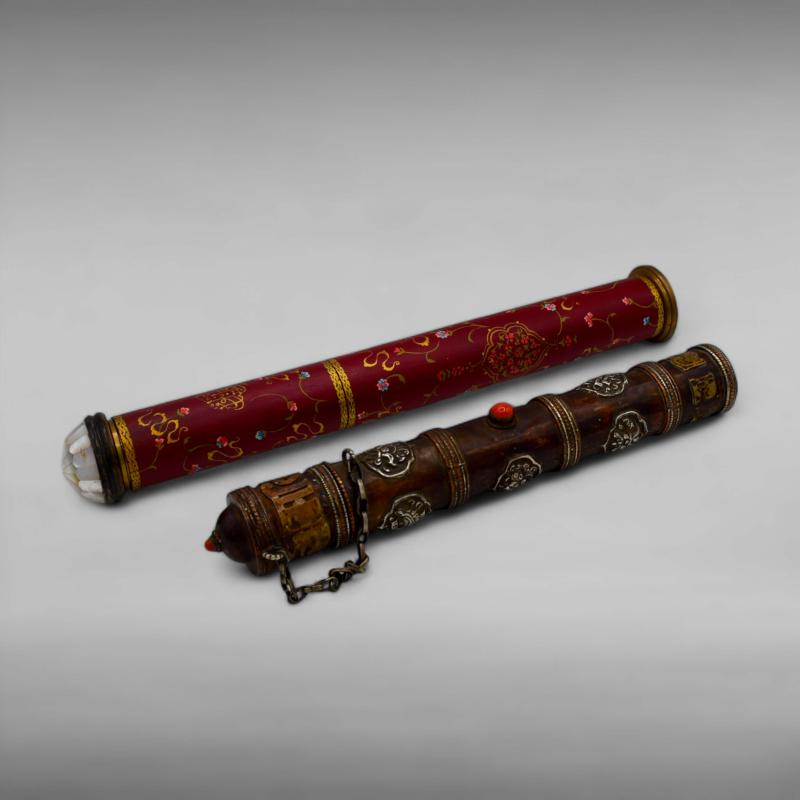
Due porta inchiostro tubolari (Kubular)
Persia e Tibet, XIX – XX secolo
Il persiano in ottone ricoperto di cartone decorato con motivi floreali, fascia di nubi e firmato ¿Soltani¿. Tappo a cupola ricoperto di tessere in madreperla. L¿altro in argento sbalzato, decorato con gli emblemi buddisti ed incastonato con corallo.
Two tubular inkwells (Kubular)
Persia and Tibet, 19th – 20th century
The Persian one made of brass covered with cardboard decorated with floral motifs, cloud bands and signed ‘Soltani’. Domed stopper covered with mother-of-pearl micro-tiles. The other of embossed silver, decorated with Buddhist emblems and set with coral.
L. 32.5 cm (the largest)
AGGIUDICATO

Portapenne in legno e madreperla
Turchia o Iran Settentrionale, XIX secolo
Accessorio da scriba rettangolare, con coperchio incernierato e ribaltabile, decorato con intarsi in abalone con arabeschi intrecciati sui tre lati ed iscrizione recitante la bismillah sul coperchio.
A wood and mother-of-pearl inlaid penholder
Turkey or Northern Iran, 19th century
Rectangular scribe’s accessory, with a hinged and flip-top lid, decorated with abalone inlays with interlaced arabesques on three sides and an inscription reading bismillah on the lid.
L. 27 cm
AGGIUDICATO

Scatola Persiana in legno intarsiato
Iran Qajar, XIX secolo
Rettangolare, decorata a marchetteria con la tecnica Khatamkari che prevede l¿utilizzo di micro intarsi in osso e metalli. La scatola si apre in due metà uguali. Lunga iscrizione di carattere poetico (versi dalle poesie di Hafez), in stile calligrafico nasta¿liq sul coperchio e entro un cartiglio sopra la chiusura.
A Persian marquetery khatamkari box Qajar
Iran, 19th century
Rectangular, decorated with the khatamkari technique involving micro inlays of bone and metal. The box opens in two equal halves. Long poetic inscription (verses from the poems of Hafez) written in nasta’liq script on the lid and within a cartouche above the clasp.
21 X 66 X 25 cm
AGGIUDICATO

Baule da calligrafo in legno
Impero ottomano o India, XIX secolo
Rettangolare con cassetto centrale con finiture in metallo. L¿esterno intarsiato in osso e madreperla con vasi di fiori liberamente disposti entro grandi cartigli con cantonali. Ogni lato reca una stella a sei punte con intarsi in madreperla. Il cassetto mostra iscrizione in caratteri arabi che recita: Ya Fattah (Colui che apre), Ya Razzaqh (Colui che nutre), … Vassalamah (formula di saluto).
A wooden inlaid calligrapher’s chest
Ottoman Empire or India, 19th century
Rectangular with central drawer with metal fittings. The exterior with bone and mother-of-pearl inlaid decoration of vases of flowers arranged within large cartouches with corner decoration. Each side bears a six-pointed star inlaid with mother-of-pearl. The drawer shows an inscription in Arabic characters that reads: Ya Fattah (the One who opens), Ya Razzaqh (the One who feeds), … Vassalamah (salutation).
35.5 cm X 68 cm X 35.5 cm
AGGIUDICATO

Portapenne (Qalamdam) in legno e madreperla
Probabilmente India, Gujarat, XVII secolo
Accessorio da scrivania in legno intarsiato con madreperla a formare mezze palmette intrecciate sui lati. Il coperchio, incernierato e ribaltabile, decorato con bismillah in stile calligrafico nasta¿liq affiancata da due stelle ad otto punte. La tecnica di intarsio della madreperla è tipicamente indiana, mentre l¿ambito islamico e la calligrafia in stile persiano collocano l¿oggetto nella produzione dei sultanati del subcontinente.
Per un esemplare comparativo si veda Skelton R., The Indian Heritage, Court Life and Arts under Mughal Rule, Londra, Victoria and Albert Museum, 1982, cat. n. 549 p. 162.Un altro esemplare con simile apparato decorativo è conservato alla David Collection, Copenhagen, Acc. no. 35/1976.
A wood and mother-of-pearl inlaid scribe box
Probably India, Gujarat, 17th century
Wooden desk accessory inlaid with mother-of-pearl forming intertwined split palmettes on the sides. The hinged, flip-up lid is decorated with bismillah in the nasta’liq calligraphic style flanked by two eight-pointed stars. The nailed inlay technique of the mother-of-pearl is typically Indian and the Islamic and Persian-style calligraphy place the object in the production of the sultanates of the subcontinent. For comparison cfr. Skelton R., The Indian Heritage, Court Life and Arts under Mughal Rule, Londra, Victoria and Albert Museum, 1982, cat. n. 549 p. 162. Another similarly decorated pencase is treasured at the David Collection, Copenhagen, Acc. no. 35/1976
31 X 8.5 X 9.3 cm
AGGIUDICATO

Tre paia di forbici da calligrafo
Turchia Ottomana, XIX secolo
Accessori da scriba in acciaio; uno ha perso la doratura ma sono visibili gli alloggiamenti floreali, uno incrostato a foglia d¿oro con decori vegetali e l’ultimo senza decorazione.
Three pairs of calligraphy scissors
Ottoman Turkey, 19th century
Steel scribe’s accessories; one has lost its gilding but the floral housings are visible, one is encrusted in gold leaf with plant decorations and the last one has no decoration.
L. 24 cm the largest
AGGIUDICATO

Portapenne (Qalamdan) in ottone
Probabilmente Anatolia, XIX secolo
in fusione d¿ottone con portapenne rettangolare e porta inchiostro dalla forma bombata e leggermente schiacciata con coperchio incernierato. L¿esterno decorato con motivi vegetali e lunga iscrizione in armeno sulla profondità dell¿oggetto.
A brass Pencase (Qalamdan)
Probably Anatolia, 19th century
cast brass with rectangular pen case and ink holder in a rounded and slightly flattened shape with hinged lid. The exterior decorated with plant motifs and a long Armenian inscription on the depth of the item.
L. 26 cm
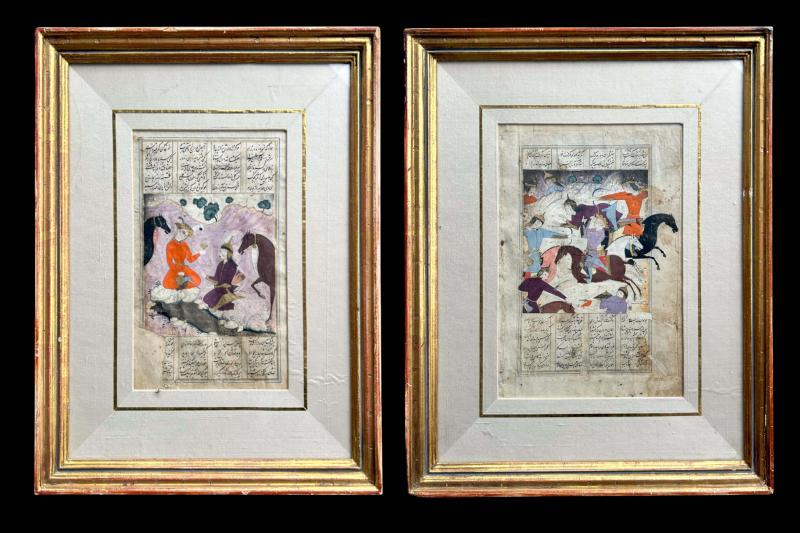
Due pagine illustrate da uno Shahnameh
Iran safavide, forse Qazvin, XVI secolo
Testo in persiano su carta, vergato con inchiostro nero in calligrafia nasta¿liq e disposto entro quattro colonne Interrotte da illustrazioni. Una raffigurante Khosrow; l¿altra raffigurante l¿arrivo di Kaku nella fortezza di Hokht Gang Bayani Salam e la sua morte per opera di Manouchehr.
Danni e restauri.
Two illustrated folios by a Shahnameh
Safavid Iran, possibly Qazvin, 16th century
Persian text on paper, written with black ink in nasta’liq calligraphy and arranged within four columns interspersed with illustrations. One depicting Khosrow; the other depicting Kaku’s arrival at the fortress of Hokht Gang Bayani Salam and his death at the hands of Manouchehr.
Damage and restoration.
21 X 13 cm circa (senza cornice)
AGGIUDICATO
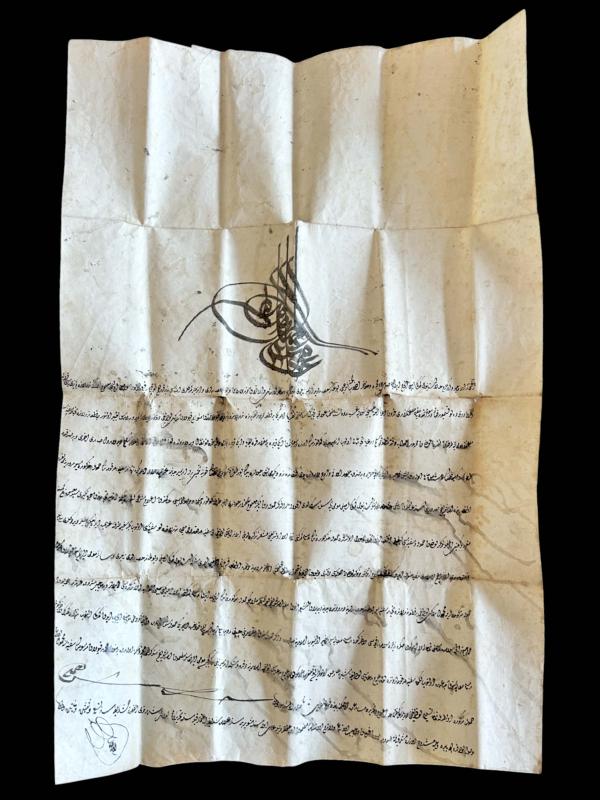
Firman Ottomano con Thughra di Mohmoud II (r. 1808-1839)
Turchia Ottomana, inizio XIX secolo
Testo in turco su carta, 12 linee nella calligrafia della cancelleria (diwani) vergate in inchiostro nero su colonna singola e sormontate dalla cifra del Sultano.Ottoman Firman with Thughra of Mohmoud II (r. 1808-1839)
Ottoman Turkey, early 19th century
Turkish text on paper, 12 lines in chancery script (diwani) written in black ink on a single column and surmounted by the Sultan’s cipher.
H. 78 X L. 51 cm
AGGIUDICATO

Lungo Firman Ottomano in due frammenti
Turchia Ottomana, XVIII o XIX secolo
Testo in turco su carta, 24 linee di testo piene, oltre all¿incipit, vergate con inchiostro nero e rosso in calligrafia diwani, segnalatori di versi in forma di dischi dorati e sormontate da thughra probabilmente del sultano Abdulhamid II (r. 1876-1909). Nella porzione inferiore del frammento con thughra è stampato un timbro relativo a Waqf (istituzione della carità religiosa) nella porzione inferiore, datato 1310 AH (1892 AD).
Long Ottoman Firman in two fragments
Ottoman Turkey, 18th or 19th century
Turkish text on paper, 24 full lines of text, in addition to the incipit, written in black and red ink in diwani calligraphy, verse markers in the form of gilded discs and surmounted by thughra probably from Sultan Abdulhamid II (r. 1876-1909). A stamp related to Waqf (institution of religious charity) is printed on the lower portion of the fragment with thughra, dated 1310 AH (1892 AD).
H. 154 X L. 55 cm
AGGIUDICATO

Pagina illustrata con riproduzione di Aghia Sophia
Turchia, XX secolo
Testo in arabo sul fronte e in turco sul retro. Il fronte mostra raffigurazione posteriore rispetto a carta e calligrafia, raffigurante la moschea più importante di Istanbul, ex basilica bizantina, su sfondo di minute spirali dorate. Il testo su questa pagina è di carattere religioso ed è una preghiera per la vittoria di una guerra, di cui si narra sul verso, in turco, inchiostro nero su colonna singola di 13 linee.
La miniatura è stata esposta presso il Musèe d¿Art Moderne Cèret, Francia, in occasione della mostra Najia Mehadji, la trace et le souffle, 30 giugno-4 novembre 2018.
Illustrated folio with reproduction of Aghia Sophia
Turkey, 20th century
Text in Arabic on the front and Turkish on the back. The front shows a depiction of the most important mosque in Istanbul, a former Byzantine basilica, on a background of minute golden spirals. The text on this page is of a religious character and is a prayer for the victory of a war, which is narrated on the verso, in Turkish, black ink on a single column of 13 lines. The miniature was exhibited at the Musèe d’Art Moderne Cèret, France, during the exhibition Najia Mehadji, la trace et le souffle, 30 June-4 November 2018.
19.5 X 13.5 cm
AGGIUDICATO

Disegno con elefante
India Mogul, inizio XVIII secolo
China su carta, raffigurante un elefante in cattività e tre Mahout che se ne occupano.
La fascinazione della corte Mogul per gli animali ¿esotici¿ è nota e particolarmente vivida nel periodo di Akbar. Gli elefanti rientrano in questo contesto e venivano utilizzati per i carichi pesanti, per il lavoro agricolo, in quanto simbolo di potere, venivano impiegati come mezzo di trasporto per persone importanti durante celebrazioni e parate, ed infine venivano addestrati a compiere acrobazie durante i giochi. Entro cornice in marmo giallo.
Drawing depicting an elephant Mughal
India, early 18th century
China on paper, depicting an elephant in captivity and three Mahouts tending it.The Mughal court’s fascination with ‘exotic’ animals is well known, particularly during the Akbar period. Elephants were part of this context and were used for heavy loads and for agricultural work. As a symbol of power, they were means of transport for important people during celebrations and parades, and finally they were trained to perform acrobatics during games. Within a yellow marble frame.
32 x 54 cm (light 20X39)

Corano
Turchia Ottomana, XIX secolo
Testo in arabo su carta polita, composto da 272 carte, completo. Doppio frontespizio (sarlaw) illuminato con fiori e racemi su sfondo blu cobalto e testo entro cartiglio circolare con interlinea dorata. Specchio di scrittura 150 X 87 mm delimitato da filetto dorato e contenente 15 linee di testo vergate con calligrafia naskh in inchiostro nero e diacritici rossi. Separatori di versetti (ayat) in forma di rondelle dorate, separatori di sezione con medaglioni floreali pendenti e titoli di Sura in riserva su oro. Reclamantes a margine.
Legatura in pelle impressa con aletta.
Ottoman Qur’an
Turkey, 19th century
Arabic text on polished paper, consisting of 272 folios, complete. Double frontispiece (sarlaw) illuminated with flowers and sprays on a cobalt blue background and text within a circular cartouche with gilded spacing. Writing box 150 X 87 mm bordered by gilt fillet, containing 15 lines to the page, written in Naskh script with black ink and red diacritics. Verse separators (ayat) in the form of gilded rosettes, section separators with hanging floral medallions and Sura titles in reserve on gold. Reclamantes in margin. Impressed leather binding with flap.
21.5 X 14.5 cm
AGGIUDICATO

Grande Corano
Kashmir, XIX secolo
Testo in arabo su carta. Doppio frontespizio (sarlaw) in tipico stile indiano con arabeschi su sfondo blu entro archi cuspidi dorati ripetuti. Specchio di scrittura 198 X 103 mm delimitato da triplo filetto rosso e blu e contenente 11 linee di testo vergate con calligrafia naskh in inchiostro nero e diacritici rossi. Separatori di versetti (ayat) in forma di rondelle dorate, separatori di sezione circolari con pendenti e titoli di Sura in rosso. L¿apertura di alcune juz (parti del Corano) decorata con illuminazione floreale nei margini e interlinea dorata. Note a margine in rosso.
Legatura con aletta in cartone ricoperto da pelle rossa.
A large Qur’an
Kashmir, 19th century
Arabic text on paper. Double frontispiece (sarlaw) in typical Indian style with arabesques on a blue background within repeated gilt cusped arches. Writing box 198 X 103 mm bordered by triple red and blue fillets and containing 11 lines of text penned in Naskh script in black ink and red diacritics. Verse (ayat) separators in the form of golden rosettes, circular section separators with pendants and Sura titles in red ink. The opening of some juz (parts of the Qur’an) decorated with floral illumination in the margins and gilded spacing. Notes in margins in red.Red leather-covered cardboard flap binding.
H. 28 X 17.2 cm
AGGIUDICATO

Due vedute di Costantinopoli
XVII-XVIII secolo
Due incisioni raffiguranti la città di Istanbul in veduta ¿a volo di uccello¿. Una delle due di probabile produzione francese, colorata; l¿altra con ampia descrizione in latino.Two lithographs depicting Istanbul
17th – 18th century
Two engravings depicting Istanbul in ‘bird’s eye’ view. One of them probably of French production, coloured; the other with extensive description in Latin.
cm 27×39
cm 29×40
AGGIUDICATO

Diwan-i. Libro di poesie firmato Muhibbi, pseudonimo di Solimano il Magnifico
Istanbul, Matba’a-ï ‘osmâniye, 1308 AH (1891 AD)
Testo stampato in turco ottomano, composto da 236 pagine. Legatura con ribalta in pelle rossa stampata con motivi vegetali rifiniti in argento (parzialmente ossidato). Prima edizione stampata. Di proprietà di Rudolf Tschudi con nota di possesso autografa. Solimano il Magnifico era anche un appassionato poeta e utilizzava lo pseudonimo Muhibbi nelle sue opere letterarie.
Diwan-i. Book of poems signed Muhibbi, pseudonym of Suleiman the Magnificent
Istanbul, Matba’a-ï ‘osmâniye, 1308 AH (1891 AD)
Text printed in Ottoman Turkish, composed of 236 pages. Red leather flap binding printed with plant motifs filled with silver, partially oxidised, finishing. First printed edition. Owned by Rudolf Tschudi with autograph note of ownership. Suleiman the Magnificent was also a passionate poet and used the pseudonym Muhibbi in his literary works.
28 X 17,5 cm
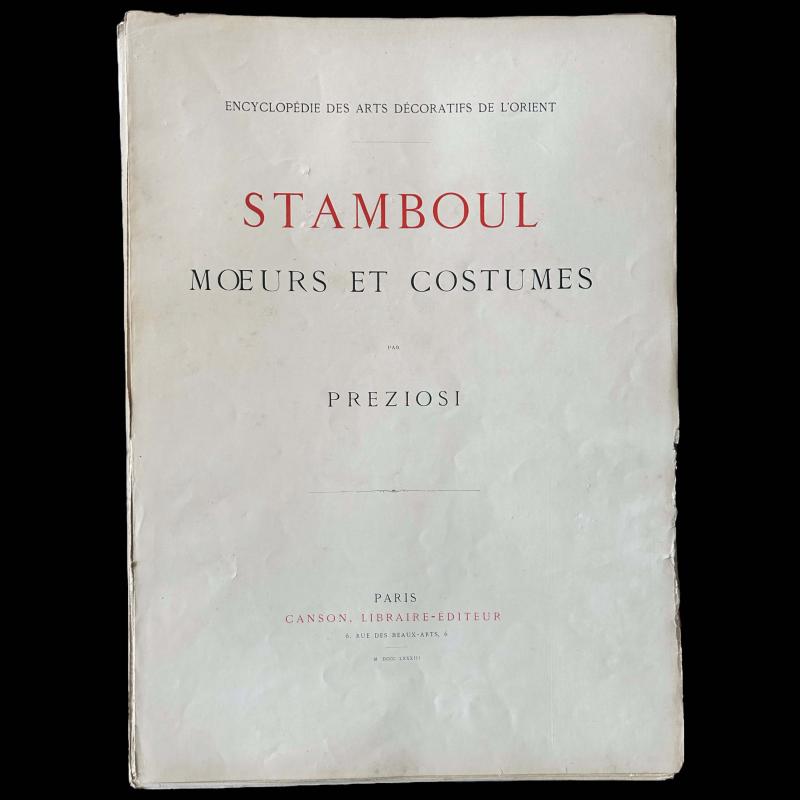
Preziosi, Stamboul Moeurs et Costumes,
Paris, Canson, Libraire ¿ Éditeur, 1883
Volume facente parte dell¿Enciclopedia delle Arti decorative dell¿Oriente. Edizione in folio grande, incompleta, composta da frontespizio, indice e 17 litografie a colori illustranti gli usi e i costumi della città di Istanbul, il tutto contenuto entro cartella originale in cartone telato. All¿interno presenta Ex Libris della collezione Emil & Helene Jaensch.Preziosi, Stamboul Moeurs et Costumes
Paris, Canson, Libraire – Éditeur, 1883
Part of the Encyclopaedia of the Decorative Arts of the Orient. Large folio, incomplete, consisting of frontispiece, index and 17 colour lithographs illustrating the traditional customs of Istanbul, all contained within original cloth-covered cardboard folder. Inside showing Ex Libris from the Emil & Helene Jaensch collection. An Orientalist painter originally from Malta, Amadeo Preziosi (1816- 1882) arrived in Istanbul at the end of 1842 and lived there until his death in 1882. He became famous as the painter who reflected contemporary life in Istanbul. He was also employed as court painter during the period of Abdulhamid II.
67 X 48 cm
AGGIUDICATO
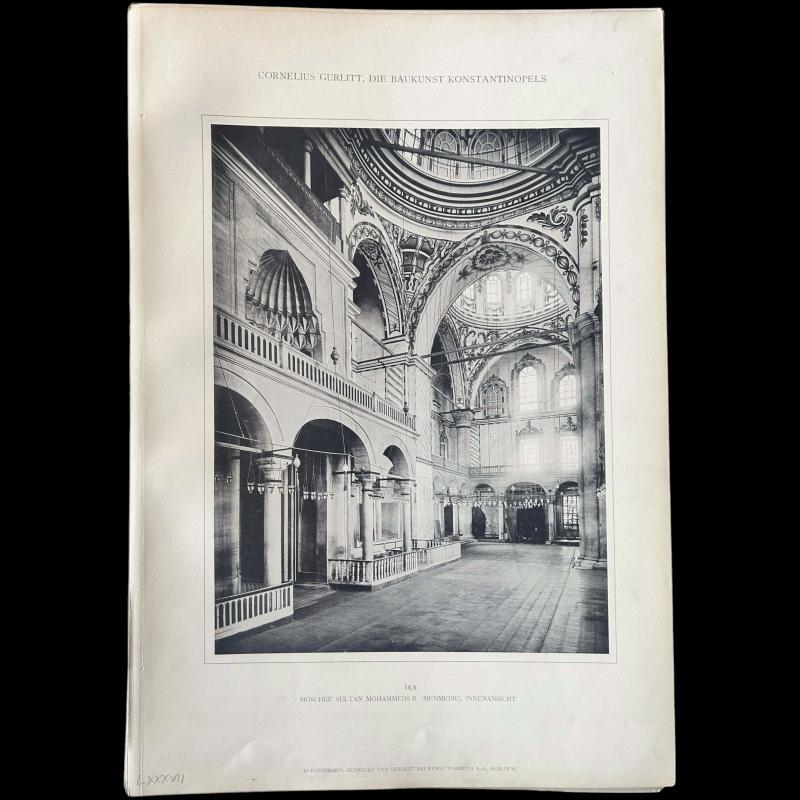
Cornelius Gurlitt, Die Baukunst Konstantinopels,
Berlino, Verglegt bei Ernst Wasmuth A.-G., 1912
Raccolta di circa 100 fogli con tavole fotografiche e prospetti architettonici dei principali monumenti di Costantinopoli.Cornelius Gurlitt, Die Baukunst Konstantinopels
Berlino, Verglegt bei Ernst Wasmuth A.-G., 1912
Collection of ca. 100 sheets with photographic plates and architectural plans of the main monuments of Constantinople.
51 X 36 cm

L¿empire Ottoman illustrè – Costantinople Ancienne et Moderne
Fisher Fields and Cie, Londra e Parigi, senza data (1838 ca.)
Tre volumi rilegati in pelle stampata in oro, edizione pregiata dell¿opera di Lèon Galimbert e C. Pellè, collaboratori della rivista britannica, illustrato dal cav. Thomas Allom. Ogni volume contiene 32 tavole in bianco e nero, protette da velina.
L’empire Ottoman illustrè – Constantinople Ancienne et Moderne Fisher Fields and Cie
London and Paris, undated (c. 1838)
Three volumes bound in gold stamped leather, fine edition of the work by Lèon Galimbert and C. Pellè, contributors to the British magazine, illustrated by Cav. Thomas Allom. Each volume contains 32 black and white plates, protected by tissue paper.
H. 28.5 X 22 cm
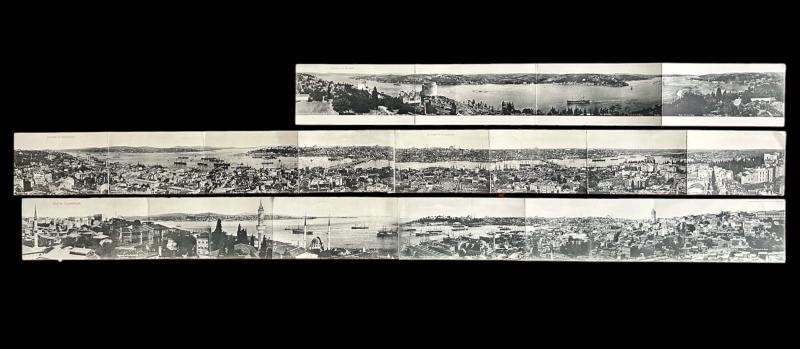
Tre fotografie panoramiche del Bosforo
1900 ca.
Include: Una veduta di Istanbul dalla Torre di Galata; una una veduta del Bosforo da Roumeli Issar e l¿ultima veduta della città in cui si vede il quartiere di Galata.
Foto in bianco e nero, prodotte dai fratelli Ludwigsohn, piazza Karakeuy 21 Istanbul.
Three panoramic photographs of the Bosphorus
c. 1900
Including: A view of Istanbul from the Galata Tower; a view of the Bosphorus from Roumeli Issar and a view of the city showing the Galata district. Black and white photos, produced by the Ludwigsohn brothers, Karakeuy Square 21 Istanbul.
H. 9 X l. 110 cm (the largest)

Scorcio cittadino e una veduta del porto di Costantinopoli
Augusta e Parigi, XVIII secolo
Veduta prospettica della città di Istanbul realizzata secondo lo stile da veduta ottica tipico di Georg Balthasar Probst (1732-1801). L¿altra una pittoresca veduta del Porto della città presa dalla costa Nord.City view and a view of the port of Constantinople
Augsburg and Paris, 18th century
Perspective view of Istanbul made in the style of an optical veduta typical of Georg Balthasar Probst (1732-1801). The other a picturesque view of the city harbour taken from the north coast.
cm 32×44
cm 26×40

Voyage pittoresque de Constantinople et des rives du BosphoreSei scene di vita cittadina
Bruxelles, XIX secolo
Sei litografie realizzate da artisti diversi e stampate a Bruxelles presso la calcografia reale di Goubaud. Le seguenti litografie antiche provengono dalla seconda edizione dell’opera famosa di Melling, ‘Voyage pittoresque de Constantinople et des rives du Bosphore,’ pubblicata da Goubaut a Bruxelles nel 1822 (prima edizione: Parigi 1819). Le impressionanti vedute di Melling sono considerate tra le migliori mai stampate della zona di Costantinopoli. In questa edizione, le tavole sono state re-incise in un formato più piccolo.
Voyage pittoresque de Constantinople et des rives du BosphoreSix scenes of city life
Brussels, 19th century
Six lithographs made by different artists and printed in Brussels at Goubaud’s Royal Chalcography. The following early lithographs originate from the second edition of Melling’s renowned work, ‘Voyage pittoresque de Constantinople et des rives du Bosphore,’ published by Goubaut in Brussels in 1822 (first edition: Paris 1819). Melling’s stunning views are widely regarded as some of the finest ever printed of the Constantinople area. In this edition, the plates have been re-engraved in a smaller format.
cm 34.5×48
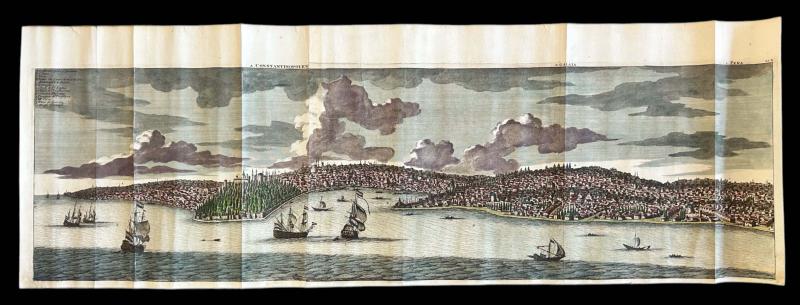
Da Cornelis de Bruyn,
Incisione a colori
rappresentante una veduta
di Istanbul.
XVIII secolo
Veduta panoramica dal
Bosforo della città di
Costantinopoli con i
quartieri di Pera e Galata.
Incisione acquerellata a
mano.
After Cornelis de Bruyn, Colour engraving representing a view of Istanbul
18th century
Panoramic view from the Bosphorus of the city of Constantinople with the districts of Pera and Galata. Watercoloured engraving by hand.
35×103 cm
AGGIUDICATO

Veduta di Costantinopoli dal
porto
Austria (?) Inizi del XIX
secolo
Veduta panoramica della
Capitale Ottomana con
indicazioni dei principali punti panoramici.
View of Constantinople from the harbour
Austria (?) Early 19th century
Panoramic view of the Ottoman Capital with indications of the main viewpoints.
13.5 X 65 cm
AGGIUDICATO

Antoine Ignace Melling (1763-1831). Marche Solemnelle du Grand-Seigneur
Francia, 1819
Grande acquaforte incisa da Duplessi-Bertaux e Reville dalla prima edizione di ‘Voyage pittoresque de Constantinople’. La stampa raffigura la Marcia Solenne del sultano il giorno del Bairam su disegno di Antoine Ignace Melling (1763-1831).Antoine Ignace Melling (1763-1831). Marche Solemnelle du Grand-Seigneur
Francia, 1819
Elephant folio, by Duplessi-Bertaux and Reville from the First Edition of the ‘Voyage pittoresque de Constantinople’. The etching depicting the Sultan’s Solemn March on Bairam Day based on a drawing by Antoine Ignace Melling (1763-1831).
cm 104.5 X 66

Prospetto del Gran Serraglio da Galata
Inghilterra, XVIII secolo
Incisione acquerellata con veduta del Gran Serraglio sultaniale, di Santa Sophia e della costa asiatica.
Prospect of the Great Seraglio from Galata
England, 18th century
Watercoloured etching with a view of the Great Sultan’s Seraglio, St. Sophia and the Asian coast.
H. 15.5 X 37 cm
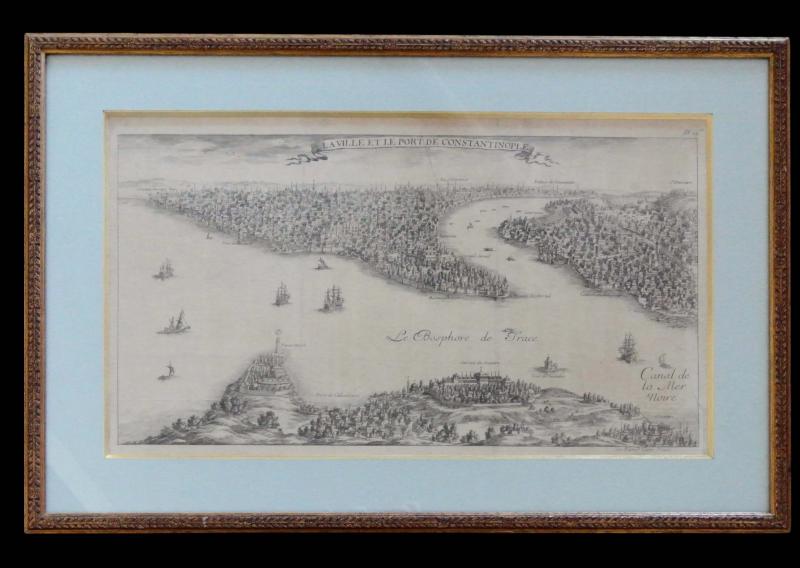
Veduta della città di Istanbul
Francia (?), XVII secolo
Veduta ¿a volo di uccello¿ della capitale ottomana dal Bosforo. Incisione di Leblond.View of Istanbul
France (?) 17th century
Bird’s eye view of the Ottoman capital from the Bosphorus. Litograph by Leblond.
cm 27×45
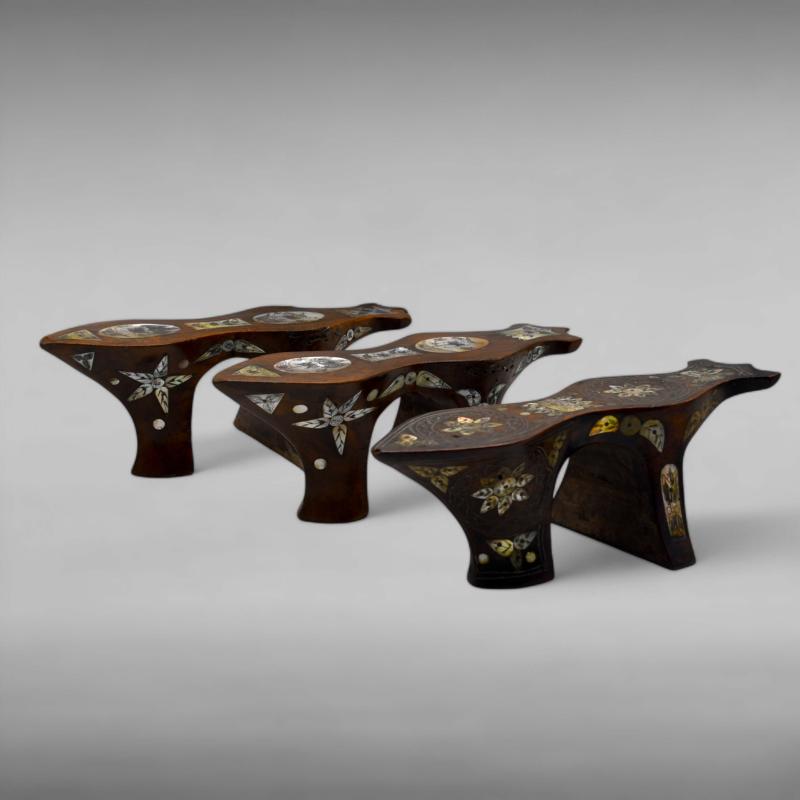
Tre zoccoli hammam
Turchia Ottomana, XIX secolo
Tre zoccoli da bagno (una coppia ed uno spaiato) in legno con intarsi floreali in madreperla e filo d¿argento.Three hammam clogs
Ottoman Turkey, 19th century
Three bath clogs (one pair and one unpaired) made of wood with floral mother-of-pearl inlays and silver thread.
H. 9 X L. 25 cm

Arco Ottomano in legno dipinto e dorato
Turchia Ottomana, XIX secolo
finemente decorato con elementi floreali ed arabeschi su sfondo rosso, nero e verde.
Painted and gilded wooden Ottoman bow
Ottoman Turkey, 19th century
Finely decorated with floral elements and arabesques on a red, black and green background.
88 cm
AGGIUDICATO

Leggio in alabastro dipinto
India, XIX secolo
Porta Corano pieghevole; l¿esterno dipinto con elementi floreali rossi e verdi con dettagli in oro. La pietra intagliata sui piedi a formare delle arcate polilobate e lavorata a traforo con fiore a quattro mentali ripetuti sull¿altra estremità. Interno dipinto in rosso con bordura verde.
Painted alabaster folding Qur’an holder
India, 19th century
The exterior painted with red and green floral elements with gold details. The stone carved on the feet to form poly-lobed arches and with latticed openwork decoration on the other end. Interior painted in red with green border.
30 x 17,5 cm (chiuso)
AGGIUDICATO
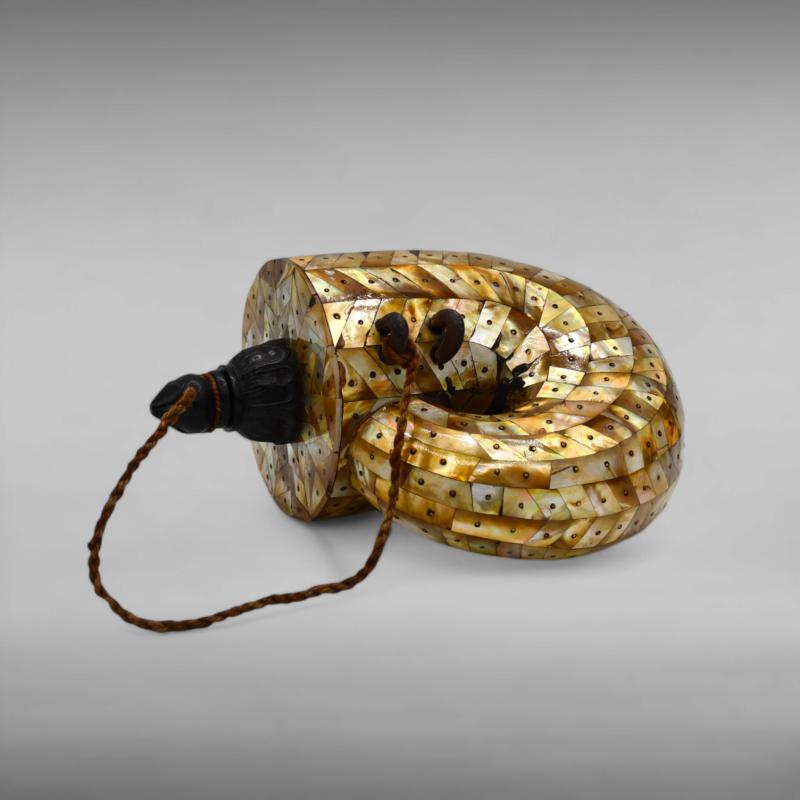
Fiasca per polvere da sparo in madreperla
India Nord-Occidentale, Gujarat, XVIII secolo
In forma di corno, ricavato da una conchiglia (gasteropode), a sezione cilindrica decorato con tessere di madreperla triangolari e rettangolari arrangiate a formare chevron e decori geometrici sul corpo e una grande stella concentrica ad otto punte sul tappo. Impugnatura in legno intagliato a morivo vegetale.
A large mother-of-pearl gunpowder flask
Northwest India, Gujarat, 18th century
In the form of a horn, made from a shell (gastropod), cylindrical section decorated with triangular and rectangular mother-of-pearl tesserae arranged to form chevrons and geometric decorations on the body and a large concentric eight-pointed star on the lid. Carved wooden handle with vegetal motifs.
H. 18 X L. 13 X 8.5 cm ca.
AGGIUDICATO
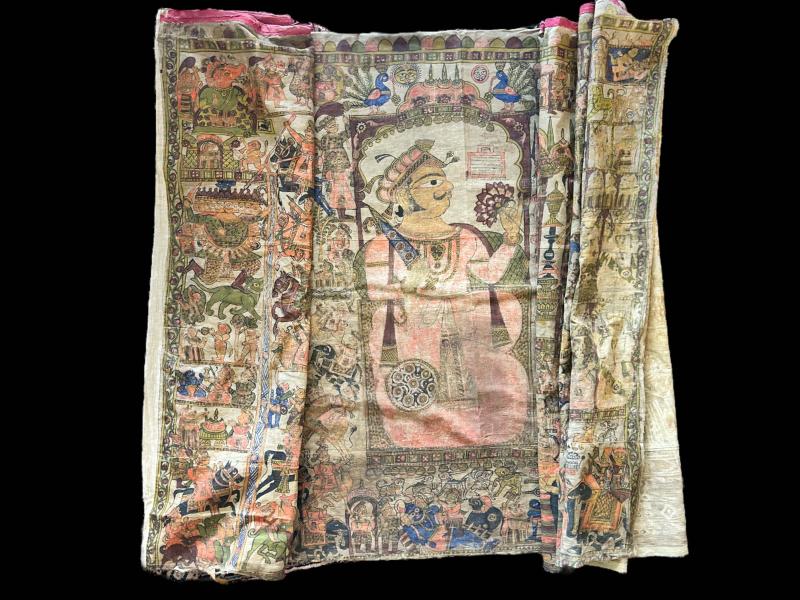
Grande dipinto raffigurante la vita di Pabuji (Pabuji Ki Phad)
India Settentrionale, Rajasthan, tardo XIX-inizio XX secolo
Tempera su tela, raffigurante le imprese eroiche di Pabuji, considerato un’incarnazione di una divinità. Divinità popolare Rajasthana, la leggenda di Pabuji viene narrata attraverso un’arte tradizionale di narrazione chiamata Phad i cui artisti creano queste lunghe raffigurazioni istoriate (Pabuji Ki Phad), che vengono utilizzate durante le rappresentazioni musicali. Lunga iscrizione in devanagari sopra il personaggio principale. Attualmente il mercato è saturo di riproduzioni moderne e ridotte, l’esemplare qui proposto è sicuramente antico e per uso devozionale. Per approfondimento si veda: John D. Smith, The Epic of Pabuji: A Study, Transcription and Translation, Cambridge University Press, 1990. Attualmente il mercato è saturo di riproduzioni moderne e ridotte, l’esemplare qui proposto è sicuramente antico e per uso devozionale.Large painting depicting the life of Pabuji (Pabuji Ki Phad)
Northern India, Rajasthan, late 19th-early 20th century
Tempera on cloth, depicting the heroic deeds of Pabuji, revered as the incarnation of a deity. A popular Rajasthana deity, the legend of Pabuji is narrated through a traditional art of storytelling called Phad whose artists create these long historiated depictions (Pabuji Ki Phad), to be used during musical performances. Long devanagari inscription above the charcater. Currently the market is saturated with modern and reduced reproductions, though this specimen is definitely ancient and for devotional use. For further reading see John D. Smith, The Epic of Pabuji: A Study, Transcription and Translation, Cambridge University Press, 1990.
4.54 X 1.42 m
AGGIUDICATO
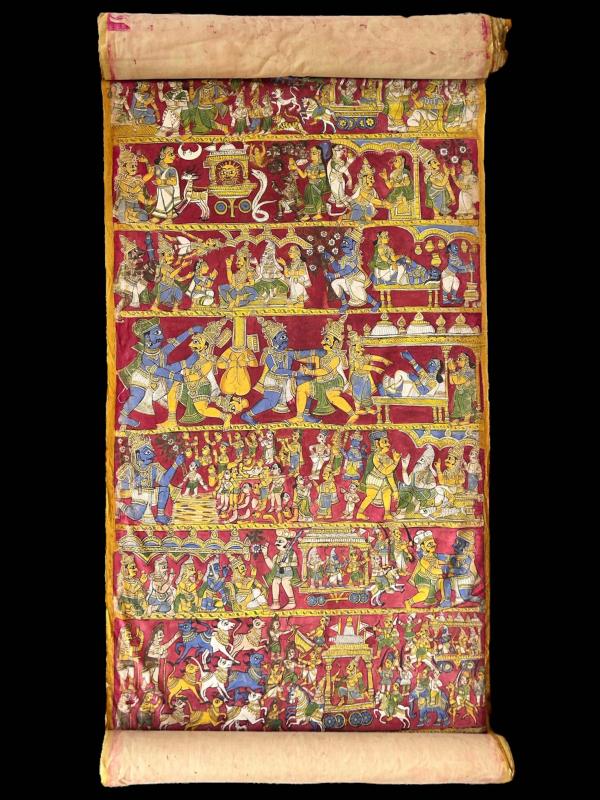
Grande pittura su tela raffigurante il Mahabharata
India, Deccan, XIX secolo
Lunga raffigurazione di uno dei più celebri poemi epici indiani, principalmente incentrato sulla guerra di Kurukshetra e sulle storie delle dinastie Kuru e Pandava per il trono del regno di Hastinapura.
Originariamente scritto in sanscrito, il poema comprende più 100.000 versi, configurandosi come uno dei poemi epici più lunghi al mondo. La tradizione ne attribuisce la paternità a Vyasa, un saggio presumibilmente vissuto intorno al 1500 a.C.
Tra i passaggi più celebri raffiguranti anche sul nostro dipinto troviamo: La morte di Abhimanyu e la preghiera di Arjuna a Durga prima della grande battaglia.
Per approfondimenti si veda: Bibek Debroy, The Illustrated Mahabharata. The definitive guide to India¿s Greatest Epic, New York, 2017.
Large painting on cloth depicting the Mahabharata
India, Deccan, 19th century
Long depiction of one of India’s most famous epic poems, mainly focusing on the Kurukshetra War and the stories of the Kuru and Pandavas dynasties for the throne of the kingdom of Hastinapura.Originally written in Sanskrit, the poem comprises more than 100,000 verses, making it one of the longest epic poems in the world. Tradition attributes its authorship to Vyasa, a sage who supposedly lived around 1500 BC.Among the most famous passages depicted here are: Abhimanyu’s death and Arjuna’s prayer to Durga before the great battle. For more details see: Bibek Debroy, The Illustrated Mahabharata. The definitive guide to India’s Greatest Epic, New York, 2017.
H. 11.93 X L. 1.03 m
AGGIUDICATO

Grande scultura di Ganesh in marmo
India, XX secolo
Grande scultura raffigurante la divinità dalla testa elefantina in marmo parzialmente dorato e dipinto. Ganesh è seduto in rajalilasana ed è adornato con importanti gioielli. Danni.
Large marble sculpture of Ganesh
India, 20th century
Large sculpture depicting the elephantine-headed deity in partially gilded and painted marble. Ganesh is seated in rajalilasana and is adorned with important jewellery. Damages.
55×17×30 cm
AGGIUDICATO
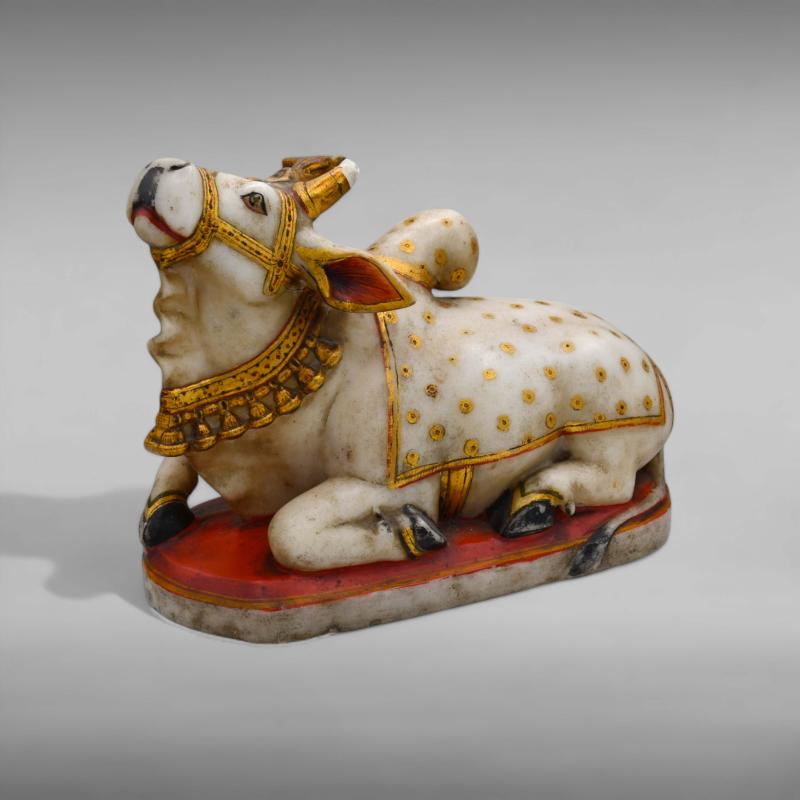
Grande Nandi in alabastro dipinto e dorato
India Settentrionale, XIX secolo
grande scultura raffigurante la cavalcatura di Shiva, adorna di collana e paramenti preziosi.
Large painted and gilded alabaster sculpture of Nandi
Northern India, 19th century
Large sculpture depicting Shiva’s vehicle, adorned with a necklace and precious vestments.
22 X 33 cm
AGGIUDICATO

Base di pipa ad acqua (huqqa) in alabastro dorato e dipinto
India settentrionale, XIX secolo
Dalla tipica forma globulare, l¿esterno dipinto con reticolo di elementi vegetali contenenti un fiore nei colori del rosso, verde e oro.
Gilded and painted alabaster water pipe base (huqqa)
Northern India, 19th century
With a typical globular shape, the exterior painted in red, green and gold with latticed plant elements containing a flower.
22 X 17 cm
AGGIUDICATO
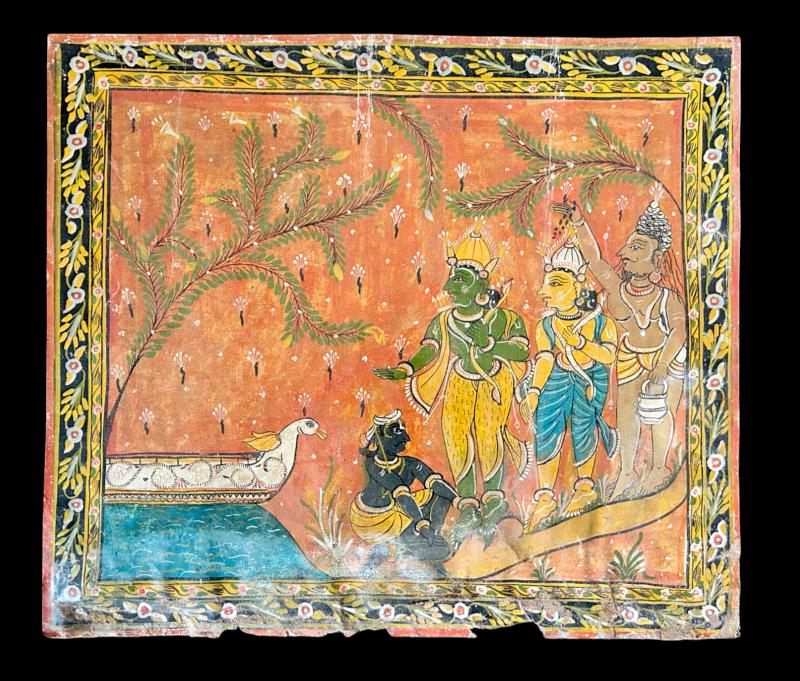
Dipinto su cotone a soggetto induista
Sud-Est asiatico, XIX secolo
Tempera su cotone, forse raffigurante un episodio del Ramayana in cui il barcaiolo Guha aiuta Rama a navigare il fiume Gange.Painting on cloth depicting a Hindu subject
Southeast Asia, 19th century
Tempera on cotton, possibly depicting an episode from the Ramayana in which the boatman Guha helps Rama navigate the river Ganges.
44 X 39 cm

Dipinto su tessuto raffigurante Krishna con le Gopies
India, XX secolo
tempera su tessuto raffigurate Krishna e Radha al centro, dentro una barca sul lago e Krishna con portatrici di acqua ai lati della composizione.
Painting on cloth depicting Krishna with Gopies
India, 20th century
Tempera on cloth depicting Krishna and Radha in the centre, inside a boat on a lake and Krishna with water bearers on either side of the composition.
H. 50 x 180 cm
AGGIUDICATO
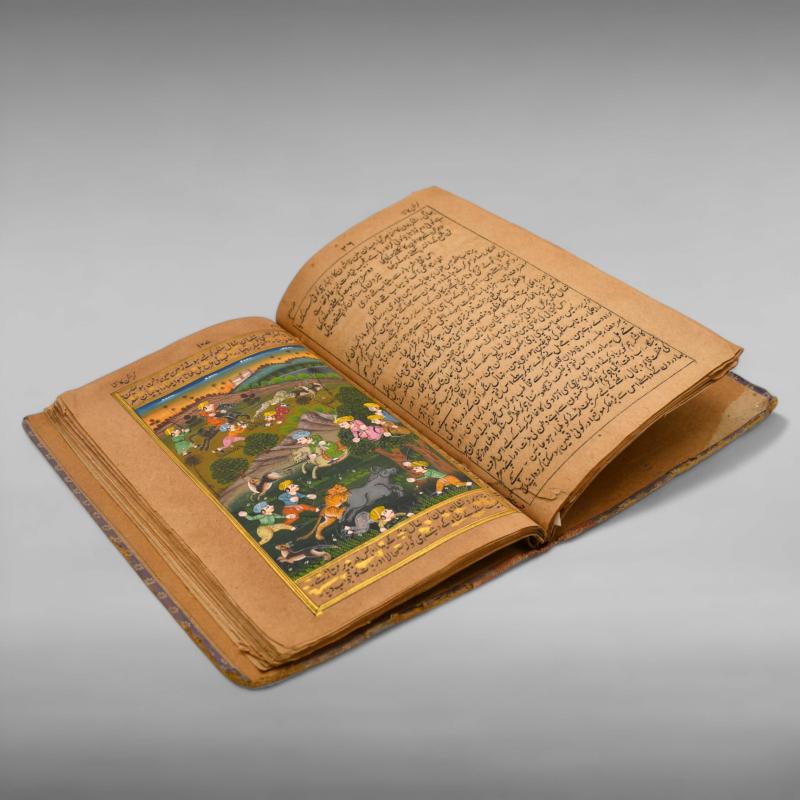
Manoscritto illustrato
India settentrionale, XX secolo
Testo in urdu su carta arrangiato su colonna singola e inframezzato da dipinti delimitati da filetto dorato.
Il testo sembra essere induista, di ambito Krishnaita.
Illustrated manuscript
Northern India, 20th century
Text in Urdu on paper arranged on a single column and interspersed with paintings bordered with gold thread. The text appears to be Hindu, Krishnaite.
H. 21 X 13.5 cm
AGGIUDICATO
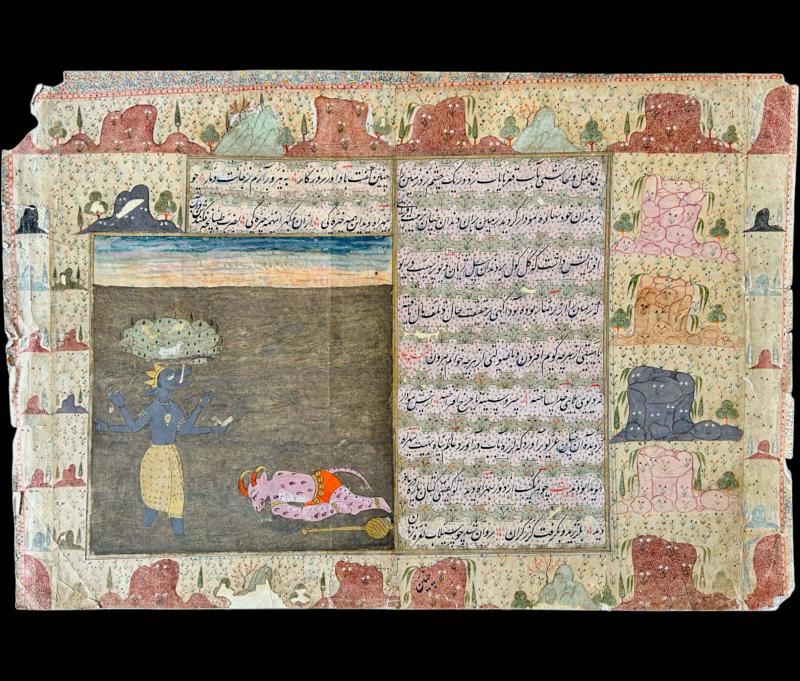
Miniatura composita raffigurante Viraha che sconfigge il demone
India, XIX-XX secolo
Pagina illustrata composta da iscrizione in persiano e raffigurazione di Viraha che sconfigge il demone Hiranyaksha sulla sinistra. I margini riproducono delle montagne su sfondo floreale variopinto. 11 linee di testo in persiano su carta, in calligrafia shikaste vergate con inchiostro nero e rosso con interlinea dorata.
Composite illustrated folio depicting Viraha defeating the demon
India, 19th – 20th century
Composed of Persian text and depiction of Viraha defeating the demon Hiranyaksha on the left. The margins illuminated with mountains on a multicoloured floral background. 11 lines of text in Persian on paper, in shikaste calligraphy written in black and red ink with golden spacing.
H. 35 cm X L. 49.7
AGGIUDICATO

Kashkul in ceramica
Iran Qajar, XIX secolo
Ciotola per le elemosine con decorazione figurativa, vegetale e zoomorfa.
A pottery begger¿s bowl (Kashkul) Qajar Iran, 19th century
Alms bowl with figurative, plant and zoomorphic decoration.
H. 13.5 X L. 28.5 cm
AGGIUDICATO

Due scatole cilindriche in osso e argento
India, XIX secolo
Lavorate alla maniera degli oggetti indo-portoghesi in madreperla, queste con tessere di osso arrangiate a formare decori radiali e geometrici.
Two cylindrical bone boxes with silver fittings
India, 19th century
Worked in the manner of Indo-Portuguese mother-of-pearl items, these with bone tesserae arranged to form radial and geometric decorations.
H. 6 X D. 11.6 cm
AGGIUDICATO

Piccola placca in osso con iscrizione religiosa
Vicino Oriente, inizio XX secolo
Intaglio talismanico in osso con iscrizione in arabo a specchio ed in rilievo. Entro cornice in legno.
Iscrizione: Ya Alim.
Small bone plaque with religious inscription
Near East, early 20th century
Talismanic bone carving with Arabic inscription in relief and mirrored arrangement. Within wooden frame.
Inscription: Ya Alim.
H. 12 X L. 14.2 cm (without frame)
AGGIUDICATO

Placca in alabastro scolpito
India, XIX secolo
Placca decorativa, forse in origine un coperchio, umbone centrale scolpito con petali e inquadrato da ampia fascia decorativa con felini intervallati da cartigli contenenti elementi vegetali e antilopi ai quattro angoli.
Carved alabaster plaque
India, 19th century
Decorative plaque, possibly originally a cover, central protruding umbo carved with petals and framed by a wide decorative band with felines interspersed with cartouches containing plant elements and antelopes at the four corners.
30 X 30 cm
14 kg
AGGIUDICATO

Versatoio zoomorfo in stile Khorasan
Afghanistan, XX secolo
Corpo costolonato, poggiante su alto piede, collo in forma di ariete. Decorato con iscrizioni ed elementi floreali intarsiati con filo di rame e d¿argento.
A Khorasan-style zoomorphic bronze ewer
Afghanistan, 20th century
Ribbed body, resting on a high foot, neck in the shape of a ram. Decorated with inscriptions and floral elements inlaid with copper and silver threads.
H. 33.5 X D. 11 cm
AGGIUDICATO

Contenitore Cairoware
Egitto, XX secolo
In ottone, a sezione cilindrica e pareti dritte convergenti, l¿esterno decorato con ampia iscrizione in thuluth. Incisione sulla base.
Cairoware container
Egypt, 20th century
Brass, cylindrical section and straight converging walls, the exterior decorated with a large inscription in thuluth. Engraving on the base.
H. 9 X D. 11.5 cm
AGGIUDICATO
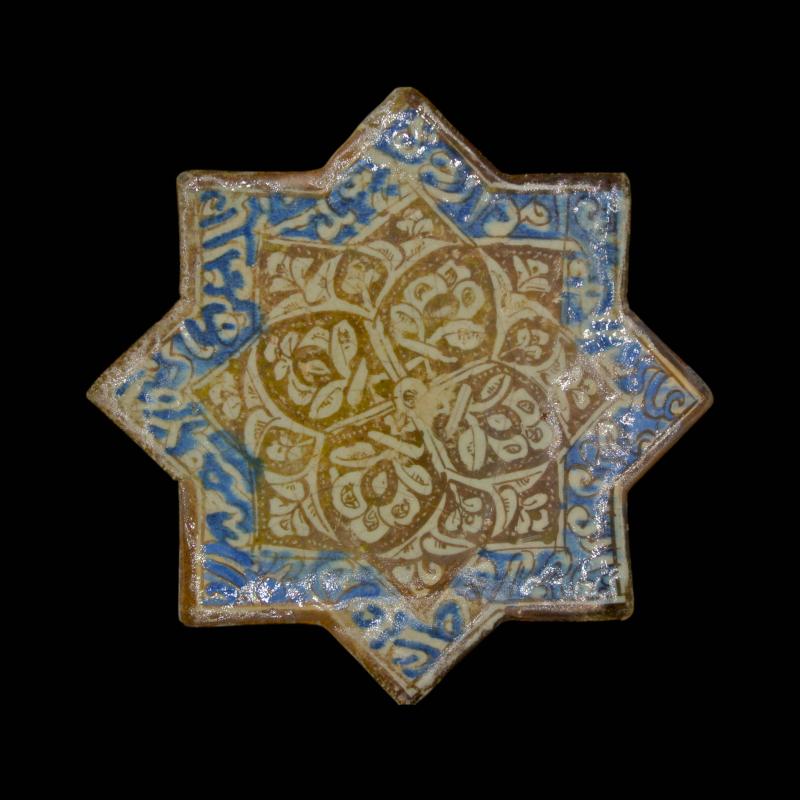
Mattonella a forma di stella
Iran Ilkhanide, probabilmente Kashan, XIV secolo
In pasta silicea, decorata in riserva su lustro metallico bruno con fiore quadripartito ed iscrizione in blu cobalto sottocoperta lungo il bordo della mattonella in forma di stella ad otto punte.
Originariamente parte di una composizione più ampia atta a decorare le pareti di un edificio. Provenienza: collezione privata Nord Italia.
A lustre painted star-shaped tile Ilkhanid
Iran, probably Kashan, 14th century
Siliceous body, decorated in reserve on brown metallic lustre with a quadripartite flower and an inscription in underglaze cobalt blue running along the edge of the tile in the form of an eight-pointed star. Originally part of a larger composition intended to decorate the walls of a building.
Provenance: Private Collection Northern Italy.
L. 20.5 cm
AGGIUDICATO

Ciotola con decorazione a stampo
Persia Orientale, XII-XIII secolo
In pasta silicea, le pareti interne con decorazione a stampo in rilievo, ricoperta di con iridescenza, colature turchesi sul bordo interno delimitato da motivo radiale in manganese. Provenienza: collezione privata Nord Italia.
Bowl with mould decoration
Eastern Iranian World, 12th-13th century
Of siliceous body, the inner walls with mould decoration in relief, covered with iridescent glaze, turquoise drippings on the inner rim bordered by manganese scalloped motif.
Provenance: Private Collection Northern Italy.
H. 9 X D. 16
AGGIUDICATO

Ciotola Bamyan con decorazione incisa
Asia Centrale, XII-XIII secolo
Piccola coppa in terracotta ingabbiata di bianco, le pareti interne con decorazione incisa di cartigli contenenti tondi colorati in manganese alternati a pannelli con motivo simile a quello delle scaglie di pesce, vivacizzato da tondi verdi. Provenienza: collezione privata Nord Italia.
A Bamyan cup with engraved decoration
Central Asia, 12th-13th century
Small slip painted terracotta bowl, the interior walls with incised decoration arranged within cartouches containing manganese-coloured roundels alternating with panels with a fish scale-like motif with green roundels.
Provenance: Private Collection Northern Italy.
13.5 X H. 6.7 cm
AGGIUDICATO

Modellino Kashan in ceramica
Iran selgiuchide, XII-XIII secolo
Lanterna o modellino con quattro mihrab, uno per lato, in fritta lavorata a stampo e ricoperta di invetriatura turchese. Forma rettangolare, poggiante su quattro piedini, i bordi sottolineati da elemento ¿torchon¿ e tetto con foro centrale.
Tra la produzione di Kashan di questo periodo si trovano i manufatti comunemente denominati ¿modellini di casa¿, una produzione peculiare seriale, assimilabile all¿oggetto qui presentato, che raffigura case senza tetto che permettono di apprezzare la suddivisione degli spazi e talvolta persino tavole imbandite con i commensali.
A Kashan pottery model Seljuk
Iran, 12th-13th century
Lantern or model with four mihrab niches, one on each side, in moulded fritware and covered with turquoise glaze. Rectangular in shape, resting on four feet, the edges emphasised by a ¿torchon¿ element and a roof with a central hole. Among Kashan’s production from this period are artefacts commonly referred to as ‘model houses’, a peculiar serial production, similar to the object presented here, depicting houses without roofs that allow us to appreciate the subdivision of spaces and sometimes even tables set with caterers.
15.5 X 11 X 10 cm
AGGIUDICATO
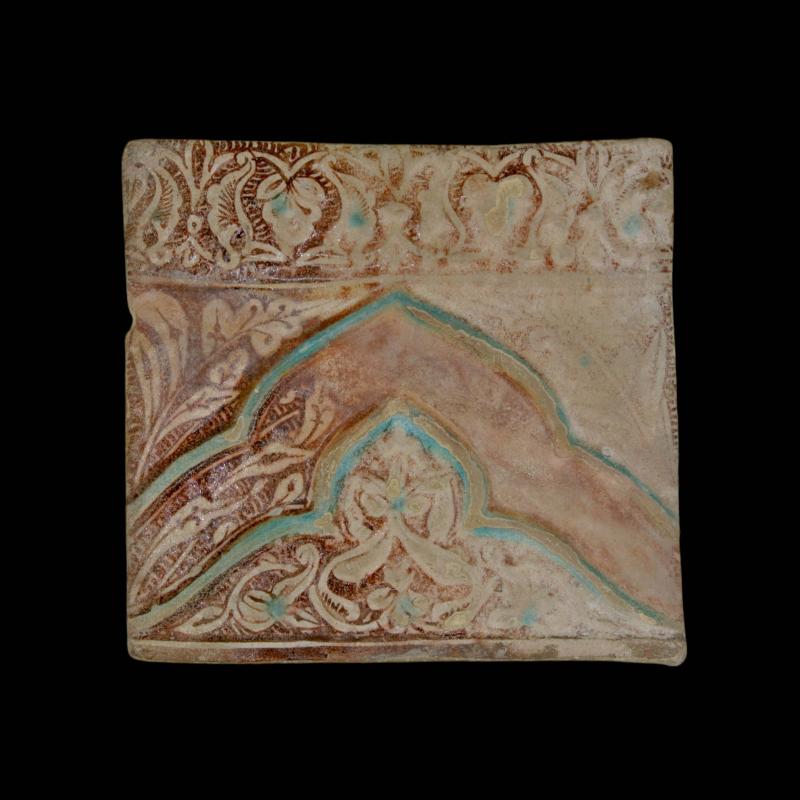
Mattonella a lustro Kashan
Iran Ilkhanide, Kashan, XIII secolo
Rettangolare, in pasta silicea lavorata a stampo con decori floreali e nicchia mihrab centrale in rilievo. Fregio di mezze palmette nella porzione superiore. Dipinta con ingobbito bianco, rifinita con turchese sottocoperta e lustro metallico bruno a terzo fuoco. Restauri.Provenienza: collezione privata Nord Italia.
A Kashan moulded lustre tile Ilkhanid
Iran, 13th century
Rectangular, in moulded siliceous paste with floral decoration and central mihrab niche in relief. Half palmette frieze in the upper edge. Painted with white slip, finished with turquoise underglaze and third-firing brown metallic lustre. Restorations.
Provenance: Private Collection Northern Italy.
H. 21.5 X l. 23 cm
AGGIUDICATO
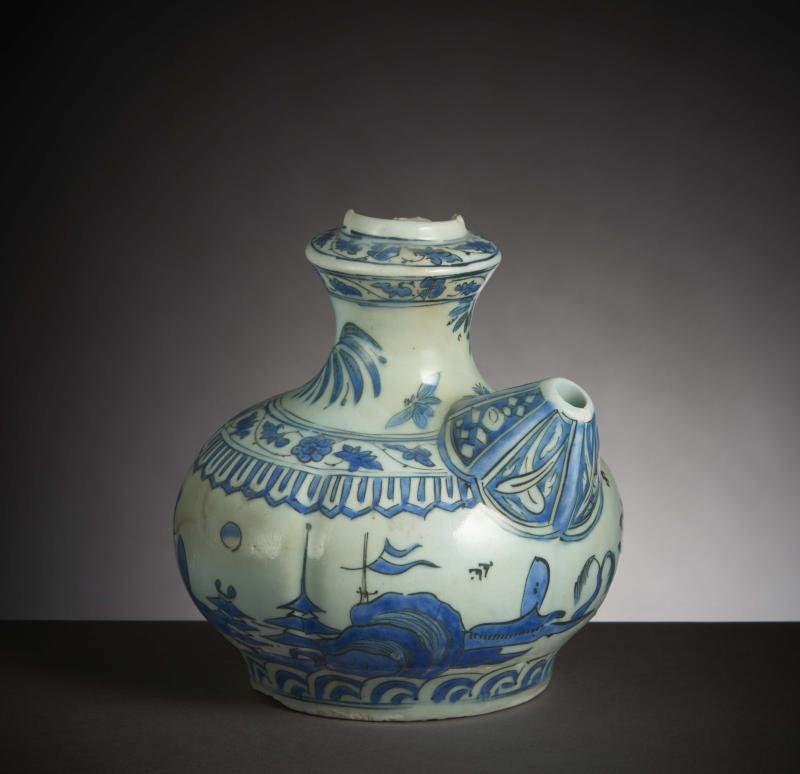
Base di pipa ad acqua (kendi) in ceramica bianco e blu Iran Safavide,
XVII secolo
Vaso in pasta silicea, a sezione circolare, dalla caratteristica forma globulare con collo a clessidra e versatoio rigonfio, sfaccettato in questo caso in luogo dell¿usuale forma globulare. L¿esterno dipinto in blu sottocoperta con decorazione di imitazione cinese che comprende alte pagode in contesto marittimo, un motivo a onde stilizzate cinge la base e motivi floreali ornano la spalla e il collo. Caratteristico della produzione safavide è il bordo nero che
disegna i confini dei motivi decorativi e lo pseudo marchio di ispirazione cinese sulla base. Difetti e rotture.
A Chinese inspired blue and white Safavid huqqa base (Kendi)
Iran, 17th century
fritware body with typical globular shape, hourglass shaped neck and a bulging, faceted pourer in this case instead of the usual rounded form. The surface with underglaze blue decoration imitating the Chinese tradition featuring tall pagodas in a maritime context, a stylised wave motif encircles the base and floral motifs adorning the shoulder and neck. Characteristic of Safavid production is the black outline and the pseudo Chinese-inspired mark on the base. Flaws and cracks.
H. 16,2 X L. 13
AGGIUDICATO

Grande bacile safavide in ceramica bianco e blu
Iran, XVII secolo
Poggiante su piede circolare leggermente svasato e spalla terminante con orlo dritto. L¿esterno con decorazione bordata di nero e colorata con blu cobalto sottocoperta, dipinta con pannelli lobati verticali contenenti uccelli tra fiori intervallati da pannelli più piccoli con decorazioni astratte. Il bordo superiore interno decorato con fascia raffigurante uccelli in volo su paesaggio lacustre e tondo centrale con due cerbiatti tra piante.
Oggetti di questo tipo si erano diffusi in Persia come emulazione della porcellana cinese, penetrata in Iran con la pax mongolica e nei secoli persianizzata con il disegno nero e soggetti locali. A large Safavid blue and white pottery bowl
Iran, 17th century
Resting on a slightly flared circular foot and shoulder terminating in a straight edge. The exterior with decoration outlined in black and coloured with cobalt blue underneath, painted with vertical lobed panels containing birds among flowers interspersed with smaller panels with abstract decoration. The upper inner border featuring a band containing birds in flight over a lake landscape and a central roundel with two fawns among plants.Objects of this type had spread to Persia as an emulation of Chinese porcelain, which had penetrated into Iran with the pax mongolica and over the centuries Persianised with black outline and local subjects.
28 X H. 14.5 cm
AGGIUDICATO

Mattonella Multan
Attuale Pakistan, XIX secolo
Parte di una decorazione più ampia, in ceramica lavorata a stampo con decoro centrale in forma di palmetta in rilievo, sottolineata dal bordo blu che incornicia due riserve floreali su sfondo turchese. All¿interno dei cartigli due iscrizioni religiose (Ya Allah, Ya Muhammad) in riserva su blu cobalto. Elementi floreali su sfondo bianco completano la composizione.
Per un esemplare comparativo si veda David Collection di Copenhagen, Acc. no. 29/1989. Provenienza: Collezione privata Nord Italia.
A blue and white Multan pottery tile Nowadays
Pakistan, 19th century
Part of a larger decoration in moulded ceramic with central decoration in the form of a palmette in relief, outlined by the blue border framing two floral reserves on a turquoise background. Inside the cartouches are two religious inscriptions (Ya Allah, Ya Muhammad) in reserve on cobalt blue. Floral elements on a white background complete the composition. For comparison see David Collection in Copenhagen, Acc. no. 29/1989.
Provenance: Private Collection Northern Italy.
33 X 28 X H. 3 cm
AGGIUDICATO
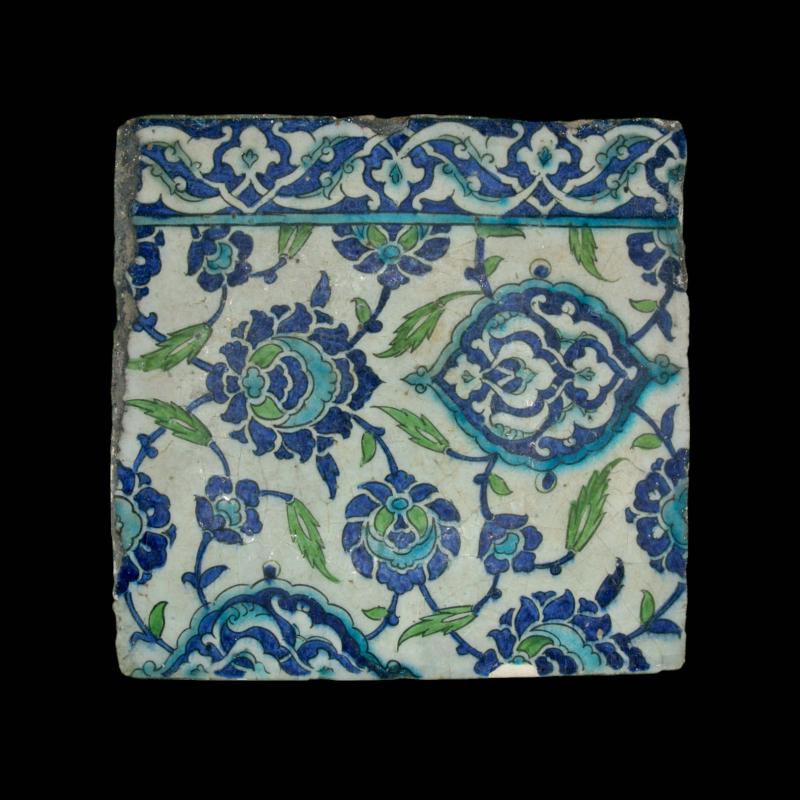
Mattonella Damasco con racemi floreali
Impero Ottomano, tardo XVI-inizio XVII secolo
Mattonella da bordo, in pasta silicea, il fronte dipinto con fiori e foglie intrecciati e fascia di mezze palmette su un lato. Provenienza: collezione privata Nord Italia.
Damascus tile with floral racemes
Ottoman Empire, late 16th – early 17th century
Border tile, made of siliceous paste, the front painted with interlaced flowers and leaves, fitted with a band of split palmettes on one side. Provenance: Private Collection Northern Italy.
H. 29 X L. 28.5 cm
AGGIUDICATO

Pannello di mattonelle Multan
Attuale Pakistan, XIX secolo
Composto da 8 mattonelle montate su pannello in legno, ognuna raffigurante tre hamsa concatenati, due bianchi e uno blu cobalto. Le congiunzioni verticali con le altre mattonelle sono costituite da rombi turchesi. Pattern potenzialmente infiniti come questo alludono ad una delle caratteristiche principali di Dio, ovvero quella di essere senza principio e senza fine. Provenienza: Collezione privata Nord Italia.
Multan tile panel Nowadays
Pakistan, 19th century
Composed of 8 tiles mounted on a wooden board, each depicting three connected hamsa, two of white color and one cobalt blue. The vertical conjunctions with the other tiles are turquoise rhombuses. Potentially infinite patterns such as this allude to one of God’s main characteristics of being with no end and no beginning.
Provenance: Private Collection Northern Italy.
H. 23 X L. 50 cm
AGGIUDICATO

Versatoio in bronzo
India, Deccan, inizio XVIII secolo
Poggiante su base esagonale, il corpo globulare leggermente schiacciato, l¿ansa in forma di dragone stilizzato terminante con cerniera che la congiunge con il tappo a cupola terminante con impugnatura a bocciolo. La superficie decorata estensivamente con motivo a scaglie di pesce e motivo a rete di piccoli rombi su versatoio e collo. Il centro di entrambi i lati del serbatoio decorato con un pavone entro riserva a forma di goccia.
Esamplari di questa forma sono attribuiti da Zebrowski (Gold, Silver & Bronze from Mughal India, Alexandria Press, 1997, p. 164 e 166) all¿India settentrionale o Deccan. Il nostro esemplare sembra da riferire più alla seconda attribuzione, data la sua vicinanza decorativa con i coevi esemplari bidri.
Versatoi come questo venivano utilizzati dalla comunità musulmana per versare l¿acqua necessaria per le abluzioni rituali ed è pertanto una tipologia che si riscontra frequentemente in India dopo la conquista islamica di alcuni suoi territori.A bronze ewer
India, Deccan, early 18th century
Resting on a hexagonal base, the body is globular and slightly flattened, the handle in the form of a stylised dragon terminating in a hinge that joins it to the domed cover terminating in a bud-shaped grip. The surface is extensively decorated with a fish scale pattern and a net motif of small diamonds on spout and neck. The centre of both sides of the container decorated with a peacock within a drop-shaped reserve.
Ewers of this shape are attributed by Zebrowski (Gold, Silver & Bronze from Mughal India, Alexandria Press, 1997, p. 164 and 166) to Northern India or the Deccan. Our specimen seems to relate more to the second attribution, given its decorative similarities to the coeval Bidri manufacture.
Such items were used by the Muslim community to pour water for ritual ablutions and is therefore a type frequently found in India after the Islamic conquest of some of its territories.
31.5 X H. 29 cm

Candeliere zoomorfo in bronzo
India Meridionale, XIX secolo
Fusione in bronzo a patina bruna con stelo centrale raffigurante un leone rampante che poggia le due zampe anteriori sulla testa di un elefante.
A zoomorphic bronze candle stand
South India, 19th century
Bronze casting with brown patina and central stem depicting a rampant lion resting its two front paws on the head of an elephant.
25 X H. 34.5 cm
AGGIUDICATO

Scrigno in bronzo
India, XIX secolo
Rettangolare, poggiante su quattro piedi, il coperchio a prisma, incernierato sul retro. L¿esterno inciso con uccelli con verme nel becco e rosoni geometrici entro profilature con tralci vegetali.
A bronze casket
India, 19th century
Of rectangular shape, standing on four feet, the prism-shaped lid hinged at the back. The exterior engraved with birds with worms in their beaks and geometric rosettes within profiles containing plant motifs.
20.5 X H. 22.5 X P. 15 cm
AGGIUDICATO

Fiasca in terracotta sigillata
India settentrionale, Nizanabad, XIX secolo
In forma di moonflask, in terracotta intagliata con fiore centrale e racemi vegetali.
Sealed earthenware flask
Northern India, Nizanabad, 19th century
In the form of a moonflask, carved earthenware with a central flower and plant racemes.
H. 23 X D. 12.5 cm

Gruppo di tre placche da preghiera (turbah) in argilla
Medio Oriente, XIX-XX secolo
Lotto composto da tre placche in argilla cotta decorate con monumenti sacri della religione Islamica (la Cupola della Roccia e la moschea di Medina) e l¿ultima con iscrizioni.
Tavolette di questo tipo vengono utilizzate soprattutto in ambito sciita come ausilio per la preghiera poichè una delle prescrizioni prevede che la
prostrazione avvenga su suolo oppure su un elemento naturale in mancanza del suolo. Queste tavolette vengono quindi utilizzate come sostituti del suolo.
Group of three clay praying plaques (turbah)
Middle East, 19th – 20th century
Lot consisting of three dry clay plaques decorated with sacred monuments of the Islamic religion (the Dome of the Rock and the Mosque of Medina) and the last one with Arabic inscriptions. Tablets of this type are mainly used in Shiite circles as an aid for prayer as one of the prescriptions requires prostration to take place on the ground or on a natural element in the absence of soil. These tablets are therefore used as substitutes for soil.
H. 7,5 cm (the largest)
AGGIUDICATO
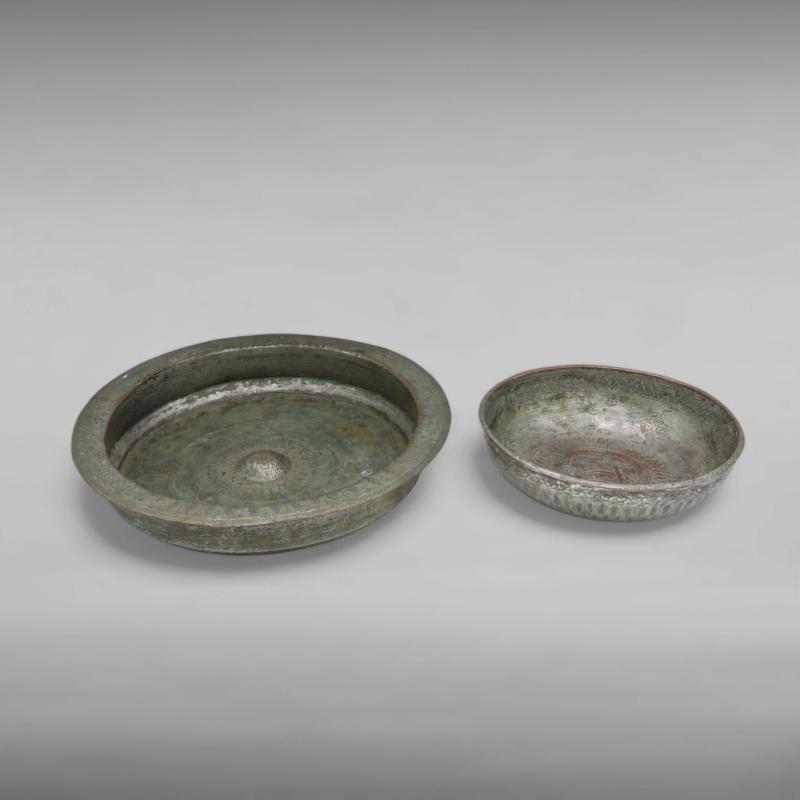
Due contenitori in rame stagnato
Turchia o Levante, XVII secolo
Uno con piccolo umbone centrale, inciso con pesci intorno al centro caratterizzato da piccole frecce stilizzate disposte a raggiera. Il più piccolo (diam. 15 cm) decorato con godronatura esterno, interno inciso con iscrizione centrale e motivi astratti.
Two tin-plated copper containers
Turkey or Levant, 17th century
One with a small central umbo, engraved with fishes around the centre with small stylised arrows arranged in a radial pattern. The smaller one (15 cm diameter) decorated with godrooned motif on the outside, engraved interior with central inscription and abstract motifs.
D. 24 X H. 4.5 cm

Bottiglia Cairoware in ottone intarsiato con argento e rame
Egitto XX secolo
A silver and copper inlaid Cairoware brass bottle
Egypt 20th century
H 27.5 cm

Pezzo di lampada Cairoware in ottone
Egitto, tardo XIX-inizio XX secolo
lastra d¿ottone in forma di pennacchio con ganci di sospensione, l¿esterno inciso con racemi vegetali entro arabeschi intarsiati con filo d¿argento.
Cairoware brass lamp piece
Egypt, late 19th – early 20th century
brass sheet in the form of a flared apex with suspension chains, the exterior engraved with plant racemes within arabesques inlaid with silver thread.
H. 11.7 X 7.5 cm

Libro di preghiere Dorud-e Mostagat
Persia, XVII-XVIII secolo
Manoscritto arabo su carta, composto da 58 carte, completo. Dimensioni del foglio 132 x 80 mm, specchio di scrittura 98 x 50 mm. Testo in calligrafia naskh su singola colonna di 17 linee in inchiostro nero, con parole importanti in inchiostro rosso.
La decorazione comprende quattro frontespizi (unwan) miniati in oro e colori e numerosi titoli dei capitoli in inchiostro bianco o in oro.
Note a margine in persiano vergate in calligrafia nasta¿liq.
Legatura in pelle con ribalta decorata a secco e in oro.
Tracce d’uso e rinforzi su alcune carte, lacuna restaurata nell’ultima carta
Prayer Book (Dor.d-e Mosta..t)
Persia, 17th – 18th century
Arabic manuscript on paper, composed of 58 papers, complete. Folio 132 x 80 mm, writing box 98 x 50 mm. Text in Naskh script on a single column of 17 lines in black ink, with important words in red ink.The decoration includes four frontispieces (unwan) illuminated in gold and colours and numerous chapter titles in white or gold ink. Persian margin notes in nasta’liq calligraphy . Leather binding with flap decorated in red and gold.Traces of use and reinforcement on some papers, restored tear in last paper.
13.5 X 8.5 cm
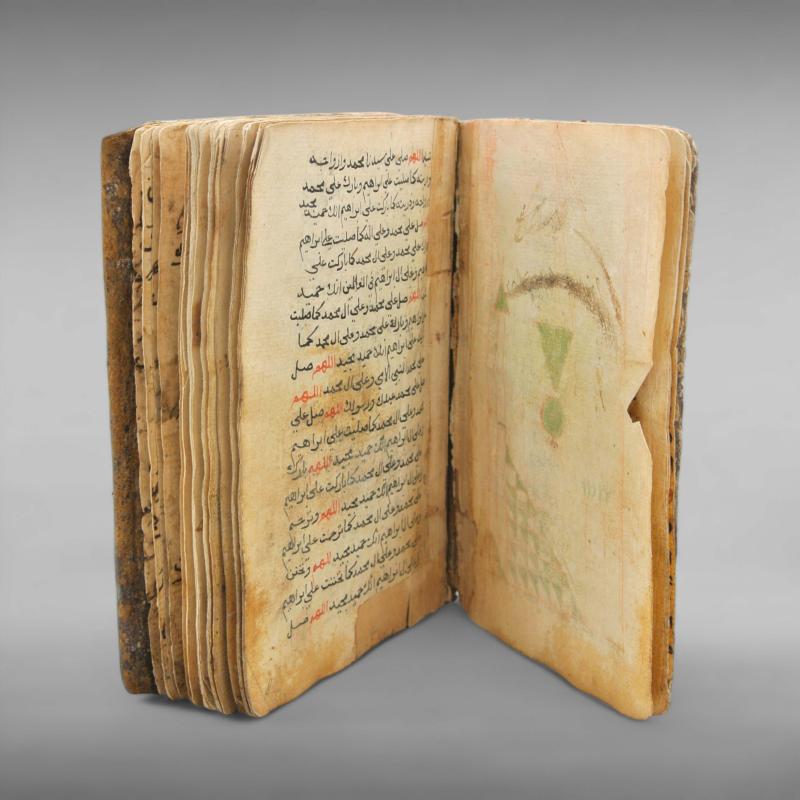
Guida del pellegrino (Dalai al-Khayrat)
Forse Siria, copiato da imam of the Berber ¿a?iliya, datato 1133 AH (1721 AD)
Manoscritto in arabo su carta vergata composto da 49 carte (di cui un paio seriamente danneggiate), completo.
Dimensioni del foglio: mm. 145 x 100 ca.; specchio di scrittura mm. 120 x 65 ca.. Testo in calligrafia naskh vergato con inchiostro nero e parole importanti e titoli in rosso, arrangiato su singola colonna.
L¿apparato decorativo include la raffigurazione del pulpito della moschea di Medina, seppur molto sbiadito.
Legatura in cartone.
Pilgrim’s Guide (Dalai al-Khayrat)
Possibly Syria, copied from Imam of the Berber ‘a.iliya, dated 1133 AH (1721 AD)
Arabic manuscript on laid paper composed of 49 folios (of which a couple are seriously damaged), complete.Folio meas: c. 145 x 100 mm; writing box c. 120 x 65 mm. Text in Naskh calligraphy penned in black ink and important words and titles in red, arranged in a single column. The decoration includes a depiction of the pulpit of the Medina mosque, albeit very faded. Cardboard binding.
14.5 X 11 cm

Juz XXX dal Corano
Cina, XVII-XVIII secolo
Testo in arabo su carta, composto di 53 carte. Testo nella variante cinese della calligrafia naskh, vergato con inchiostro nero e diacritici rossi. Dimensioni del folio: 275 X 200 mm specchio di scrittura 182 X 124 mm delimitato da doppio filetto rosso. Cinque righe per pagina, arrangiate in singola colonna.
Titoli delle sura in rosso, doppio frontespizio (sarlaw) con decorazione geometrica e floreale variopinta su sfondo dorato.
A Chinese 30th Juz of Qur’an
China, 18th century
Arabic text on paper, composed of 53 papers. Text in broad sini calligraphy in black ink with red diacritics and Sura headings. Folio: 275 X 200 mm; writing box 182 X 124 mm bordered by double red lines. Five lines to the page, arranged in a single column. Double frontispiece (sarlaw) with multicoloured geometric and floral decoration on a gilt background.
27,5 X 20 cm
AGGIUDICATO

Manoscritto Fatwa del caffe
Turchia Ottomana, XVIII secolo
Manoscritto su carta polita, vergellata e filigranata, in lingua turca osmanica. Composto da 147 carte in totale per 146 di solo testo.
Foglio: mm. 204 x 133 ca.; schema di scrittura: mm. 136 x 73 ca.; 17 linee di testo vergate con inchiostro nero e rosso.
Frontespizio mancante, ma le prime due pagine recano spazio di scrittura delimitato da filetto dorato.
Il testo consiste in una miscellanea di sentenze legali emesse da celebri giuristi ottomani, tra le quali spiccano quelle dal celebre giureconsulto di scuola hanafita ¿Abu as-Su?ud, noto in turco come Ebusuud.
Manuscript Fatwa of Coffee
Ottoman Turkey, 18th century
Manuscript on polished, laid and watermarked paper, in the Osmanili (Ottoman Turkish) language. Composed of 147 folios, 146 of text only. Sheet: c. 204 x 133 mm; writing rule: c. 136 x 73 mm; 17 lines to the page in black and red ink. Frontispiece missing, but the first two pages bear writing box outlined by gilt fillet. The text consists of a miscellany of legal judgments issued by famous Ottoman jurists, including those by the celebrated jurist of the Hanafite school ‘eAb. as-Su..d, known in Turkish as Ebusuud.
20.4 X 13.8 cm

Frontespizio (Unwan) di Shahnameh
Persia o Kashmir, XVII-XVIII secolo
Testo in persiano su carta. Specchio di scrittura 140 x 135 mm circa sormontato da illuminazione floreale variopinta su sfondo oro con riserve polilobate blu.
Testo in calligrafia nasta¿liq arrangiato in quattro colonne e vergato con inchiostro nero e titoli in rosso. Reclamantes in persiano nel margine inferiore. Restauri. Frontispiece (Unwan) of Shahnameh
Persia or Kashmir, 17th-18th century
Persian text on paper. Script box c. 140 x 135 mm surmounted by multicoloured floral illumination on a gold background with blue poly-lobed reserves. Text in nasta’liq script arranged in four columns and penned in black ink with titles in red. Reclamantes in Persian in the lower margin. Restoration.
280 x 180 mm ca.
AGGIUDICATO

Doppio frontespizio (sarlaw) di Corano
Kashmir, XVIII secolo
Testo in arabo su carta, specchio di scrittura 120 x 60 mm. circa. Testo in calligrafia naskh su singola colonna di 5 linee sul fronte e 13 sul recto, vergate con inchiostro nero e titoli in blu con interlinea dorata. Fine illuminazione floreale variopinta su sfondo blu e oro. Il testo riporta l’inizio della Sura 19. Buone condizioni di conservazione.
Double frontispiece (sarlaw) of Koran
Kashmir, 18th century
Text in Arabic on paper, writing box approx. 120 x 60 mm. Text in Naskh calligraphy on single column of 5 lines to the page at the front and 13 at the back written in black ink and titles in blue with gilt spacing. Fine colourful floral illumination on a blue and gold background. The text contains the beginning of Sura 19.
Good condition.
152 x 93 mm
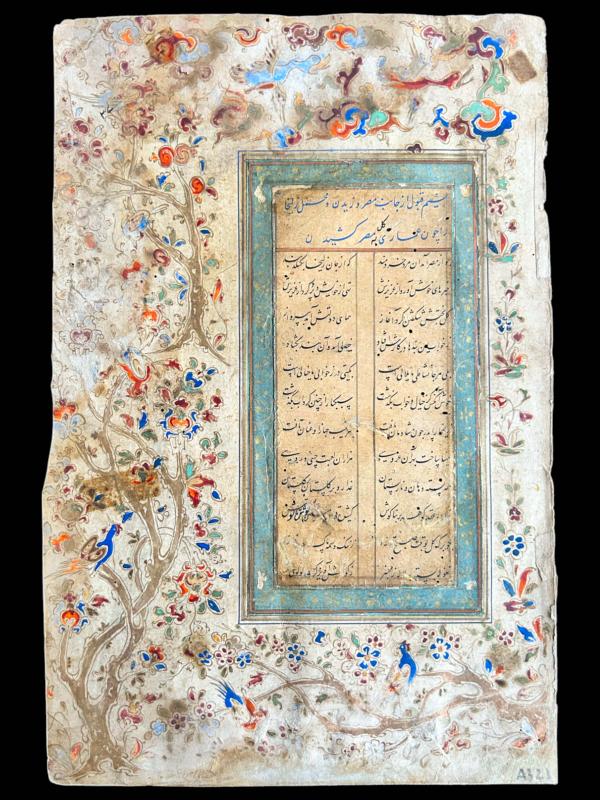
Folio da Yusef e Zoleykha di Jami
India settentrionale, XVII secolo
Testo in persiano su carta, specchio di scrittura mm. 175 x 90 contenente 14 linee di testo sul verso e 12 sul recto con aggiunta del titolo, arrangiate su doppia colonna delimitata da filetto dorato. Testo in calligrafia nasta¿liq in inchiostro nero e titolo in blu.
La decorazione include una bordura sottile allo specchio di scrittura contenente racemi dorati su sfondo azzurro e i margini di pagina dipinti con rami fioriti ed uccelli variopinti sul fronte e riserve lobate tra racemi elementi floreali sul verso. Buone condizioni di conservazione, parti sbiadite nella bordura.
Folio from Yusef and Zoleykha by Jami Northern
India, 17th century
Persian text on paper, writing box 175 x 90 mm containing 14 lines of text on verso and 12 on recto with title added, arranged on double column bordered by gilt fillet. Text in nasta’liq calligraphy in black ink and title in blue. The decoration includes a thin border to the script mirror containing gilt racemes on a blue background and the page margins painted with flowering multicolored branches, birds and clouds on the front and lobed reserves between floral sprays on the reverse.
Good condition, faded areas in the border.
296 x 195 mm
AGGIUDICATO
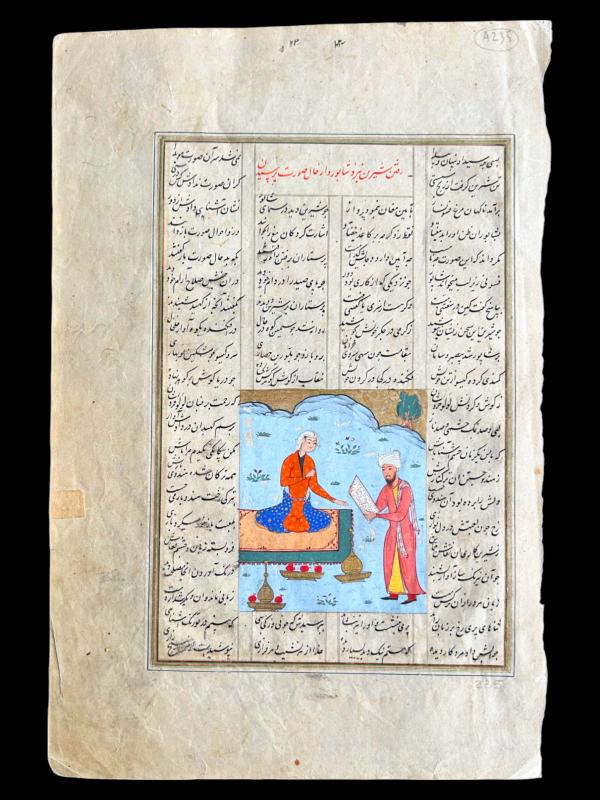
Folio da Khosrow e Shirin di Nizami
Persia, seconda metà XVI secolo
Testo in persiano su carta, specchio di scrittura 200 x 130 mm circa delimitato da filetto dorato e blu e contenente 21 linee di testo su ambo i lati, vergato in calligrafia nasta¿liq in inchiostro nero e titolo in rosso. Decorato con raffigurazione del momento in cui il pittore Shapur che porge il ritratto di Khorsow a Shirin.
Buone condizioni di conservazione.
Folio from Khosrow and Shirin by Nizami
Persia, second half 16th century
Persian text on paper, writing box approximately 200 x 130 mm bordered by gold and blue thread and containing 21 lines of text on both sides, written in nasta’liq calligraphy in black ink with title in red. Decorated with a depiction of the painter Shapur handing Khorsow’s portrait to Shirin.
Good condition.
280 x 180 mm

Bifolio di giornale stampato
Egitto, datato 1247 AH (1831 AD)
Printed newspaper bifolium
Egypt, dated 1247 AH (1831 AD)
35 X 28,8 cm
AGGIUDICATO

Tre pagine da un Corano Mamelucco
Egitto o Siria, XIV secolo
Testo in arabo su carta arrangiato in singola colonna di 5 linee per pagina. Testo in ampia calligrafia nashki,
vergato con inchiostro nero. La decorazione comprende dei separatori di ayat in coma di rosette dorate e puntante di rosso. Margini di sezione in decorazione dorata entro riserve pendenti. Il testo riporta una parte di Sura 7 Al-A’raf.
Three pages from a Mamluk Qur’an
Egypt or Syria, 14th century
Arabic text on paper arranged in a single column, 5 lines to the page. Text in broad nashki calligraphywritten with black ink. The decoration includes ayat separators in the form of gilded and red dotted rosettes. Section margins in gilded decoration within hanging cartouches. The text reads a part of Surah 7 Al-A’raf.
20.8 X 15.5 cm
AGGIUDICATO

Bibbia in arabo
Libro a stampa
Londra, William Watts, 1857 AD
Traduzione in arabo della Sacra Bibbia, Antico e Nuovo Testamento per un totale di 1404 pagine, completo.
Legatura coeva in pelle con impressioni a secco, titolo in oro al dorso.
Stampato dopo l’edizione Roma 1671 per la Chiesa d’Oriente. Una delle prime traduzioni moderne in arabo fu su iniziativa della Society for Promoting Christian Knowledge. Intorno al 1846, la Società ordinò questo lavoro all’orientalista Samuel Lee (1783-1852). Il Rev. Dr. Lee invitò a Cambridge lo studioso libanese Ahmad Faris Shidyaq per partecipare alla traduzione. La traduzione della Bibbia fu pubblicata nel 1857, dopo la morte di Samuel Lee, grazie al suo allievo e amico professor Thomas Jarrett. Questa traduzione è ancora considerata una delle migliori traduzioni arabe della Bibbia. Bibliografia: Darlow & Moulè 1684The Holy Bible in Arabic Printed book
London, William Watts, 1857 AD
Arabic translation of the Holy Bible, Old and New Testament totalling 1404 pages, complete. Coeval leather binding, gold title to the spine.Printed after the Rome 1671 edition for the Eastern Church. One of the first modern translations into Arabic was at the initiative of the Society for Promoting Christian Knowledge. Around 1846, the Society ordered this work from the Orientalist Samuel Lee (1783-1852). The Rev. Dr. Lee invited the Lebanese scholar Ahmad Faris Shidyaq to Cambridge to participate in the translation. The translation of the Bible was published in 1857, after Samuel Lee’s death, by his student and friend Professor Thomas Jarrett. This translation is still considered one of the best Arabic translations of the Bible. Bibliography: Darlow & Moulè 1684.

Manoscritto miscellaneo di carattere medico e filosofico
Persia, fine XVIII – inizio XIX secolo
Manoscritto miscellaneo di carattere medico e filosoficoComposto da 174 carte (25 delle quali non coeve), testo in persiano in calligrafia nastaliq in inchiostro nero e rosso su singola colonna di 25 righe; le prime pagine su tre colonne.
Dimensioni del foglio 205 x 130 mm. specchio di scrittura 170 x 90 mm.
Legatura coeva in pelle con impressioni in oro, ribalta mancante.Miscellaneous manuscript with medical and philosophical subject
Persia, late 18th – early 19th century
Composto da 174 Consisting of 174 papers (25 of which not contemporary), Persian text in nastaliq script in black and red ink on a single column of 25 lines; first pages on three columns.Sheet dimensions 205 x 130 mm. Writing box 170 x 90 mm.Contemporary leather binding with gold decoration, flap missing.carte (25 delle quali non coeve), testo in persiano in calligrafia nastaliq in inchiostro nero e rosso su singola colonna di 25 righe; le prime pagine su tre colonne.
AGGIUDICATO
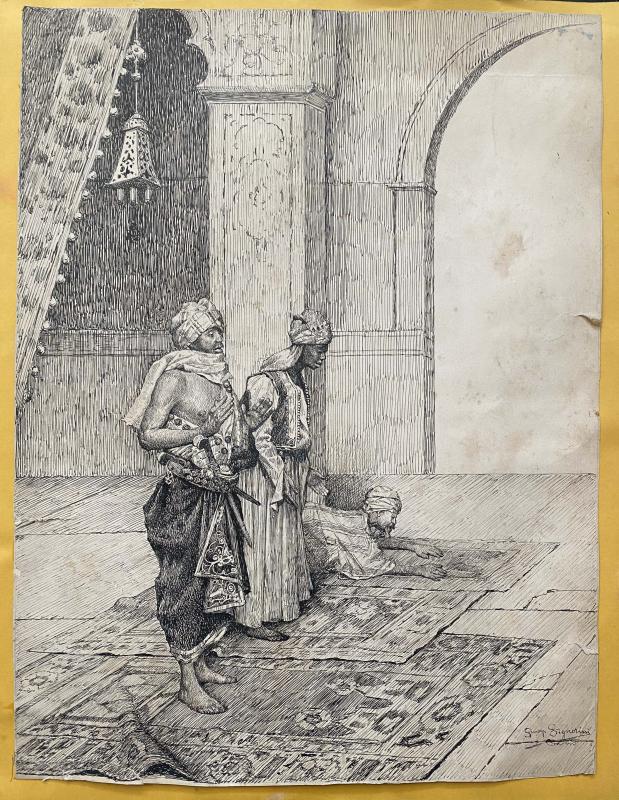
Giuseppe Signorini (1857-1932)
Disegno orientalista raffigurante l¿ora della preghiera
China su carta
Firmato in basso a destra.
Giuseppe Signorini (1857-1932) Orientalist drawing depicting the hour of prayer
Ink on paper.
Signed lower right.
H. 40 X 30 cm
AGGIUDICATO

Due frammenti illustrati da uno Shahnameh
Persia Qajar, XIX secolo
Porzioni di folio, danneggiate e ricomposte, con due illustrazioni di cui una a pagina intera, tratte dal celebre Libro dei Re. Testo in calligrafia nasta¿liq vergato con inchiostro nero ed arrangiato su quattro colonne delimitate da filetto rosso. Provenienza: Collezione privata toscana Two illustrated fragments from a Qajar Shahnameh
Persia, 19th century
Portions of the folio, damaged and recomposed, with two illustrations, one full-page, from the famous Book of Kings. Text in nasta’liq calligraphy penned in black ink and arranged in four columns bordered by red fillet.
Provenance: Private collection Tuscany
33 X 20.5 cm ca. ciascun foglio

Due pagine illustrate da uno Shahnameh
India settentrionale, Kashmir, XIX secolo
Ogni folio reca illustrazione centrale con protagonista Rustam. Testo in persiano su carta, 10 linee sul fronte e 27 sul verso, vergate con inchiostro nero in calligrafia nasta¿liq ed arrangiate su quattro colonne delimitate da filetto dorato. Provenienza: Collezione privata toscana
Two pages illustrated from a dispersed Shahnameh
Northern India, Kashmir, 19th century
Each folio with central illustration featuring the hero of the Book of Kings, Rustam. Persian text on paper, 10 lines to the page at the front and 27 on the reverse, written in black ink in nasta’liq script and arranged in four columns bordered by gilt fillet.
Provenance: Private collection Tuscany.
AGGIUDICATO

Due miniature persiane
Iran, prima metà XX secolo
Una raffigurante una coppia che beve del vino in un giardino, all¿ombra di un cipresso. Illustrazione entro doppia cornice, la bordura più ampia illuminata con palmette intrecciate.
L¿altra raffigurante ritratto di giovane su sfondo monocromo, alla maniera di Reza Abbasi.
Entrambe montate su cartoncino. Provenienza: Collezione privata toscana Two Persian miniature paintings
Iran, first half 20th century
One depicting a couple drinking wine in a garden, close to a cypress tree. Illustration within double frame, the larger border illuminated with interlaced palmettes. The other depicting a portrait of a young man against a monochrome background, in the manner of Reza Abbasi. Both mounted on cardboard.
Provenance: Private collection Tuscany
29.5 X 21 cm (la più grande, misure complessive di cartoncino)
AGGIUDICATO
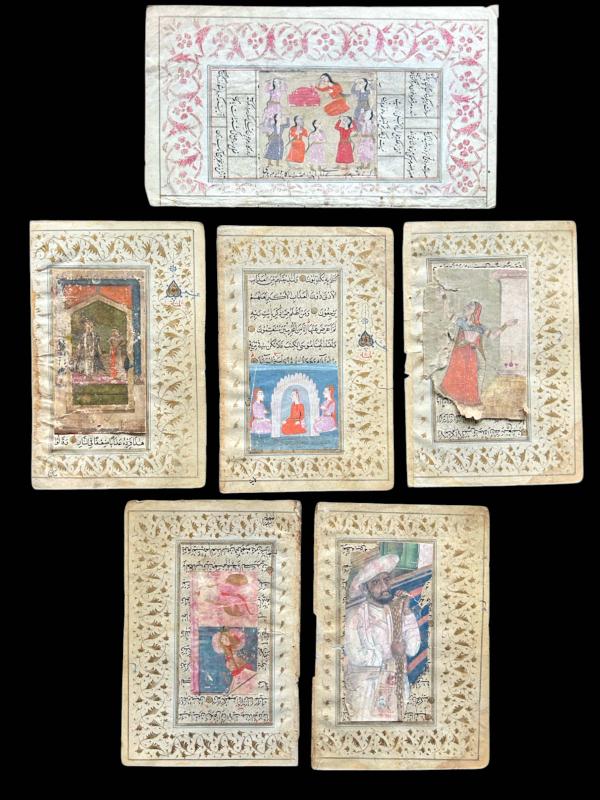
Lotto di 6 pagine con illustrazioni applicate
Persia e India settentrionale, XIX secolo e posteriore
Un gruppo di cinque fogli provenienti da un Corano persiano rielaborato con l¿affissione di illustrazioni di ambito indiano.
Il Corano vergato in calligrafia naskh, testo in arabo su carta, 11 linee di testo per pagina, separatori di ayat in forma di rondelle dorate, diacritici rossi, note a margine in persiano. Bordura illuminata con tralci vegetali dorati.
Quasi tutte le illustrazioni applicate sopra il testo sono di ambito indiano, tra cui un Krishna Srinathji ed un uomo in stile Company School.
L¿ultimo foglio tratto da un manoscritto poetico persiano, manomesso con illustrazione di una lamentazione funebre. Testo in persiano su carta, vergato in calligrafia nasta¿liq ed arrangiato su due colonne sfasate. Illuminazione floreale a stampo nella bordura. Provenienza: Collezione privata toscana Lot of 6 folios with applied illustrations
Persia and Northern India, 19th century and later
A group of five folios from a Persian Qur’an manumitted with illustrations from an Indian context. The Qur’an written in naskh script, Arabic text on paper, 11 lines to the page, ayat separators in the form of gilt rosettes, red diacritics, margin notes in Persian. Illuminated border with gilt plant sprays. Almost all the illustrations applied above the text are Indian, including a Krishna Srinathji and a man in Company School style.The last sheet from a Persian poetic manuscript, tampered with an illustration of a funeral lamentation. Persian text on paper, written in nasta’liq calligraphy and arranged in two offset columns. Stenciled floral illumination in the border.
Provenance: Private collection Tuscany
23.5 X 13.3 cm la più grande

Ritratto di cortigiana
Iran Qajar, XIX secolo
Ritratto di nobildonna stante si sfondo incolore. Bordura in carta marmorizzata e montata su cartoncino. Timbro, probabilmente afferente alla cancelliera persiana, sulla destra del ritratto. Provenienza: Collezione privata toscana Portrait of a woman Qajar
Iran, 19th century
Portrait of a noblewoman standing against a colourless background. Marbled paper border and mounted on cardboard. Stamp, probably belonging to the Persian chancellor, on the right of the portrait.
Provenance: Private collection Tuscany.
19.6 X 13.4 cm (con cartoncino: 25 X 20 cm)
AGGIUDICATO

Tre fogli illustrati da manoscritti poetici persiani
Persia, probabilmente Shiraz, XVII-XVIII secolo
Decorati e iscritti su entrambi i lati in calligrafia nasta¿liq vergata con inchiostro nero ed arrangiata in quattro colonne delimitate da filetto dorato. Il foglio più grande illustrato con una scuola in cui il maestro impartisce la lezione a a cinque alunni in un giardino, l¿altro decorato con uomo a cavalcioni di un leone tra astanti; l’ultimo illustrato con Layla e Majnun.
Provenienza: Collezione privata toscana.Three illustrated folios from Persian poetic manuscripts
Persia, probably Shiraz, 17th-18th century
decorated and inscribed on both sides in nasta’liq script written in black ink and arranged in four columns bordered by gilt fillet. The larger folio illustrated with a schoolmaster giving a lesson to five pupils in a garden, the other decorated with a man taming a lion among onlookers.
Provenance: Private collection Tuscany.
27 X 15 cm ca. (the largest)
AGGIUDICATO

Tre pagine illustrate da uno Shahnameh
Kashmir, XIX secolo
Inchiostro e colori su carta, ogni pagina contiene un¿illustrazione e quattro o sei linee di testo in persiano vergato con inchiostro nero e arrangiato su due colonne delimitate da filetto rosso. Three illustrated folios from a Shahnameh
Kashmir, 19th century
Ink and colours on paper, each page contains an illustration and four to six lines of Persian text penned in black ink and arranged in two columns bordered by red thread.
10 X H. 20 cm (frame: 25.5 X h. 35.5 cm )
AGGIUDICATO

Tre pagine illustrate da uno Shahnameh
Kashmir, XIX secolo
Inchiostro e colori su carta, ogni pagina contiene un¿illustrazione e quattro o sei linee di testo in persiano vergato con inchiostro nero e arrangiato su due colonne delimitate da filetto rosso. Three illustrated folios from a Shahnameh
Kashmir, 19th century
Ink and colours on paper, each page contains an illustration and four to six lines of Persian text penned in black ink and arranged in two columns bordered by red thread.
10 X H. 20 cm (frame: 25.5 X H. 35.5 cm )
AGGIUDICATO
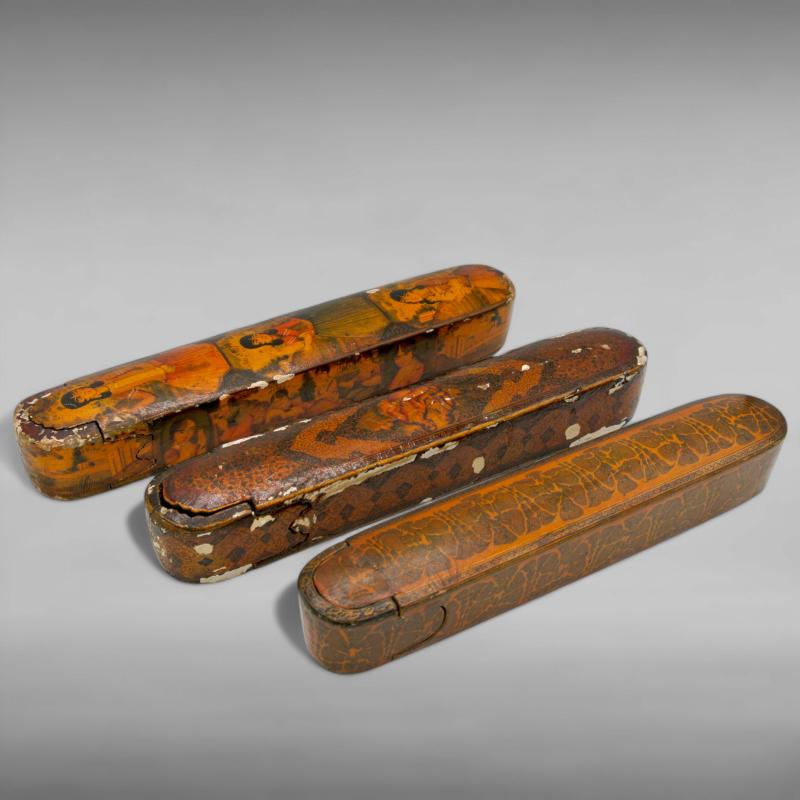
Gruppo di tre Porta penne (Qalamdam) persiani in papier machè
Iran Qajar, XIX secolo.
Con vassoio scorrevole, uno decorato con motivo figurativo, uno con arabeschi entro medaglioni lobati ed uno con motivo vegetale ripetuto su sfondo ocra.
Group of three Persian pen holders (Qalamdam) in papier machè
Qajar Iran, 19th century
With sliding tray, one decorated with a figurative motif, one with arabesques within lobed medallions and one with a repeated plant motif on an ochre background.
L. 23 cm the largest
AGGIUDICATO

Dipinto persiano raffigurante sufi e ragazza
Iran, XX secolo
Raffigurante un anziano sufi che conforta una donna nei pressi di una tomba. Iscrizione poetica in calligrafia Nasta¿liq nella cornice interna.
Persian painting depicting a Sufi and a girl
Iran, 20th century
Depicting a Sufi elder comforting a woman near a tomb. Poetic inscription in Nasta’liq calligraphy in the inner frame.
H. 21 X l. 15.5 (frame: 34 X 23.5 cm)

Documento commerciale su carta vergata
Persia o Azerbaijan, XIX secolo
Testo in azero su carta, composto da 9 righe di testo scritte in inchiostro nero in diwan corsivo.
Timbro persiano in alto a destra con il nome di Muhammad Ali Abd. Datato ’43 (forse 1243 AH, ovvero 1827 AD solare)
Trade document on blank paper
Persia or Azerbaijan, 19th century
Turk Azerbaijani text on paper, consisting of 9 lines of text written in black ink in cursive diwan.Persian stamp in upper right corner inscribed with the name of Muhammad Ali Abd. Dated 43 (possibly 1243 AH equal to 1827 AD solar calendar).
H. 38.2 X 22.2 cm
AGGIUDICATO
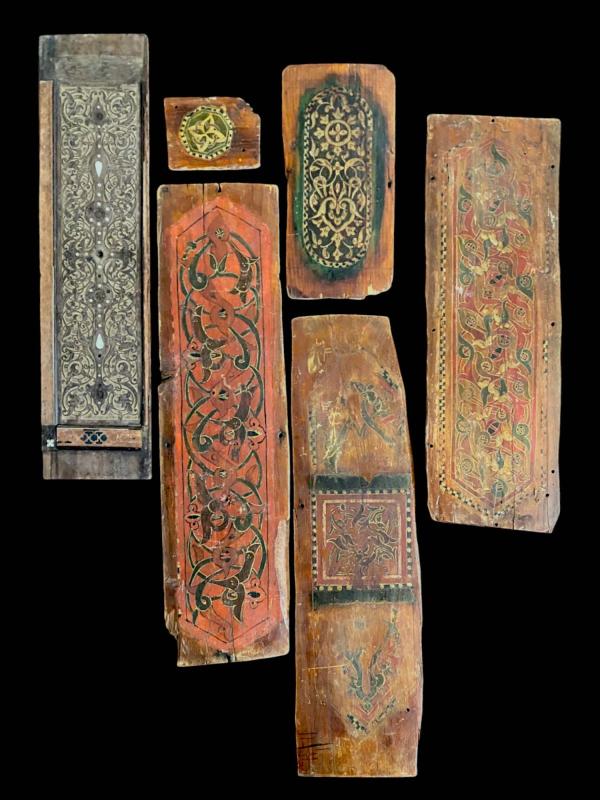
Gruppo di sei pannelli in legno dipinto con arabeschi. Nord Africa o Vicino Oriente, XIX secolo
Gruppo di travi decorative con fronte dipinto con palmette intrecciate nei toni del giallo, rosso e verde. Group of six wooden panels painted with arabesques
North Africa or Near East, 19th century
Group of decorative beams with front painted with interlaced yellow, red and green palmettes.
77,5 X 20 cm (the largest

Gruppo di tre disegni
India, XIX-XX secolo
Include: Un dipinto raffigurante caccia al cinghiale; un dipinto raffigurante Durga e un dipinto raffigurante una coppia di elefanti e mahout, firmato in basso a destra. Provenienza: collezione privata veneta.
Group of three drawings
India, 19th-20th century
Including:a drawing of boar hunting; Durga and a pair of elephants and mahouts, signed lower right. Provenance: Venetian private collection.
H 22 X L. 34 cm (the largest)

Gruppo di tre disegni
India, XIX-XX secolo
Include: un disegno raffigurante Shiva; ritratto di Akbar in profilo; un disegno raffigurante un elefante ed una donna di profilo. Provenienza: collezione privata veneta.Group of three drawings
India, 19th – 20th century
Including: a drawing of Shiva; a portrait of Akbar in profile; a drawing of an elephant and a woman in profile.
Provenance: Venetian private collection.
H. 21 X L. 16,2 cm (the largest)
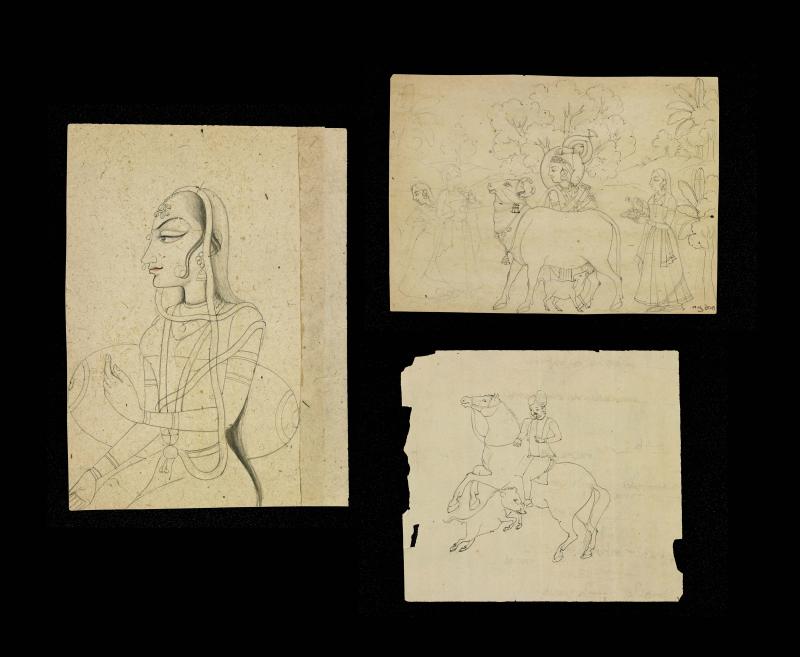
Gruppo di tre disegni
India, XIX-XX secolo
Include: Un disegno caccia al cinghiale; un disegno raffigurante Krishna con le gopies (firmato in basso a destra), un ritratto di donna di profilo, Kishengarh. Provenienza: collezione privata veneta.
Group of three drawings
India, 19th – 20th century
Including: A boar hunting; a drawing of Krishna with gopies (signed lower right); a portrait of a woman in profile, Kishengarh.
Provenance: Venetian private collection.
H. 22 X L. 16 cm (the largest)
AGGIUDICATO
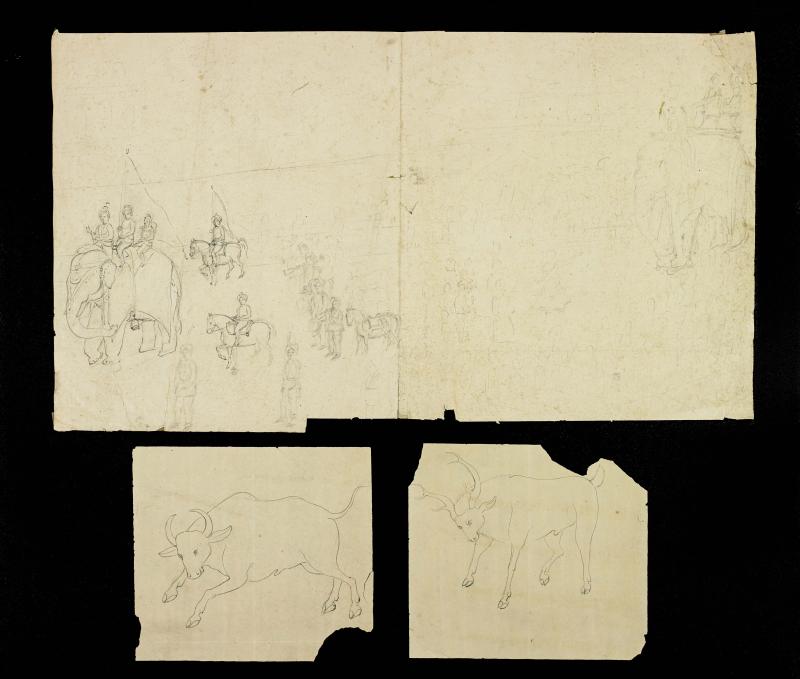
Gruppo di tre disegni
India, XIX-XX secolo
Include: uno schizzo raffigurante processione regale; un bufalo in corsa ed un ariete. Provenienza: collezione privata veneta.
Group of three drawings
India, 19th – 20th century
Including: a sketch depicting a royal procession; a running buffalo and a ram.
Provenance: Venetian private collection.
H. 27 X L. 47,5 cm (the largest)
AGGIUDICATO

Disegno raffigurante un leone
India, XIX-XX secolo
Disegno a matita su carta raffigurante un leone in atteggiamento fiero sopra la testa mozzata di un uomo. Provenienza: Collezione privata toscana Drawing depicting a lion
India, 19th – 20th century
Pencil sketch on paper depicting a lion in a proud attitude above the severed head of a man.
Provenance: Private collection Tuscany.
10 X 15.4 cm

Shri Nathji in un padiglione rosa.
Nathdwara, metà-fine del XIX secolo.
Pittura su carta
Il dipinto rappresenta una celebrazione che si svolge nel tempio Shri Nathji di Nathdwara, nel Rajasthan. Shri Nathji, l’icona più importante del Vallabha Sampradaya, è una scultura in marmo nero che rappresenta Krishna bambino con il braccio sinistro sollevato nella posizione di tenere in alto il monte Govardhan. L’icona indossa un mantello a quattro punte di colore zafferano con rifiniture in argento ed è collocata in un padiglione rialzato ricoperto di rose rosa. La liturgia, eseguita dal sacerdote a sinistra, è stata probabilmente sponsorizzata dalla famiglia di devoti in piedi a destra.
Provenienza: collezione privata veneta.Shri Nathji in a pink pavilion
Nathdwara, mid- to late 19th century
The painting depicts a celebration taking place in the Shri Nathji temple of Nathdwara, Rajasthan. Shri Nathji, the most important icon of the Vallabha Sampradaya, is a black marble sculpture that represents Krishna as a child with the left arm raised in the stance of keeping mount Govardhan aloft. The icon wears a four-pointed full-length coat in saffron color with silver trimming and it is placed in a raised pavilion covered with pink roses. The liturgy, performed by the priest on the left, was probably sponsored by the family of devotees standing on the right. Provenance: Venetian private collection.
H. 26,8 x 34,7 cm
AGGIUDICATO

Dipinto raffigurante Inferno
India settentrionale o Nepal, XVIII-XIX secolo
Tempera su carta, raffigurante una multitudine di personaggi ingaggiati in torture e trapassi su sfondo verde. Non è stato possibile distinguere chiaramente a quale religione indiana sia attribuibile, forse assimilabile ai sette livelli dell¿inferno jainista.
Painting depicting the underworld
Northern India or Nepal, 18th – 19th century
Tempera on paper, depicting a multitude of characters engaged in torture and passings on a green background. It has not been possible to clearly distinguish to which Indian religion it is attributable, perhaps close to the seven levels of Jain hell.
H. 35 X 45.4 cm
AGGIUDICATO

Ritratto di Maharaja Sikh
India Settentrionale, Pahari, XIX secolo. Gouache su carta
Raffigurante un sovrano, forse Maharaja Sher Singh (r. 1841-1843) mentre fuma la pipa ad acqua su un terrazzo, seduto su un tappeto floreale con sfondo rosso. Provenienza: Collezione privata Toscana.
Portrait of Sikh Maharaja
Northern India, Pahari, 19th century
Gouache on paper.
Depicting a ruler, possibly Maharaja Sher Singh (r. 1841-1843) smoking a water pipe on a terrace, seated on a floral carpet with a red background.
Provenance: Private collection Tuscany.
H. 26 X 18.5 cm (h. 34 X 26 cm complessivo)

Scena di caccia
India Centro Meridionale, forse Deccan, XIX-inizio XX secolo
Dipinto a gouache su cartoncino raffigurante due uomini a cavalcioni, uno di un cavallo rampante, l¿altro di un elefante. Sfondo a vivaci colori: celeste e blu per il cielo ed un verde ombreggiato per il terreno. Provenienza: Collezione privata toscana Hunting scene
Central to South India, possibly Deccan, 19th – early 20th century
Gouache painting on cardboard depicting two men riding, one on a prancing horse, the other on an elephant.
Provenance: Private collection Tuscany.
12.8 X 17.9 cm
AGGIUDICATO

Ritratto di Thakur
India Centro-Meridionale, Deccan, prima metà XX secolo
Ritratto di nobile a cavallo, preceduto e seguito da stallieri. Lo stile è molto stilizzato e lo sfondo caratterizzato da un moderno verde acceso. Dettagli in oro. Provenienza: Collezione privata toscana Portrait of Thakur
Central-South India, Deccan, first half 20th century
Portrait of a nobleman on horseback, preceded and followed by grooms. The style is highly stylised and the background characterised by a modern bright green. Details in gold.
Provenance: Private collection Tuscany.
29.7 X 20.2 cm

Dipinto Sikh raffigurante una scena di corte
India Settentrionale, Pahari, Guler, prima metà XIX secolo. Gouache su carta
Entro raffinata ambientazione caratterizzata da un sontuoso edificio in marmo bianco con intarsi e ceselli floreali, la scena conta sei personaggi Sikh altolocati disposti due per arcata, l¿ultima sulla destra comprende anche un inserviente nell¿angolo, tutti sotto una tettoia arancione. I personaggi si distinguono per le vesti curate e variopinte e i turbanti tipici della religione Sikh. Protagonisti principali in posizione centrale, sulla sinistra della composizione un attendente sventola lo scacciamosche e sulla destra uno dei personaggi sta per porgere un drappo bianco.
Guler fu amministrata da sovrani Sikh dal 1813 al 1849 quando cadde nelle mani deli inglesi. Durante questo periodo gli artisti di Guler ottennero molte commissioni da mecenati Sikh e questo dipinto si situa in questo contesto. Provenienza: Collezione privata Toscana.Sikh painting depicting a courtly scene
Northern India, Pahari, Guler, first half 19th century
Gouache on paper.
Within a refined setting characterised by a sumptuous white marble building with floral inlays and chiselling, the scene has six high-ranking Sikh characters arranged two per archway, the last on the right also including an attendant in the corner, all under an orange canopy. The characters are in their well-groomed and colourful robes and turbans typical of the Sikh religion. The main characters are in a central position, on the left of the composition an attendant is waving a fly-whisk and on the right one of the characters is carrying a white drape.
Guler was administered by Sikh rulers from 1813 to 1849 when it fell into British hands. During this period the artists of Guler obtained many commissions from Sikh wealthy patrons and this painting fits into this context.
Provenance: Private collection Tuscany.
H. 22 X L. 31.5 cm (h. 27 X 40 cm complessivo)
AGGIUDICATO

Dipinto Sikh raffigurante una scena di corte
India Settentrionale, Pahari, XIX secolo. Gouache su carta
Raffinata miniatura probabilmente raffigurante il giovane Maharaja Nau Nihal Singh (r. 1821 ¿ 1840) seduto su un trono dorato nel padiglione esterno di un palazzo ed intento a godersi uno spettacolo di danza tradizionale (Nautch). La composizione è piuttosto affollata e conta suonatori sulla destra, attendenti del sovrano sulla sinistra e due danzatrici nel centro di un enorme tappeto con decorazione floreale su sfondo rosso. Architetture in marmo bianco e foresta in lontananza, oltre il parapetto che situa la scena in una terrazza. Provenienza: Collezione privata Toscana.
Sikh painting depicting a courtly scene
Northern India, Pahari, 19th century
Gouache on paper
A refined miniature painting possibly depicting the young Maharaja Nau Nihal Singh (r. 1821 – 1840) seated on a gilded throne in the outer pavilion of a palace, enjoying a traditional dance (Nautch) performed by two ladies. The composition is quite crowded and features players on the right, attendants of the ruler on the left and two dancers in the centre of a huge carpet with floral decoration on a red background. White marble architecture and forest in the distance, beyond the parapet that locates the scene on a terrace.
Provenance: Private collection Tuscany.
H. 28.5 X L. 40 cm (33 X 45 cm complessivo)
AGGIUDICATO

Dipinto Sikh raffigurante due figli di Raja Gulab Singh di Jammu
India Settentrionale, Pahari, XIX secolo
Gouache su carta
Gulab Singh fu un alto ufficiale alla corte dell’Imperatore Sikh Maharaja Ranjit Singh e uno dei capi più potenti dell¿impero Sikh. Dopo la morte di Ranjit Singh nel 1839, Gulab Singh continuò a giocare un ruolo cruciale nella politica della regione e successivamente divenne il Maharaja di Jammu e Kashmir. Gulab e suo fratello Dhian furono figure preminenti nella storia di Jammu e Kashmir del XIX secolo, tanto da passare alla storia con l¿epiteto di ¿fratelli Dogra¿ dal nome della regione storica Duggar.
A Gulab successe il terzi figlio, Ranbir, mentre i primi due, Udham e Sohan, ritratti in dialogo in questo dipinto, morirono giovani. I due fratelli sono raffigurati seduti su un tappeto, affiancati da quattro attendenti, di cui due con scacciamosche. Le fontane d¿acqua nella porzione più bassa del dipinto sono indicative di un giardino regale, cos’ come lo sono gli edifici in marmo bianco e il pavone sulla sinistra. Vegetazione lussureggiante ed estremamente dettagliata. Provenienza: Collezione privata Toscana.
Sikh painting depicting two sons of Raja Gulab Singh of Jammu
Northern India, Pahari, 19th century
Gouache on paper.
Gulab Singh was a high official in the court of the Sikh Emperor Maharaja Ranjit Singh and one of the most powerful leaders of the Sikh empire. After Ranjit Singh’s death in 1839, Gulab Singh continued to play a crucial role in the politics of the region and later became the Maharaja of Jammu and Kashmir. Gulab and his brother Dhian were prominent figures in the history of 19th century Jammu and Kashmir, so much so that they are called the ‘Dogra brothers’ after the historical Duggar region.
Provenance: Private collection Tuscany.
H. 22 X l. 27.5 cm (26.5 X L. 38.5 cm complessivo)
AGGIUDICATO
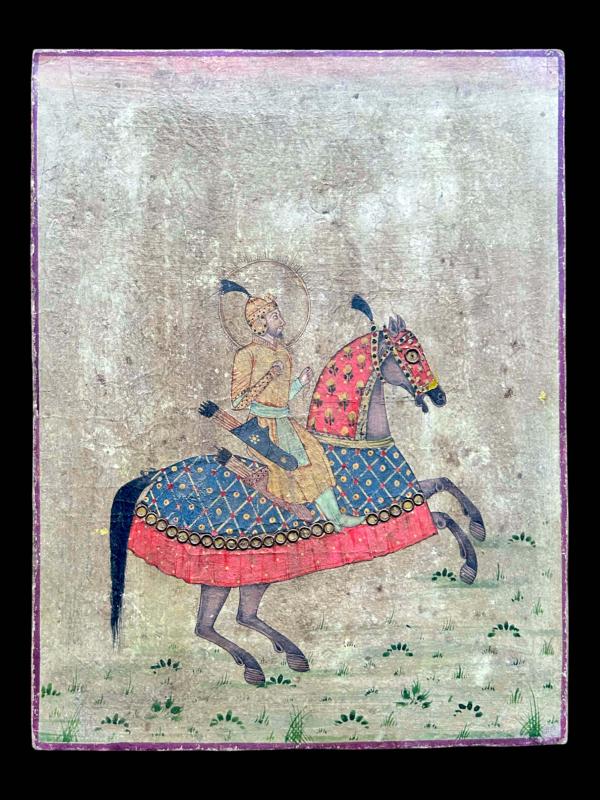
Ritratto equestre di Aurangzeb
India Sultaniale, forse Deccan, XVIII -XIX secolo
Raffigurante l¿ultimo dei grandi Mogul di profilo su un cavallo rampante. Sfondo incolore e terreno vivacizzato da sparuti fili d¿erba. Provenienza: Collezione privata toscana Equestrian portrait of Aurangzeb Sultanate
India, possibly Deccan, 18th – 19th century
Depicting the last of the great Moghals in profile, riding a prancing horse. Colourless background and soil with scattered grass plants. Provenance: Private collection Tuscany.
28 X 21.5 cm
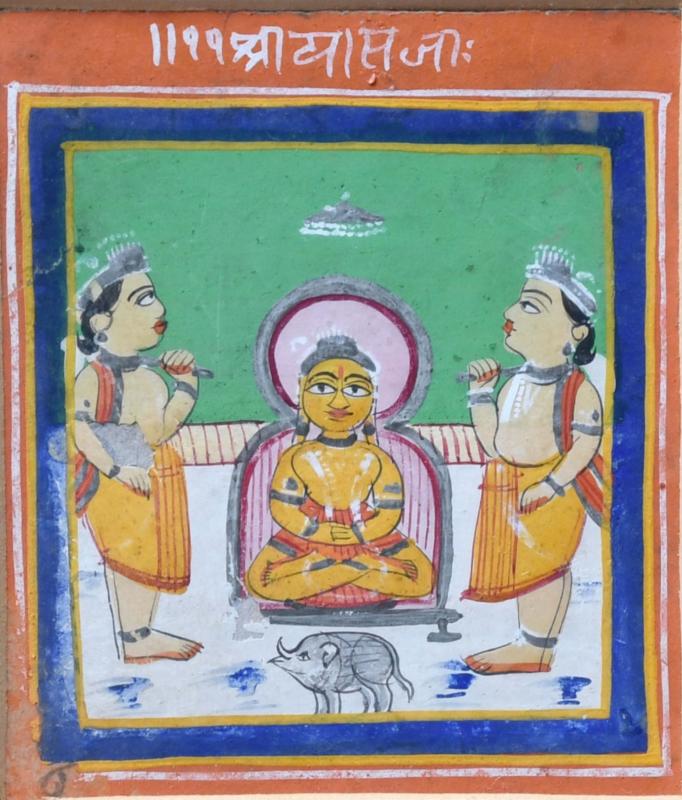
Piccola miniatura Jainista raffigurante Vimalanatha
India settentrionale, XIX secolo
Tempera su carta, raffigurante il tredicesimo tirthankara dell¿era attuale, seduto in padmasana, affiancato da due attendenti. Breve iscrizione in devanagari sul bordo superiore.
Small Jain devotional painting depicting Vimalanatha
Northern India, 19th century
Tempera on paper, depicting the thirteenth tirthankara of the present era, seated in padmasana, flanked by two worshippers. Short devanagari inscription on the upper edge.
H. 8 X L. 7 cm
AGGIUDICATO

Dipinto raffigurante una coppia
India Mogul, tardo XIX secolo
Tempera e oro su carta, probabilmente parte di un Ragamala, un soggetto molto diffuso nell¿India Rajput, raffigurante i modi musicali indiani e ripreso negli atelier dei pittori Mughal sin dal XVII secolo.
Il dipinto raffigura una coppia seduta su un tappeto floreale in una terrazza dall¿architettura in marmo bianco con intarsi di pietre dure dai decori floreali. Dalla porta sulla sinistra della composizione entra un¿ancella con un vassoio di refrigeri in mano. Le due fontane zampillanti in basso ci indicano l¿ambientazione in un chaharbagh (giardino quadripartito) Mogul.
Painting depicting a couple Mogul
India, late 19th century
Tempera and gold on paper, probably part of a Ragamala, a popular subject in Rajput India, depicting Indian musical modes and adopted in the Mughal ateliers since the 17th century.The painting depicts a couple sitting on a floral carpet on a terrace with white marble architecture inlaid with semiprecious stones with floral decorations. Through the door on the left of the composition, a handmaiden enters with a tray of refreshments in her hand. The two gushing fountains at the bottom indicate the setting in a Mogul chaharbagh (quadripartite garden).
H. 22 X L. 15 cm

Folio di manoscritto raffigurante Durga
Nepal, XIX secolo
Un lato raffigura Durga armata stante sulla sua cavalcatura, il leone, e trionfante sul demone bufalo. Il retro reca dodici linee di testo in devanagari. Provenienza: Collezione privata toscana A leaf from a manuscript depicting Durga
Nepal, 19th century
One side depicts armed Durga standing on her mount, the lion, and triumphant over the buffalo demon. The reverse side bears twelve lines of text in Devanagari.
Provenance: Private collection Tuscany
11.4 X 14.1 cm
AGGIUDICATO
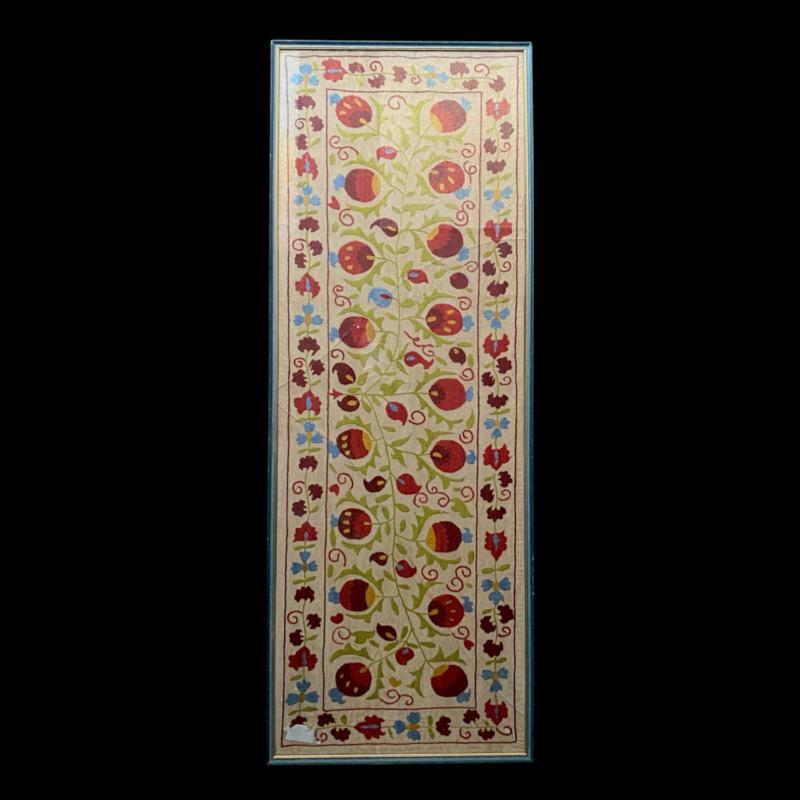
Frammento di tessuto Suzani
Turchia o Centro Asia, prima metà XX secolo
Ricamo con fili di cotone colorati nel classico stile Suzani, raffigurante racemi floreali entro grande riserva rettangolare bordata con elementi vegetali più piccoli.
A Suzani fabric fragment
Turkey or Central Asia, first half 20th century
Embroidery with coloured cotton threads in the classic Suzani style, depicting floral racemes within a large rectangular reserve bordered with smaller plant elements.
AGGIUDICATO
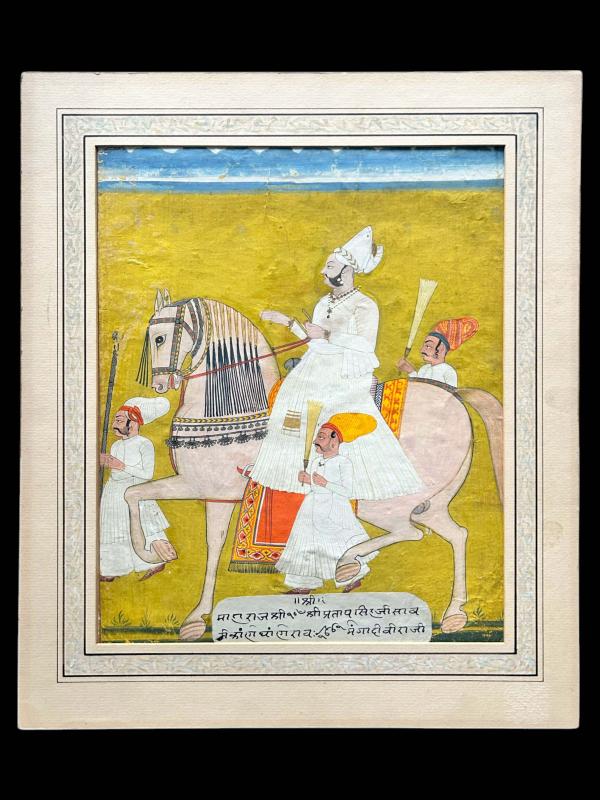
Ritratto equestre di thakur
India Settentrionale, Rajasthan, Marwar, XIX secolo
Raffigurante nobile a cavallo, preceduto dallo stalliere e seguito da due attendenti con scacciamosche. Sfondo verde e cielo blu nella sottile striscia sul margine superiore del dipinto.
Tre righe di iscrizione in devanagri nel cartiglio sotto il cavallo nominano il protagonista Shri Maharaja Shri Pratapasi Jisava, diversi titoli onorifici, ma non è stato possibile identificarlo con precisione. Sul retro del dipinto è stampato il timbro della collezione di Kumar Sangram Singh, Thakur di Nawalgarh, una regione storica nel Rajasthan. Il timbro classifica il dipinto al n. 6 della collezione. Kumar Sangram Singh era noto per essere un patrono delle arti e possedeva diversi manoscritti e opere d¿arte.Equestrian portrait of Thakur
Northern India, Rajasthan, Marwar, 19th century
Depicting a nobleman on horseback, preceded by the groom and followed by two attendants with fly-whisks. Green background and blue sky in the thin strip on the upper margin of the painting.
Three lines of inscription in Devanagri in the cartouche below the horse name the protagonist as Shri Maharaja Shri Pratapasi Jisava, various honorary titles, but it was not possible to identify him precisely.
The back of the painting bears the stamp of the collection of Kumar Sangram Singh, Thakur of Nawalgarh, a historical region in Rajasthan. The stamp classifies the painting as No. 6 in the collection. Kumar Sangram Singh was active in the XX century and known to be a patron of the arts, owing also several manuscripts, paintings and works of art.
H. 30.6 X L. 24.8 cm
AGGIUDICATO
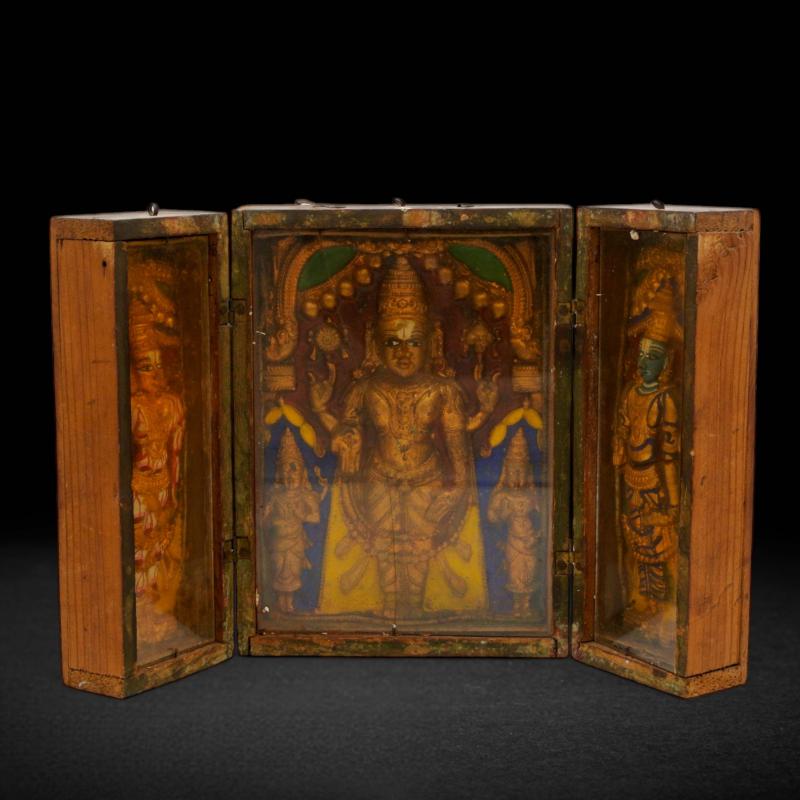
Altare Vaishnava portatile
India Meridionale, Thanjavur, XIX secolo
rettangolare, in legno con divinità in stucco policromo e dorato protetto da vetro. In centro campeggia la figura di Vishnu affiancato da due personaggi, probabilmente i donatori. Nelle ante laterali due divinità in varadamudra.
Portable Vaishnava altar
South India, Thanjavur, 19th century
rectangular, made of wood with deities in polychrome and gilded stucco protected by glass. In the centre stands the figure of Vishnu flanked by two figures, probably the donors. In the side wings two deities in varadamudra.
H. 19.7 X L. 14.7 X P. 7 cm
AGGIUDICATO
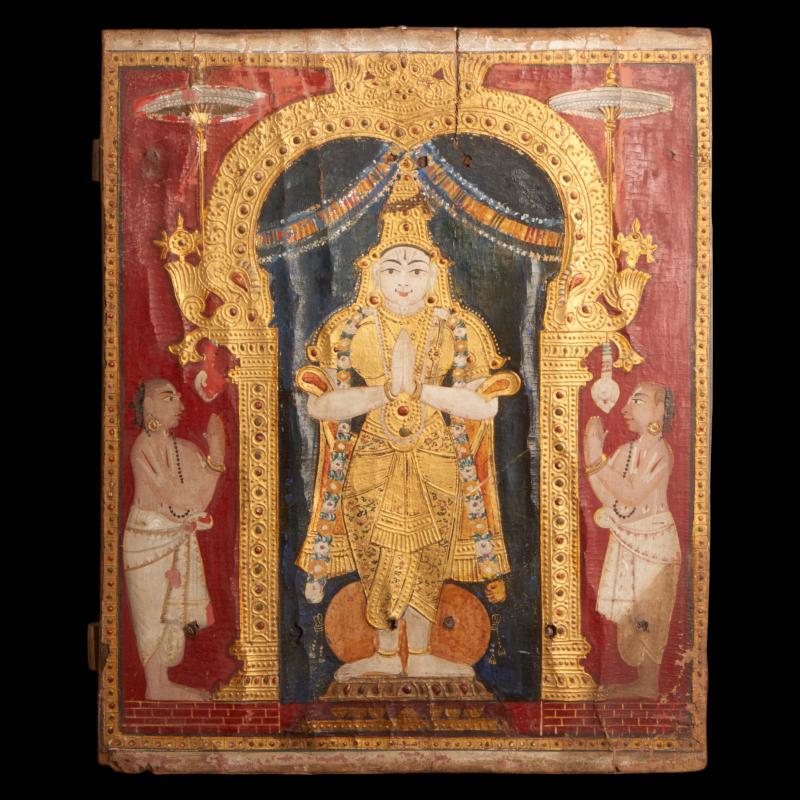
Dipinto Thanjavur. India Meridionale, Tamil Nadu, XIX secolo
Pigmenti e stucco su tavola
Bel dipinto devozione nel classico stile di Thanjore, raffigurante raro soggetto di divinità femminile entro arco dorato corredato di due parasole onorifici. La divinità è affiancata da due brahmini con le mani giunte al petto in anjalimudra. Difetti.Thanjavur painting
Southern India, Tamil Nadu, 19th century
Pigments and stucco on board
A fine devotional painting in the classical Thanjore style, depicting a rare subject of a female deity within a gilded arch with two honorary canopies. The deity is flanked by two Brahmins with their hands joined to their chests in anjalimudra.
Defects.
33 X H. 40 cm
AGGIUDICATO
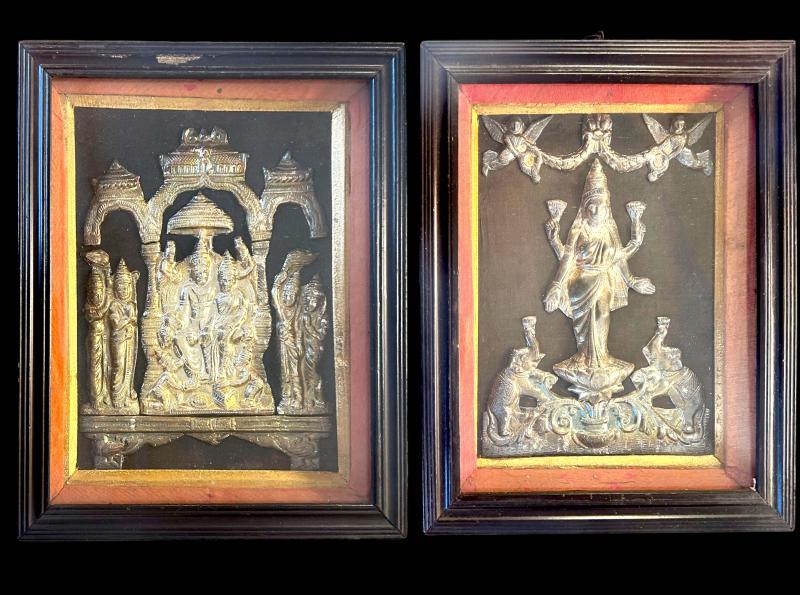
Due composizioni in argento sbalzato
India Meridionale, tardo XVIII inizio XIX secolo
L¿uno raffigurante i festeggiamenti per la liberazione di Sita da Lanka entro arco tripartito che inquadra Rama, Sita e Humayun in posizione centrale e attendenti ai lati.
L¿altro raffigurante Gajalakshmi con due elefanti e sormontata da festoni in stile barocco europeo.
Two embossed silver devotional figures
Southern India, late 18th – early 19th century
One depicting the celebration from the liberation of Sita from Lanka within a tripartite arch framing Rama, Sita and Humayun in a central position with attendants on either sides.The other depicting Gajalakshmi with two elephants and surmounted by festoons in the European Baroque style.
Il più alto 20 cm (cornice: 24 X h. 29 X p. 3.5 cm)
AGGIUDICATO

Piccola scatola bidri a forma di mango
India, Bidar, inizio XX secolo
Small bidri box in the shape of a mango
India, Bidar, early 20th century
7,5 X 4 cm

Due placchette in corniola (aqiq) incisa
Iran, inizio XX secolo
Entrambe recano iscrizioni di carattere religioso sciita. La piccola con montatura in argento. Provenienza: collezione privata veneta.
Two engraved carnelian plaques (aqiq)
Iran, early 20th century
Both bearing shia religious inscriptions. The small one with a silver mount.
Provenance: Venetian private collection.
37 X 48 mm (the largest)
AGGIUDICATO

Pendente talismanico in corniola (aqiq)
Iran, XIX secolo
Intaglio a forma di goccia, inciso con iscrizione di carattere talismanico e con montatura in oro.
Per un esemplare comparativo si veda Metropolitan Museum New York, Acc. no. 1971.105.31. Provenienza: collezione privata veneta.
A carnelian (aqiq) talismanic pendant
Iran, 19th century
Drop-shaped carving, engraved with talismanic inscriptions and within a gold mount. For a comparative specimen cfr. Metropolitan Museum New York, Acc. no. 1971.105.31.
Provenance: Venetian private collection.
27 mm
AGGIUDICATO
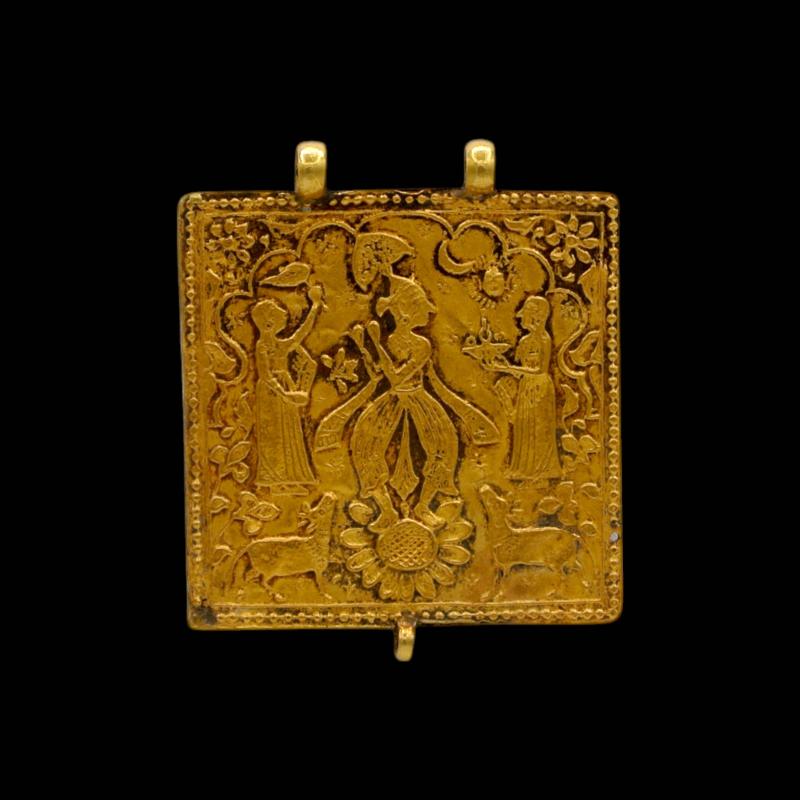
Pendete in lamina d¿oro
India, XVIII secolo
Piccolo pendente sbalzato con raffigurazione centrale di Krishna affiancato da due attendenti e stante sopra una base a fiore di loto. Corredato di tre asole di sospensione. Provenienza: Collezione privata Brescia.
A gold foil plated pendant
India, 18th century
Small embossed pendant with central depiction of Krishna flanked by two attendants and standing on a lotus flower base.
Provenance: Private collection, Brescia, Italy.
H. 5 X 4.5 cm
AGGIUDICATO

Radice di smeraldo Mogul montata ad anello
India settentrionale, XVIII secolo
Anello montato in oro bianco 18 K. con brillanti. Montatura anni ¿70 di Veschetti, Brescia, punzonato 750. La montatura racchiude una radice di smeraldo incisa con fiore centrale e petali sul lato.
Provenienza: Collezione privata Brescia. Mughal emerald root mounted as a ring
Northern India, 18th century
Ring mounted in 18 K. white gold with brilliants. 1970s mount by Veschetti, Brescia, hallmarked 750. The mount encloses an emerald root engraved with a central flower and petals on the side.
Provenance: Private collection, Brescia, Italy.
H. 4 X L. 3 cm

Fusione in bronzo raffigurante Durga Mahishasura Mardini
India Meridionale, XVIII secolo
Fusione raffigurante la divinità femminile nell¿atto di schiacciare il bufalo dal quale estrae il demone con la sua mano sinistra. Le due ani secondarie brandiscono due armi: il disco e la spada.Bronze casting depicting Durga Mahishasura Mardini
Southern India, 18th century
Cast bronze depicting the female deity overriding the buffalo from which she extracts the demon with her left hand. The two secondary hands brandish two weapons: the disc and the sword
5.5 X 4 X H. 9 cm

Vishnu in lega di rame
India Settentrionale, XVII secolo
Piccola fusione raffigurante la divinità stante su piccola base circolare. La figura ha quattro braccia (di cui una mancante): le due principali posizionate secondo i canonici mudra, la mano della secondaria rimasta brandisce la conchiglia.A copper alloy figure of Lord Vishnu
Northern India, 17th century
Small cast depicting the deity standing on a small circular base. The figure has four arms (one of which is now missing): the two main ones displaying mudras, the hand of the remaining secondary one wields the shell.
H. 8.5 cm
AGGIUDICATO
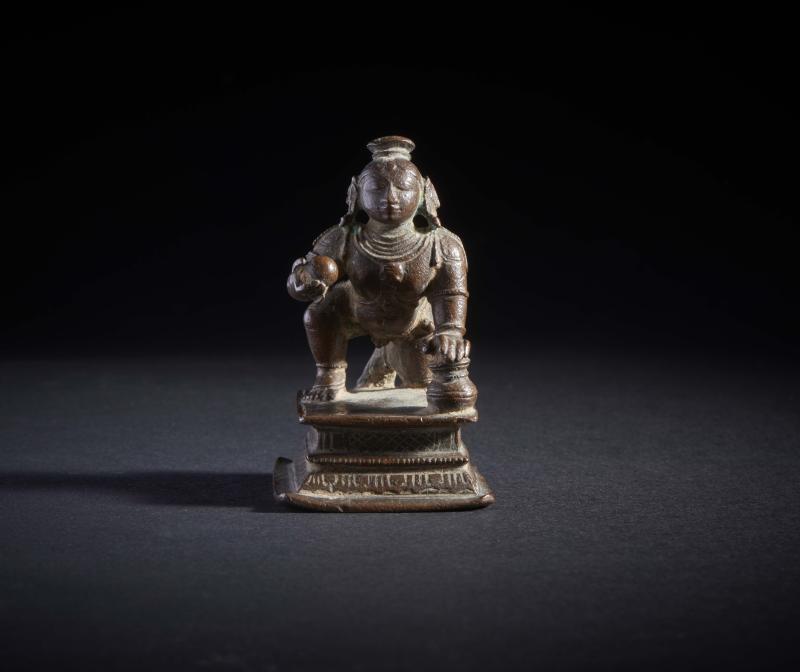
Balakrishna in bronzo
India Meridionale, XVII-XVIII secolo
Fusione in lega di rame raffigurante la divinità bambino a carponi su un plinto rettangolare. La sua mano destra regge la palla di burro, mentre la sinistra è poggiata sul barattolo dal quale l¿ha estratta. Belli i dettagli della cintura, del copricapo e dei gioielli.A bronze figure of Balakrishna
Southern India, 17th-18th century
Copper alloy casting depicting the child deity on all fours on a rectangular plinth. His right hand holds the butter ball, while his left hand is resting on the jar from which he has taken it. Beautiful details of the belt, headdress and jewellery.
4 X 5 X H. 7 cm
AGGIUDICATO

Annapurna in lega di rame
India Meridionale, XVII-XVIII secolo
Fusione in lega di rame raffigurante una delle manifestazioni di Parvati, seduta in mezzo fiore di loto su una base a più livelli. Con il suo attributo principale, il cucchiaio, la divinità dispensa cibo ai bisognosi. A copper alloy figure Annapurna
Southern India, 17th – 18th century
Copper alloy casting depicting one of the manifestations of Parvati, seated in half lotus position on a tiered base. With her main attribute, the spoon, she dispenses food to the needy.
H. 8 cm

Figura di Tripurasundari. India, XIX secolo
Fusione in bronzo raffigurante la divinità associata con lo Sri Yantra, sul quale siede con le gambe incrociate in padmasana. La sua mano sinistra reca come attributo l’arco prodotto dalla canna da zucchero.
A bronze figure of Tripurasundari
India, 19th century
Bronze casting depicting the deity associated with the Sri Yantra, on which he sits with her legs crossed in padmasana. Her left hand bears the sugarcane bow as an attribute.
5.2 X 5.2 X H. 10 cm
AGGIUDICATO
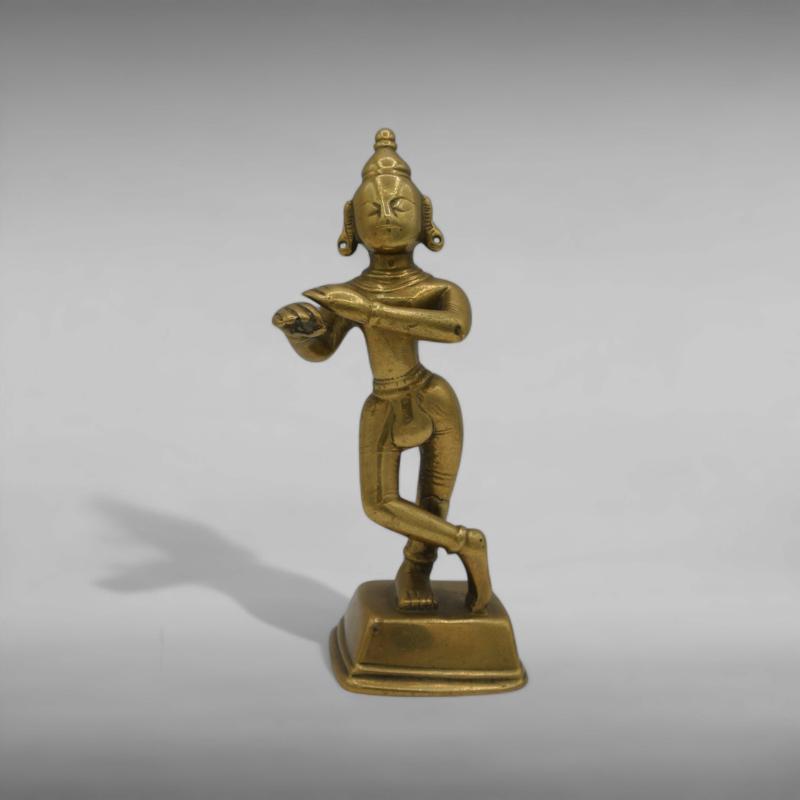
Krishna Venugopala
India Centro-Orientale, Orissa, XIX secolo
Fusione d¿ottone, raffigurante la divinità stante, le gambe incrociate e le braccia nell¿atto di suonare il flauto, ora mancante.
Krishna Venugopala North-Eastern
India, Orissa, 19th century
Brass casting, depicting the deity standing, legs crossed and arms in the act of playing the flute, now missing.
H. 13.8 X 4.9 X 4.7 cm
AGGIUDICATO

Altare Jain raffigurante Parshva assistito da quattro Thirtankara
India, Gujarat, Datato 1477 CE
Questo tipo di icona è noto come pancha-tirthika, un termine che si riferisce a una composizione che comprende cinque Jina: una figura centrale seduta circondata da quattro Thirtankaras più piccoli. La figura centrale è Parshva, il ventitreesimo Jina, come indica il cappuccio di serpente a sette teste sopra la sua testa. Le figure in piedi della composizione indossano abiti intorno ai fianchi, identificando cos’ la pala d’altare con la tradizione Svetambara.
Il thirtankara ha occhi intarsiati in argento. Lunga iscrizione incisa sul retro della prabha.
Jain altar depicting Parshva assisted by four Thirtankaras.
India, Gujarat, dated 1477 CE
This type of icon is known as pancha-tirthika, a term referring to a composition comprising five Jinas: a seated central figure surrounded by four smaller Thirtankaras. The central figure is Parshva, the twenty-third Jina, as indicated by the seven-headed serpent hood above his head. The standing figures in the composition wear robes around their hips, thus identifying the altarpiece with the Svetambara tradition.
The thirtankara has silver inlaid eyes. Long insciption engraved at the back of the prabha.
20.8 x 12.2 x 7.9 cm
AGGIUDICATO

Piccolo bronzo devozionale raffigurante Durga
India Centrale, XVIII secolo
fusione in bronzo a patina scura, raffigurante Durga Mahishasuramardini nell¿atto di sconfiggere il demone bufalo.
Small devotional bronze depicting Durga
Central India, 18th century
bronze casting with dark patina, depicting Durga Mahishasuramardini in the act of slaying the buffalo demon.
H. 5.5 X L. 3 cm

Figura di Krishna Venugopala
India Centrale, Orissa, XIX secolo
Raffinato bronzo devozionale raffigurante la divinità stante su un plinto quadrato, le gambe incrociate e le braccia nella posizione di suonare il flauto.
A copper alloy figure of Krishna Venugopala
Fine devotional bronze depicting the deity standing on a square plinth, legs crossed and arms in the position of playing the flute.
H. 13.5 cm
AGGIUDICATO
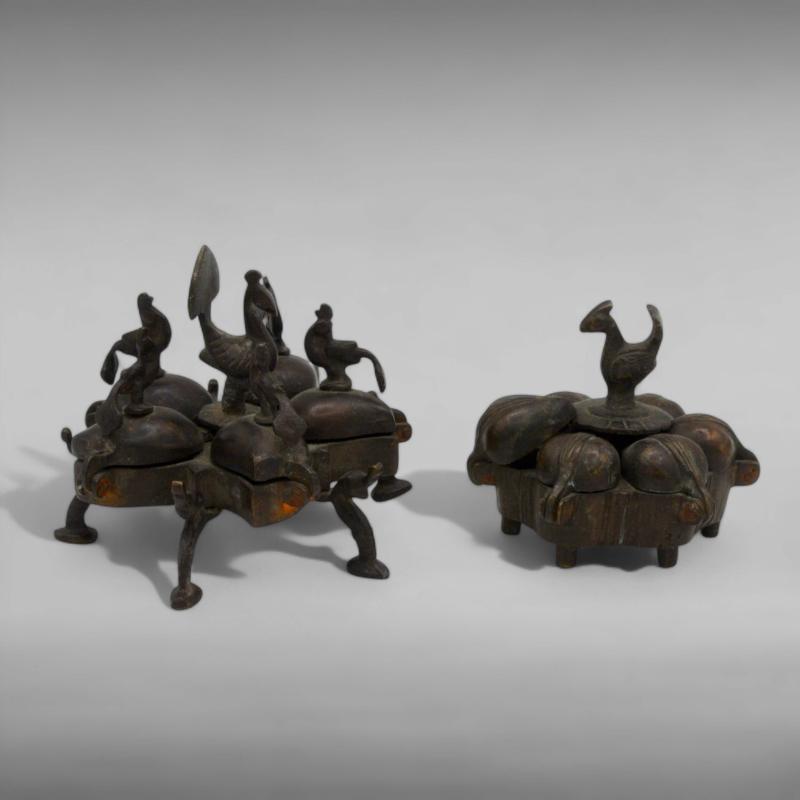
Due contenitori porta spezie o porta belletto in metallo
India, XIX secolo
Fusione in bronzo nella classica forma con perno centrale raffigurante pavone circondato da 5 contenitori con tappo a forma di mango sormontato da pavoni.
Two metal spice or kohl holders
India, 19th century
Bronze casting in the classic form with a central pivot shaped as a peacock surrounded by five containers with mango-shaped covers surmounted by peacocks.
H. 8.5 X 9 cm (the largest)

Bronzo raffigurante BalaKrishna
India Centrale, XIX secolo
Fusione in bronzo raffigurante Krishna seduto su una spira di serpente. Questa rappresentazione è legata a un episodio dell¿infanzia di Krishna in cui sconfisse il serpente Kaliya e poi si mise a succhiare il proprio alluce, mostrando la sua natura divina e giocosa.
Sul retro manca la testa del serpente che probabilmente fungeva da canopia.
Bronze depicting BalaKrishna
Central India, 19th century
Bronze casting depicting Krishna sitting on a snake coil. This representation is related to an episode from Krishna’s childhood when he defeated the serpent Kaliya and then sucked his own toe, showing his divine and playful nature. The back is missing the head of the snake, which probably served as a canopy.
H. 9.3 X 8 cm

Figura in bronzo raffigurante Karttikeya sul pavone
India, tardo XIX secolo
Bronze figure of Karttikeya on the peacock
India, late 19th century
H 11.3 X L. 10.5 cm

LOTTO RITIRATO
Grande scultura raffigurante un cavallo India settentrionale, Rajasthan, XIX secolo
Imponente e decorativo cavallo in legno ricoperto di lamina di rame ed ottone sbalzata ed incisa in stile mimetico a simulare la criniera ed i finimenti equestri decorati con motivi floreali. Piccoli campanelli multipli costellano la superficie.
LOT WITHDRAWN
A highly decorative large wooden horse coated with embossed and engraved copper sheet
Northern India, Rajasthan, 19th century
A massive wooden horse coated with an embossed metal sheet engraved in a lifelike style to evoke the mane and the harnesses decorated with minute floral motifs and small multiple bells.
H. 140 X l. 117 X P. 25 cm

Scultura in pietra raffigurante divinità minore
India, XII-XIII secolo
Parte di decorazione secondaria di un palazzo in pietra arenaria con cospicue tracce policrome, raffigurante un personaggio incoronato con un vaso portato al petto con le mani giunte. Il personaggio è circondato da una corolla di petali di loto che ne forma la base tonda.
Sandstone sculpture depicting a minor deity
India, 12th-13th century
Part of a secondary decoration of a palace, depicting a crowned character holding a vase to his chest with folded hands. The figure is surrounded by a corolla of lotus petals forming the round base.
31 X 31 cm
